Financial Ratio and BEP Analysis Report
VerifiedAdded on 2022/08/22
|40
|9840
|17
AI Summary
Contribute Materials
Your contribution can guide someone’s learning journey. Share your
documents today.
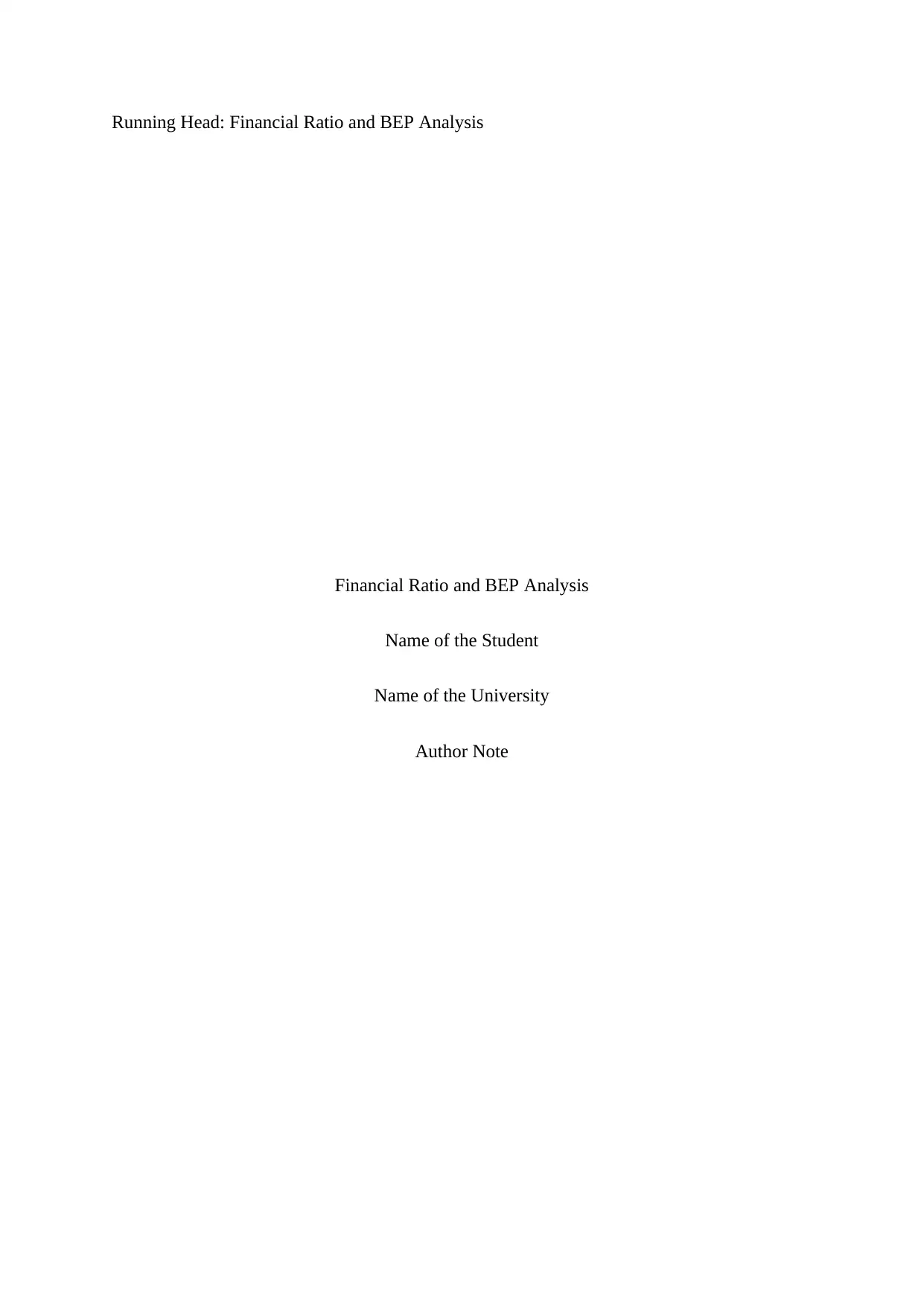
Running Head: Financial Ratio and BEP Analysis
Financial Ratio and BEP Analysis
Name of the Student
Name of the University
Author Note
Financial Ratio and BEP Analysis
Name of the Student
Name of the University
Author Note
Secure Best Marks with AI Grader
Need help grading? Try our AI Grader for instant feedback on your assignments.
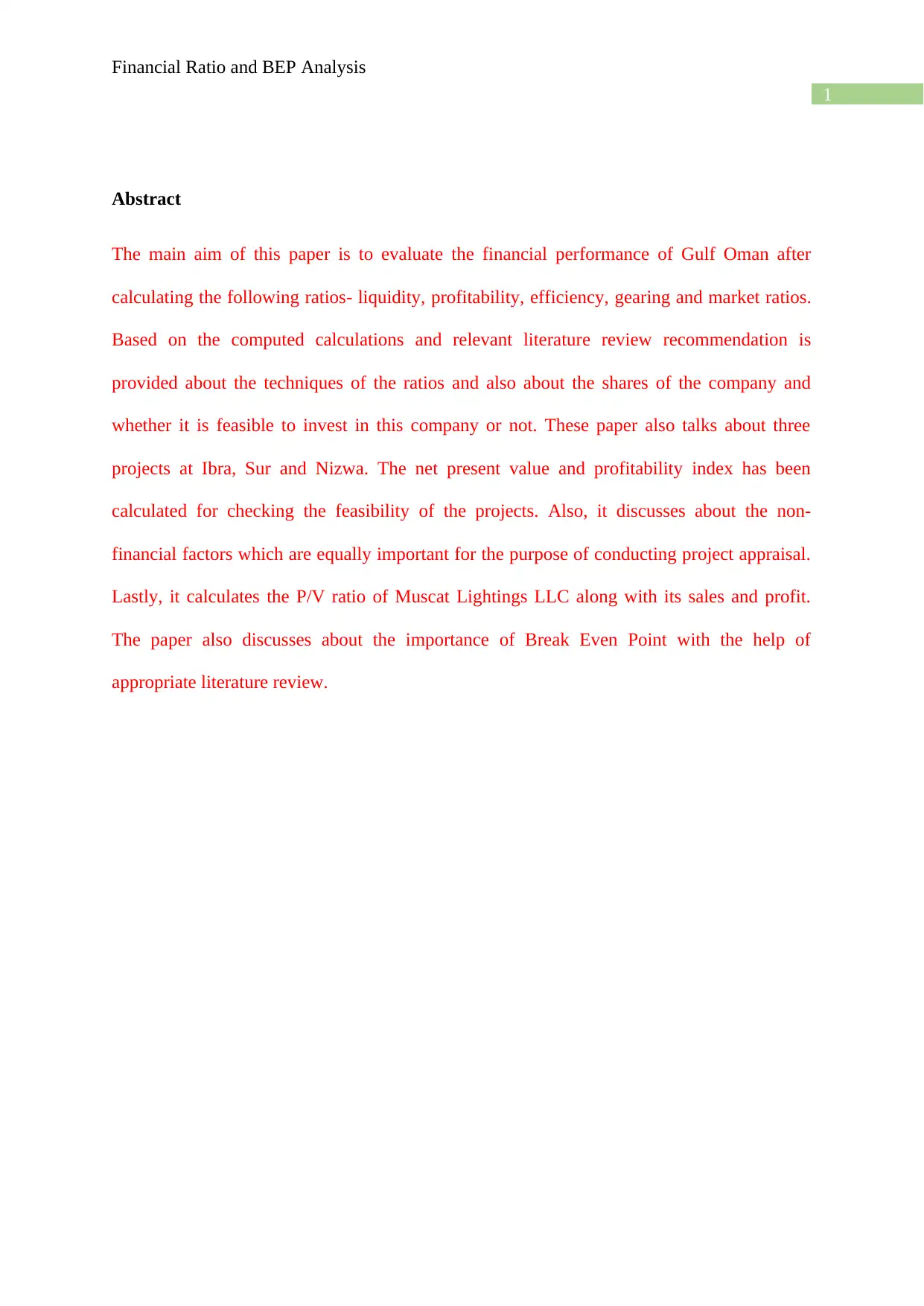
1
Financial Ratio and BEP Analysis
Abstract
The main aim of this paper is to evaluate the financial performance of Gulf Oman after
calculating the following ratios- liquidity, profitability, efficiency, gearing and market ratios.
Based on the computed calculations and relevant literature review recommendation is
provided about the techniques of the ratios and also about the shares of the company and
whether it is feasible to invest in this company or not. These paper also talks about three
projects at Ibra, Sur and Nizwa. The net present value and profitability index has been
calculated for checking the feasibility of the projects. Also, it discusses about the non-
financial factors which are equally important for the purpose of conducting project appraisal.
Lastly, it calculates the P/V ratio of Muscat Lightings LLC along with its sales and profit.
The paper also discusses about the importance of Break Even Point with the help of
appropriate literature review.
Financial Ratio and BEP Analysis
Abstract
The main aim of this paper is to evaluate the financial performance of Gulf Oman after
calculating the following ratios- liquidity, profitability, efficiency, gearing and market ratios.
Based on the computed calculations and relevant literature review recommendation is
provided about the techniques of the ratios and also about the shares of the company and
whether it is feasible to invest in this company or not. These paper also talks about three
projects at Ibra, Sur and Nizwa. The net present value and profitability index has been
calculated for checking the feasibility of the projects. Also, it discusses about the non-
financial factors which are equally important for the purpose of conducting project appraisal.
Lastly, it calculates the P/V ratio of Muscat Lightings LLC along with its sales and profit.
The paper also discusses about the importance of Break Even Point with the help of
appropriate literature review.
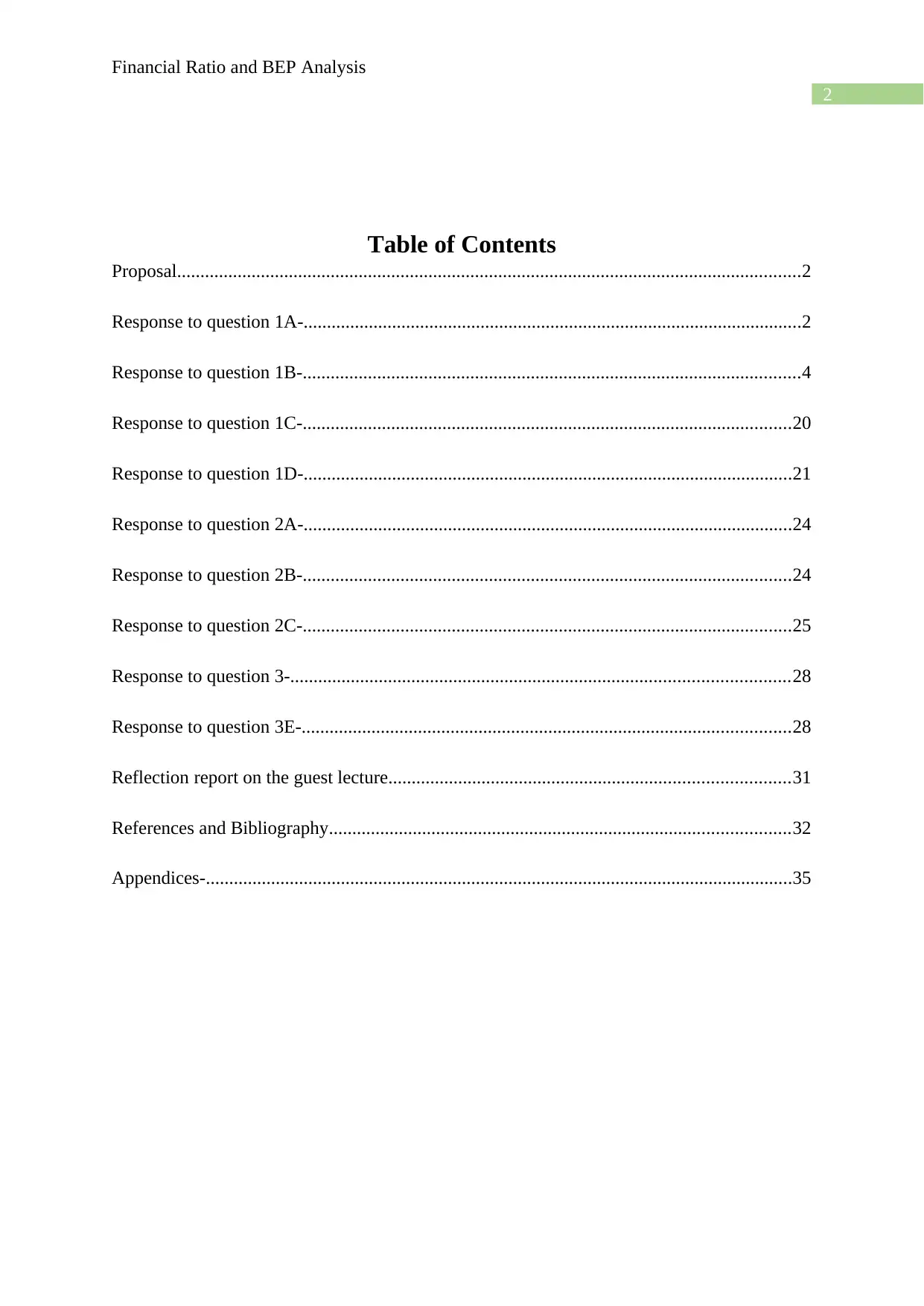
2
Financial Ratio and BEP Analysis
Table of Contents
Proposal......................................................................................................................................2
Response to question 1A-...........................................................................................................2
Response to question 1B-...........................................................................................................4
Response to question 1C-.........................................................................................................20
Response to question 1D-.........................................................................................................21
Response to question 2A-.........................................................................................................24
Response to question 2B-.........................................................................................................24
Response to question 2C-.........................................................................................................25
Response to question 3-...........................................................................................................28
Response to question 3E-.........................................................................................................28
Reflection report on the guest lecture......................................................................................31
References and Bibliography...................................................................................................32
Appendices-..............................................................................................................................35
Financial Ratio and BEP Analysis
Table of Contents
Proposal......................................................................................................................................2
Response to question 1A-...........................................................................................................2
Response to question 1B-...........................................................................................................4
Response to question 1C-.........................................................................................................20
Response to question 1D-.........................................................................................................21
Response to question 2A-.........................................................................................................24
Response to question 2B-.........................................................................................................24
Response to question 2C-.........................................................................................................25
Response to question 3-...........................................................................................................28
Response to question 3E-.........................................................................................................28
Reflection report on the guest lecture......................................................................................31
References and Bibliography...................................................................................................32
Appendices-..............................................................................................................................35
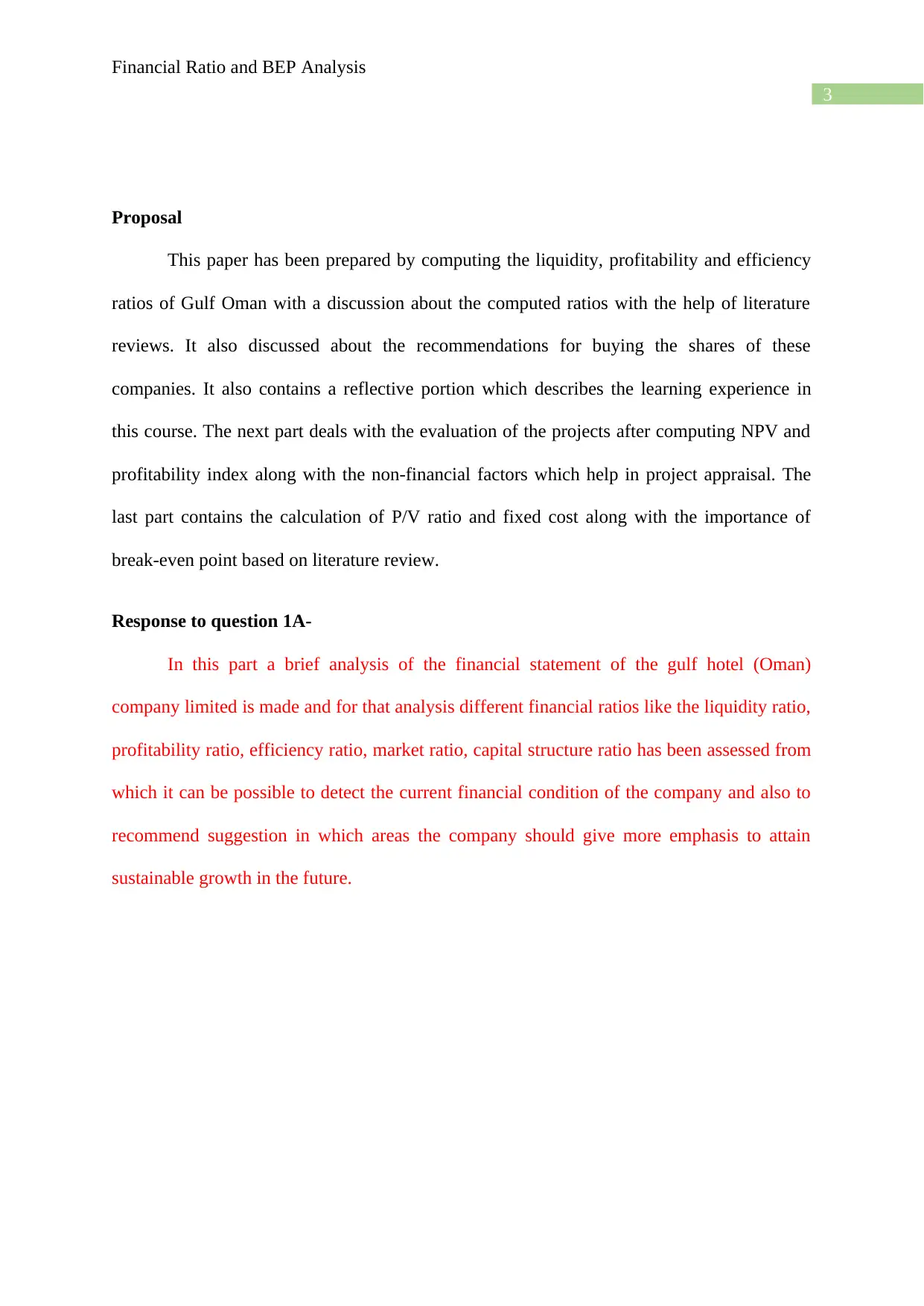
3
Financial Ratio and BEP Analysis
Proposal
This paper has been prepared by computing the liquidity, profitability and efficiency
ratios of Gulf Oman with a discussion about the computed ratios with the help of literature
reviews. It also discussed about the recommendations for buying the shares of these
companies. It also contains a reflective portion which describes the learning experience in
this course. The next part deals with the evaluation of the projects after computing NPV and
profitability index along with the non-financial factors which help in project appraisal. The
last part contains the calculation of P/V ratio and fixed cost along with the importance of
break-even point based on literature review.
Response to question 1A-
In this part a brief analysis of the financial statement of the gulf hotel (Oman)
company limited is made and for that analysis different financial ratios like the liquidity ratio,
profitability ratio, efficiency ratio, market ratio, capital structure ratio has been assessed from
which it can be possible to detect the current financial condition of the company and also to
recommend suggestion in which areas the company should give more emphasis to attain
sustainable growth in the future.
Financial Ratio and BEP Analysis
Proposal
This paper has been prepared by computing the liquidity, profitability and efficiency
ratios of Gulf Oman with a discussion about the computed ratios with the help of literature
reviews. It also discussed about the recommendations for buying the shares of these
companies. It also contains a reflective portion which describes the learning experience in
this course. The next part deals with the evaluation of the projects after computing NPV and
profitability index along with the non-financial factors which help in project appraisal. The
last part contains the calculation of P/V ratio and fixed cost along with the importance of
break-even point based on literature review.
Response to question 1A-
In this part a brief analysis of the financial statement of the gulf hotel (Oman)
company limited is made and for that analysis different financial ratios like the liquidity ratio,
profitability ratio, efficiency ratio, market ratio, capital structure ratio has been assessed from
which it can be possible to detect the current financial condition of the company and also to
recommend suggestion in which areas the company should give more emphasis to attain
sustainable growth in the future.
Secure Best Marks with AI Grader
Need help grading? Try our AI Grader for instant feedback on your assignments.
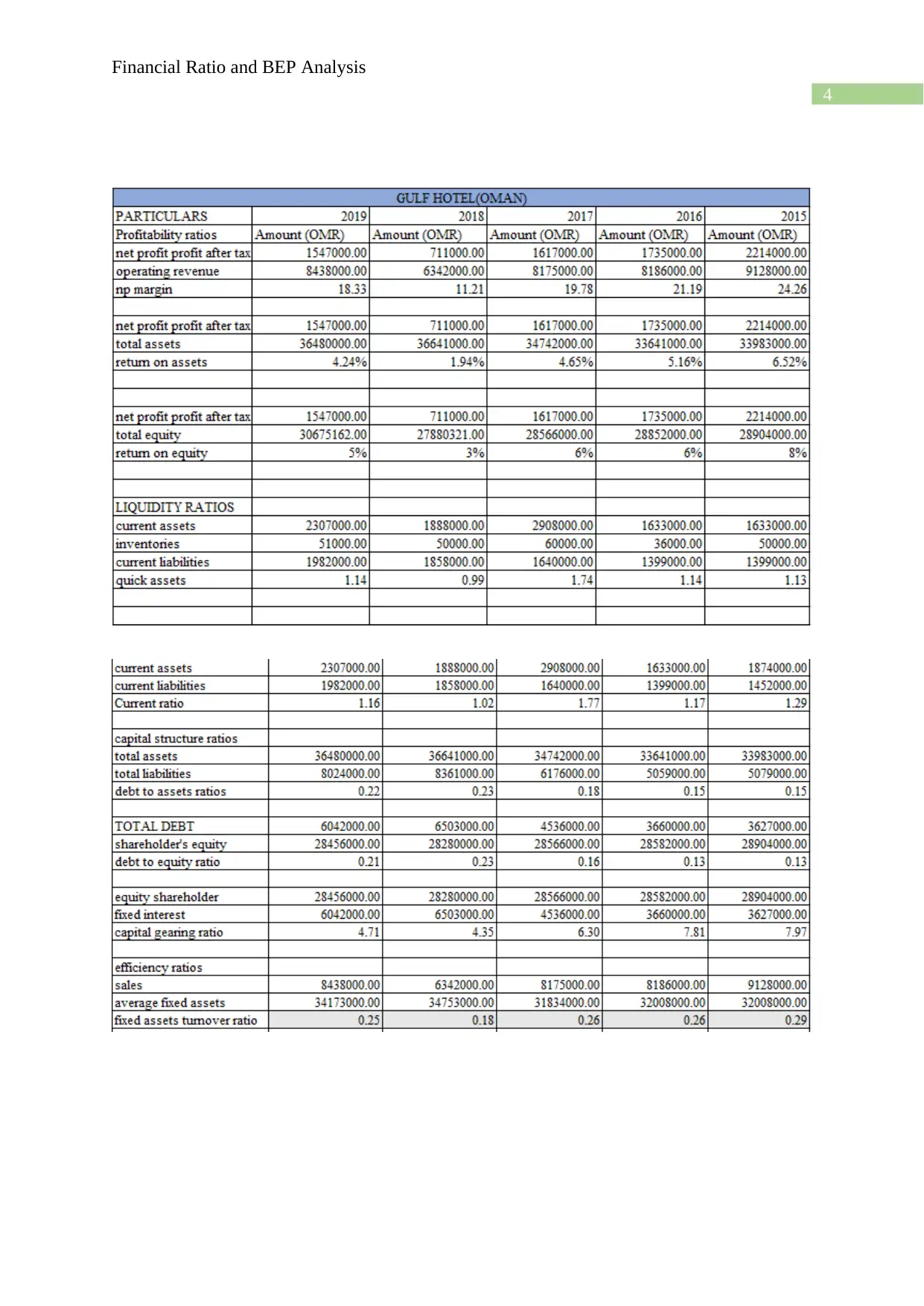
4
Financial Ratio and BEP Analysis
Financial Ratio and BEP Analysis
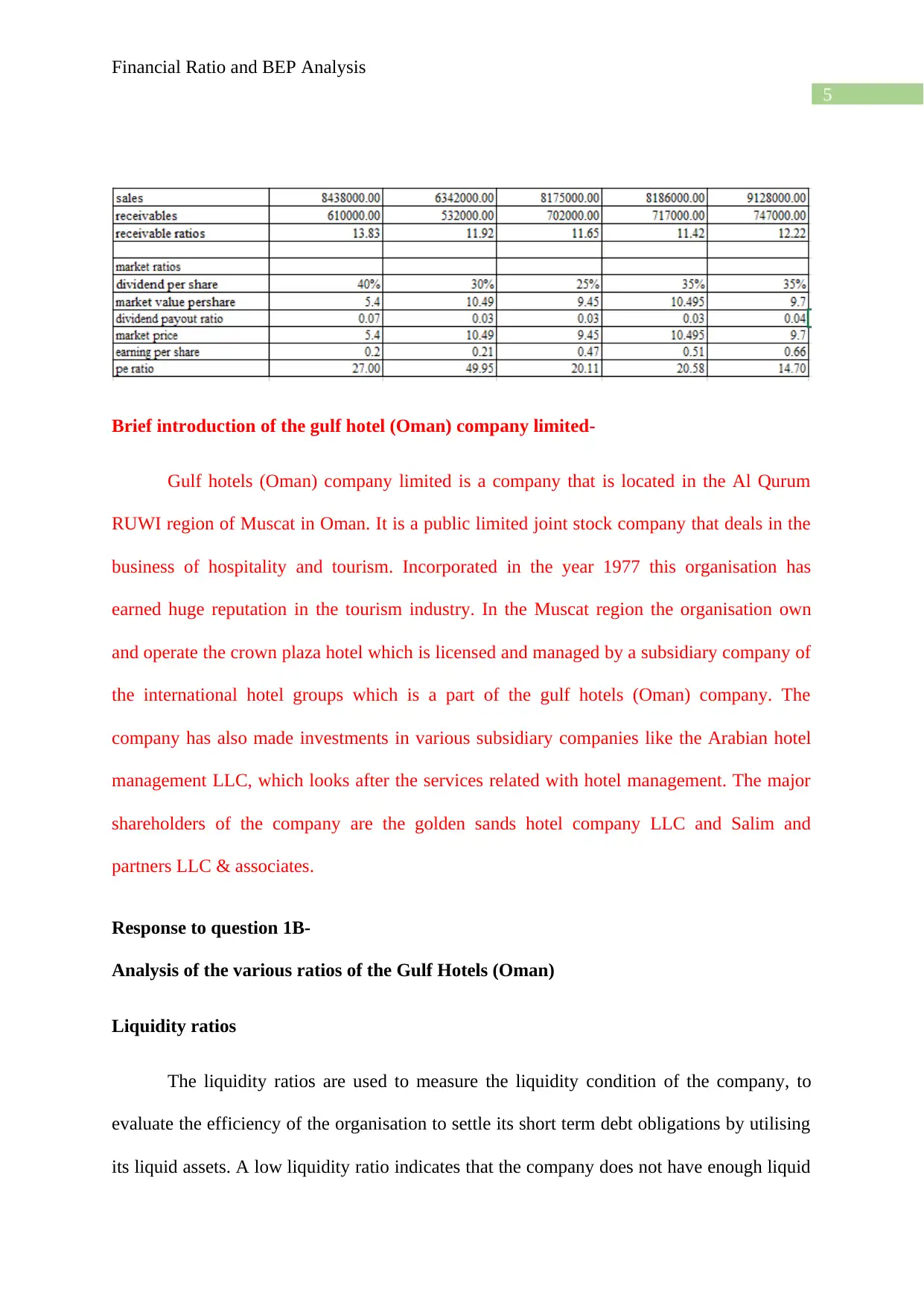
5
Financial Ratio and BEP Analysis
Brief introduction of the gulf hotel (Oman) company limited-
Gulf hotels (Oman) company limited is a company that is located in the Al Qurum
RUWI region of Muscat in Oman. It is a public limited joint stock company that deals in the
business of hospitality and tourism. Incorporated in the year 1977 this organisation has
earned huge reputation in the tourism industry. In the Muscat region the organisation own
and operate the crown plaza hotel which is licensed and managed by a subsidiary company of
the international hotel groups which is a part of the gulf hotels (Oman) company. The
company has also made investments in various subsidiary companies like the Arabian hotel
management LLC, which looks after the services related with hotel management. The major
shareholders of the company are the golden sands hotel company LLC and Salim and
partners LLC & associates.
Response to question 1B-
Analysis of the various ratios of the Gulf Hotels (Oman)
Liquidity ratios
The liquidity ratios are used to measure the liquidity condition of the company, to
evaluate the efficiency of the organisation to settle its short term debt obligations by utilising
its liquid assets. A low liquidity ratio indicates that the company does not have enough liquid
Financial Ratio and BEP Analysis
Brief introduction of the gulf hotel (Oman) company limited-
Gulf hotels (Oman) company limited is a company that is located in the Al Qurum
RUWI region of Muscat in Oman. It is a public limited joint stock company that deals in the
business of hospitality and tourism. Incorporated in the year 1977 this organisation has
earned huge reputation in the tourism industry. In the Muscat region the organisation own
and operate the crown plaza hotel which is licensed and managed by a subsidiary company of
the international hotel groups which is a part of the gulf hotels (Oman) company. The
company has also made investments in various subsidiary companies like the Arabian hotel
management LLC, which looks after the services related with hotel management. The major
shareholders of the company are the golden sands hotel company LLC and Salim and
partners LLC & associates.
Response to question 1B-
Analysis of the various ratios of the Gulf Hotels (Oman)
Liquidity ratios
The liquidity ratios are used to measure the liquidity condition of the company, to
evaluate the efficiency of the organisation to settle its short term debt obligations by utilising
its liquid assets. A low liquidity ratio indicates that the company does not have enough liquid
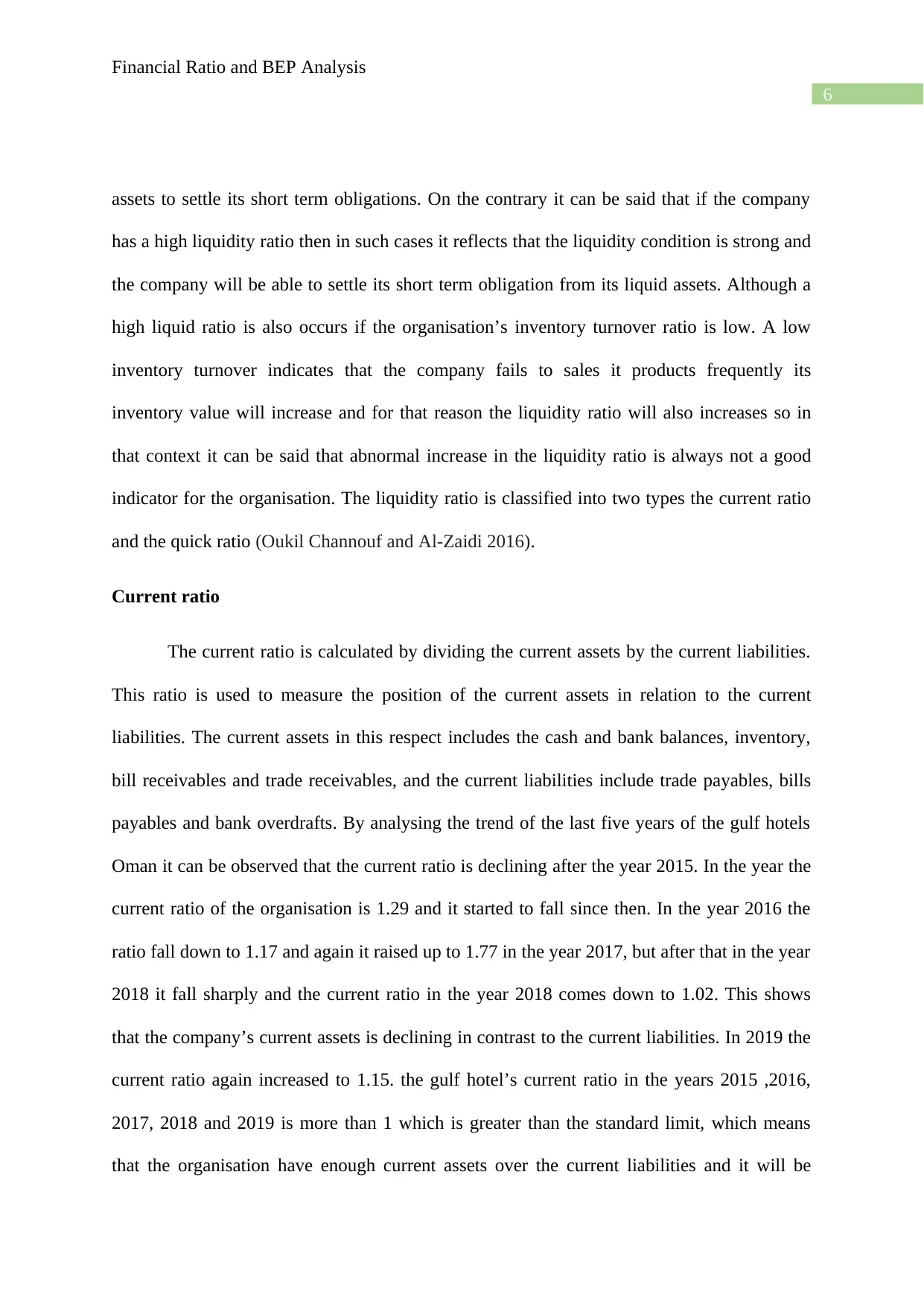
6
Financial Ratio and BEP Analysis
assets to settle its short term obligations. On the contrary it can be said that if the company
has a high liquidity ratio then in such cases it reflects that the liquidity condition is strong and
the company will be able to settle its short term obligation from its liquid assets. Although a
high liquid ratio is also occurs if the organisation’s inventory turnover ratio is low. A low
inventory turnover indicates that the company fails to sales it products frequently its
inventory value will increase and for that reason the liquidity ratio will also increases so in
that context it can be said that abnormal increase in the liquidity ratio is always not a good
indicator for the organisation. The liquidity ratio is classified into two types the current ratio
and the quick ratio (Oukil Channouf and Al-Zaidi 2016).
Current ratio
The current ratio is calculated by dividing the current assets by the current liabilities.
This ratio is used to measure the position of the current assets in relation to the current
liabilities. The current assets in this respect includes the cash and bank balances, inventory,
bill receivables and trade receivables, and the current liabilities include trade payables, bills
payables and bank overdrafts. By analysing the trend of the last five years of the gulf hotels
Oman it can be observed that the current ratio is declining after the year 2015. In the year the
current ratio of the organisation is 1.29 and it started to fall since then. In the year 2016 the
ratio fall down to 1.17 and again it raised up to 1.77 in the year 2017, but after that in the year
2018 it fall sharply and the current ratio in the year 2018 comes down to 1.02. This shows
that the company’s current assets is declining in contrast to the current liabilities. In 2019 the
current ratio again increased to 1.15. the gulf hotel’s current ratio in the years 2015 ,2016,
2017, 2018 and 2019 is more than 1 which is greater than the standard limit, which means
that the organisation have enough current assets over the current liabilities and it will be
Financial Ratio and BEP Analysis
assets to settle its short term obligations. On the contrary it can be said that if the company
has a high liquidity ratio then in such cases it reflects that the liquidity condition is strong and
the company will be able to settle its short term obligation from its liquid assets. Although a
high liquid ratio is also occurs if the organisation’s inventory turnover ratio is low. A low
inventory turnover indicates that the company fails to sales it products frequently its
inventory value will increase and for that reason the liquidity ratio will also increases so in
that context it can be said that abnormal increase in the liquidity ratio is always not a good
indicator for the organisation. The liquidity ratio is classified into two types the current ratio
and the quick ratio (Oukil Channouf and Al-Zaidi 2016).
Current ratio
The current ratio is calculated by dividing the current assets by the current liabilities.
This ratio is used to measure the position of the current assets in relation to the current
liabilities. The current assets in this respect includes the cash and bank balances, inventory,
bill receivables and trade receivables, and the current liabilities include trade payables, bills
payables and bank overdrafts. By analysing the trend of the last five years of the gulf hotels
Oman it can be observed that the current ratio is declining after the year 2015. In the year the
current ratio of the organisation is 1.29 and it started to fall since then. In the year 2016 the
ratio fall down to 1.17 and again it raised up to 1.77 in the year 2017, but after that in the year
2018 it fall sharply and the current ratio in the year 2018 comes down to 1.02. This shows
that the company’s current assets is declining in contrast to the current liabilities. In 2019 the
current ratio again increased to 1.15. the gulf hotel’s current ratio in the years 2015 ,2016,
2017, 2018 and 2019 is more than 1 which is greater than the standard limit, which means
that the organisation have enough current assets over the current liabilities and it will be
Paraphrase This Document
Need a fresh take? Get an instant paraphrase of this document with our AI Paraphraser
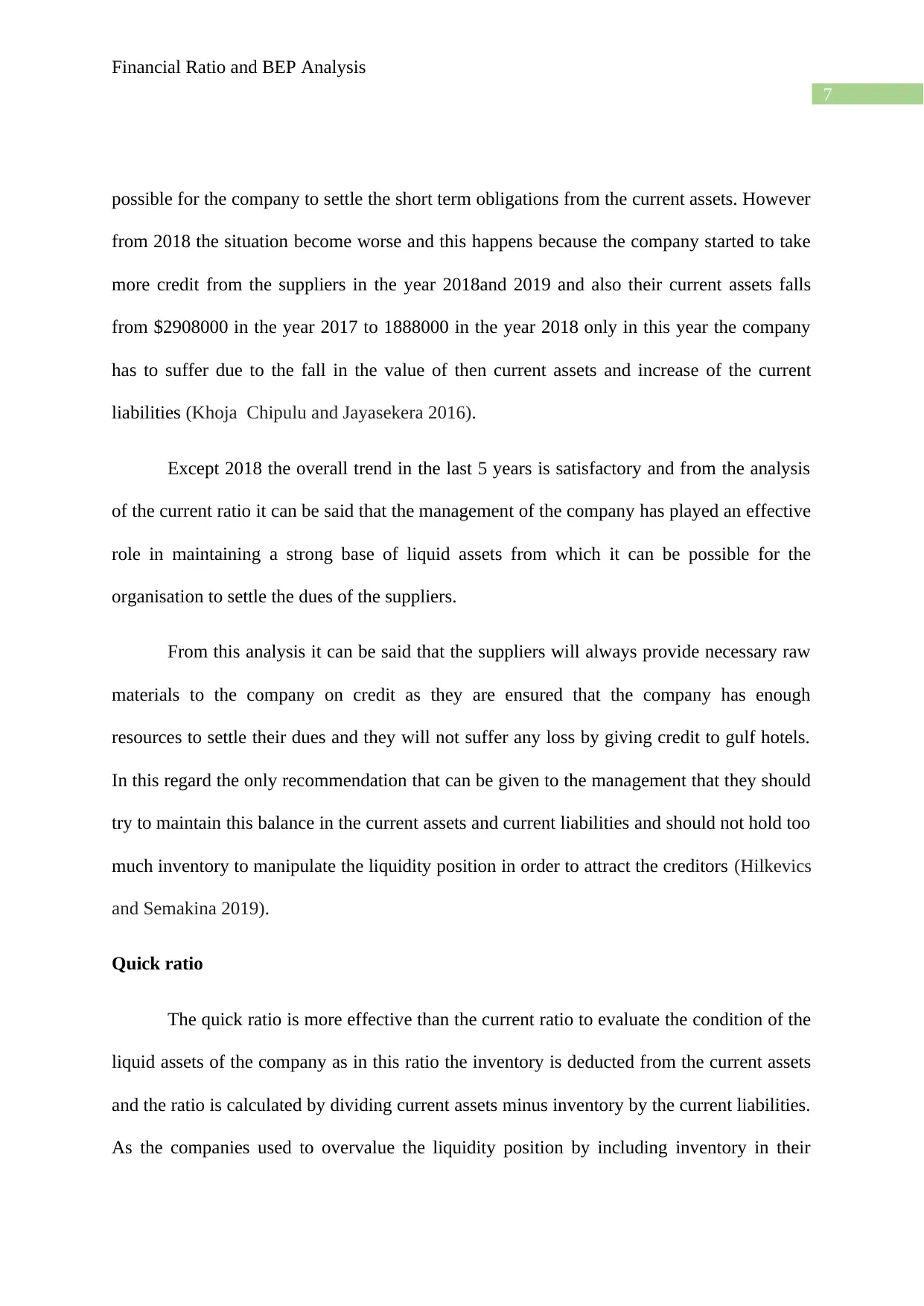
7
Financial Ratio and BEP Analysis
possible for the company to settle the short term obligations from the current assets. However
from 2018 the situation become worse and this happens because the company started to take
more credit from the suppliers in the year 2018and 2019 and also their current assets falls
from $2908000 in the year 2017 to 1888000 in the year 2018 only in this year the company
has to suffer due to the fall in the value of then current assets and increase of the current
liabilities (Khoja Chipulu and Jayasekera 2016).
Except 2018 the overall trend in the last 5 years is satisfactory and from the analysis
of the current ratio it can be said that the management of the company has played an effective
role in maintaining a strong base of liquid assets from which it can be possible for the
organisation to settle the dues of the suppliers.
From this analysis it can be said that the suppliers will always provide necessary raw
materials to the company on credit as they are ensured that the company has enough
resources to settle their dues and they will not suffer any loss by giving credit to gulf hotels.
In this regard the only recommendation that can be given to the management that they should
try to maintain this balance in the current assets and current liabilities and should not hold too
much inventory to manipulate the liquidity position in order to attract the creditors (Hilkevics
and Semakina 2019).
Quick ratio
The quick ratio is more effective than the current ratio to evaluate the condition of the
liquid assets of the company as in this ratio the inventory is deducted from the current assets
and the ratio is calculated by dividing current assets minus inventory by the current liabilities.
As the companies used to overvalue the liquidity position by including inventory in their
Financial Ratio and BEP Analysis
possible for the company to settle the short term obligations from the current assets. However
from 2018 the situation become worse and this happens because the company started to take
more credit from the suppliers in the year 2018and 2019 and also their current assets falls
from $2908000 in the year 2017 to 1888000 in the year 2018 only in this year the company
has to suffer due to the fall in the value of then current assets and increase of the current
liabilities (Khoja Chipulu and Jayasekera 2016).
Except 2018 the overall trend in the last 5 years is satisfactory and from the analysis
of the current ratio it can be said that the management of the company has played an effective
role in maintaining a strong base of liquid assets from which it can be possible for the
organisation to settle the dues of the suppliers.
From this analysis it can be said that the suppliers will always provide necessary raw
materials to the company on credit as they are ensured that the company has enough
resources to settle their dues and they will not suffer any loss by giving credit to gulf hotels.
In this regard the only recommendation that can be given to the management that they should
try to maintain this balance in the current assets and current liabilities and should not hold too
much inventory to manipulate the liquidity position in order to attract the creditors (Hilkevics
and Semakina 2019).
Quick ratio
The quick ratio is more effective than the current ratio to evaluate the condition of the
liquid assets of the company as in this ratio the inventory is deducted from the current assets
and the ratio is calculated by dividing current assets minus inventory by the current liabilities.
As the companies used to overvalue the liquidity position by including inventory in their
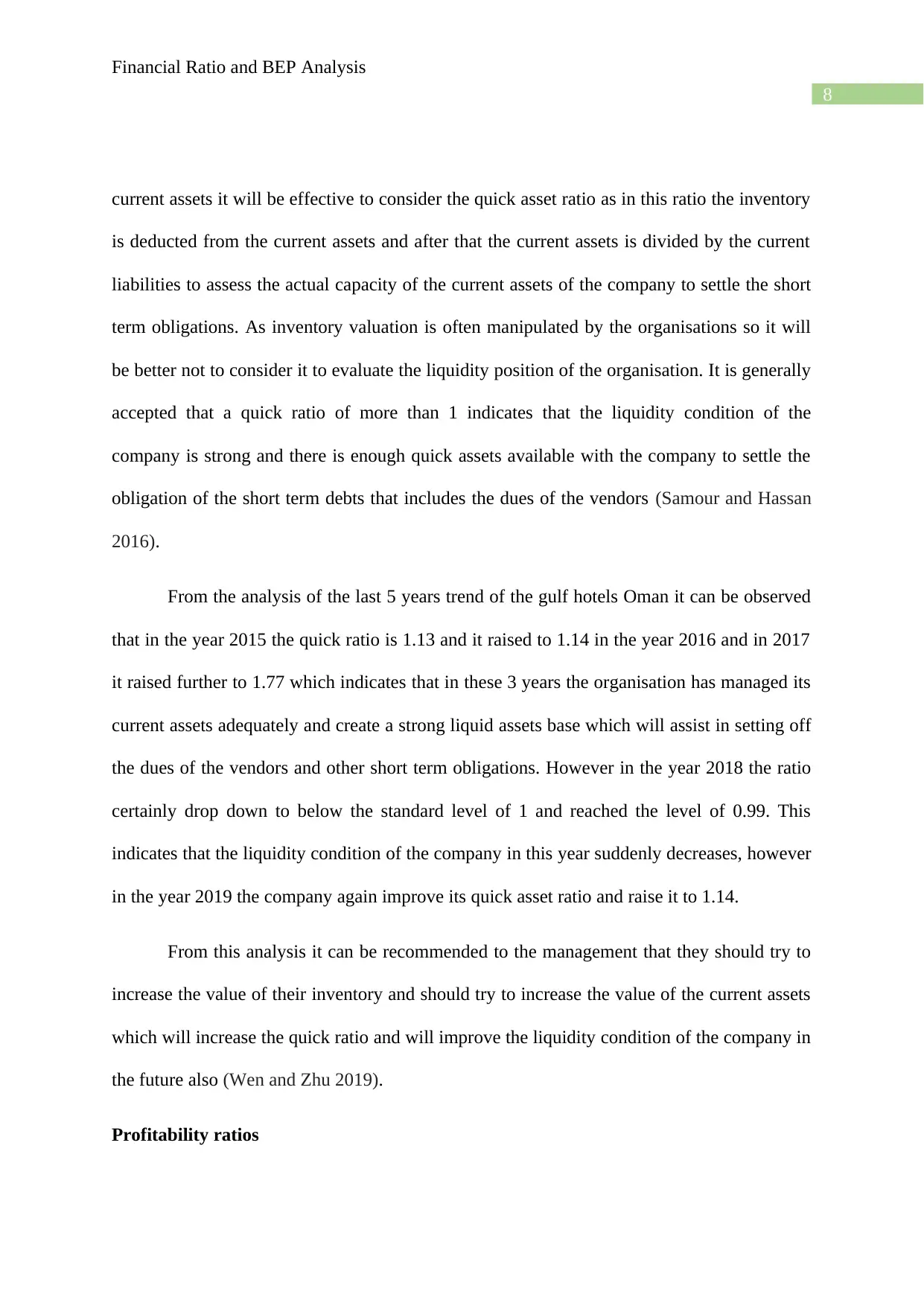
8
Financial Ratio and BEP Analysis
current assets it will be effective to consider the quick asset ratio as in this ratio the inventory
is deducted from the current assets and after that the current assets is divided by the current
liabilities to assess the actual capacity of the current assets of the company to settle the short
term obligations. As inventory valuation is often manipulated by the organisations so it will
be better not to consider it to evaluate the liquidity position of the organisation. It is generally
accepted that a quick ratio of more than 1 indicates that the liquidity condition of the
company is strong and there is enough quick assets available with the company to settle the
obligation of the short term debts that includes the dues of the vendors (Samour and Hassan
2016).
From the analysis of the last 5 years trend of the gulf hotels Oman it can be observed
that in the year 2015 the quick ratio is 1.13 and it raised to 1.14 in the year 2016 and in 2017
it raised further to 1.77 which indicates that in these 3 years the organisation has managed its
current assets adequately and create a strong liquid assets base which will assist in setting off
the dues of the vendors and other short term obligations. However in the year 2018 the ratio
certainly drop down to below the standard level of 1 and reached the level of 0.99. This
indicates that the liquidity condition of the company in this year suddenly decreases, however
in the year 2019 the company again improve its quick asset ratio and raise it to 1.14.
From this analysis it can be recommended to the management that they should try to
increase the value of their inventory and should try to increase the value of the current assets
which will increase the quick ratio and will improve the liquidity condition of the company in
the future also (Wen and Zhu 2019).
Profitability ratios
Financial Ratio and BEP Analysis
current assets it will be effective to consider the quick asset ratio as in this ratio the inventory
is deducted from the current assets and after that the current assets is divided by the current
liabilities to assess the actual capacity of the current assets of the company to settle the short
term obligations. As inventory valuation is often manipulated by the organisations so it will
be better not to consider it to evaluate the liquidity position of the organisation. It is generally
accepted that a quick ratio of more than 1 indicates that the liquidity condition of the
company is strong and there is enough quick assets available with the company to settle the
obligation of the short term debts that includes the dues of the vendors (Samour and Hassan
2016).
From the analysis of the last 5 years trend of the gulf hotels Oman it can be observed
that in the year 2015 the quick ratio is 1.13 and it raised to 1.14 in the year 2016 and in 2017
it raised further to 1.77 which indicates that in these 3 years the organisation has managed its
current assets adequately and create a strong liquid assets base which will assist in setting off
the dues of the vendors and other short term obligations. However in the year 2018 the ratio
certainly drop down to below the standard level of 1 and reached the level of 0.99. This
indicates that the liquidity condition of the company in this year suddenly decreases, however
in the year 2019 the company again improve its quick asset ratio and raise it to 1.14.
From this analysis it can be recommended to the management that they should try to
increase the value of their inventory and should try to increase the value of the current assets
which will increase the quick ratio and will improve the liquidity condition of the company in
the future also (Wen and Zhu 2019).
Profitability ratios
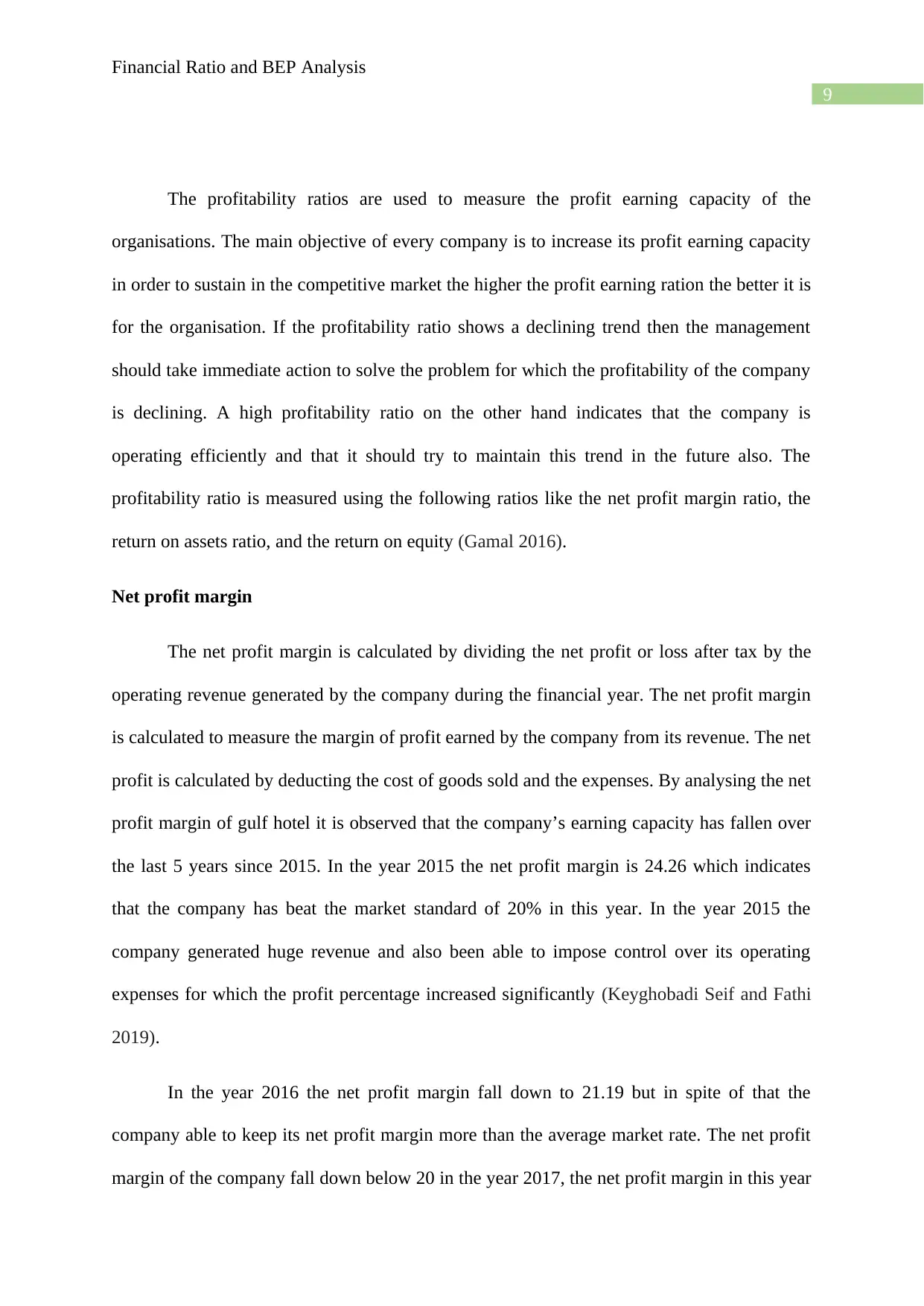
9
Financial Ratio and BEP Analysis
The profitability ratios are used to measure the profit earning capacity of the
organisations. The main objective of every company is to increase its profit earning capacity
in order to sustain in the competitive market the higher the profit earning ration the better it is
for the organisation. If the profitability ratio shows a declining trend then the management
should take immediate action to solve the problem for which the profitability of the company
is declining. A high profitability ratio on the other hand indicates that the company is
operating efficiently and that it should try to maintain this trend in the future also. The
profitability ratio is measured using the following ratios like the net profit margin ratio, the
return on assets ratio, and the return on equity (Gamal 2016).
Net profit margin
The net profit margin is calculated by dividing the net profit or loss after tax by the
operating revenue generated by the company during the financial year. The net profit margin
is calculated to measure the margin of profit earned by the company from its revenue. The net
profit is calculated by deducting the cost of goods sold and the expenses. By analysing the net
profit margin of gulf hotel it is observed that the company’s earning capacity has fallen over
the last 5 years since 2015. In the year 2015 the net profit margin is 24.26 which indicates
that the company has beat the market standard of 20% in this year. In the year 2015 the
company generated huge revenue and also been able to impose control over its operating
expenses for which the profit percentage increased significantly (Keyghobadi Seif and Fathi
2019).
In the year 2016 the net profit margin fall down to 21.19 but in spite of that the
company able to keep its net profit margin more than the average market rate. The net profit
margin of the company fall down below 20 in the year 2017, the net profit margin in this year
Financial Ratio and BEP Analysis
The profitability ratios are used to measure the profit earning capacity of the
organisations. The main objective of every company is to increase its profit earning capacity
in order to sustain in the competitive market the higher the profit earning ration the better it is
for the organisation. If the profitability ratio shows a declining trend then the management
should take immediate action to solve the problem for which the profitability of the company
is declining. A high profitability ratio on the other hand indicates that the company is
operating efficiently and that it should try to maintain this trend in the future also. The
profitability ratio is measured using the following ratios like the net profit margin ratio, the
return on assets ratio, and the return on equity (Gamal 2016).
Net profit margin
The net profit margin is calculated by dividing the net profit or loss after tax by the
operating revenue generated by the company during the financial year. The net profit margin
is calculated to measure the margin of profit earned by the company from its revenue. The net
profit is calculated by deducting the cost of goods sold and the expenses. By analysing the net
profit margin of gulf hotel it is observed that the company’s earning capacity has fallen over
the last 5 years since 2015. In the year 2015 the net profit margin is 24.26 which indicates
that the company has beat the market standard of 20% in this year. In the year 2015 the
company generated huge revenue and also been able to impose control over its operating
expenses for which the profit percentage increased significantly (Keyghobadi Seif and Fathi
2019).
In the year 2016 the net profit margin fall down to 21.19 but in spite of that the
company able to keep its net profit margin more than the average market rate. The net profit
margin of the company fall down below 20 in the year 2017, the net profit margin in this year
Secure Best Marks with AI Grader
Need help grading? Try our AI Grader for instant feedback on your assignments.
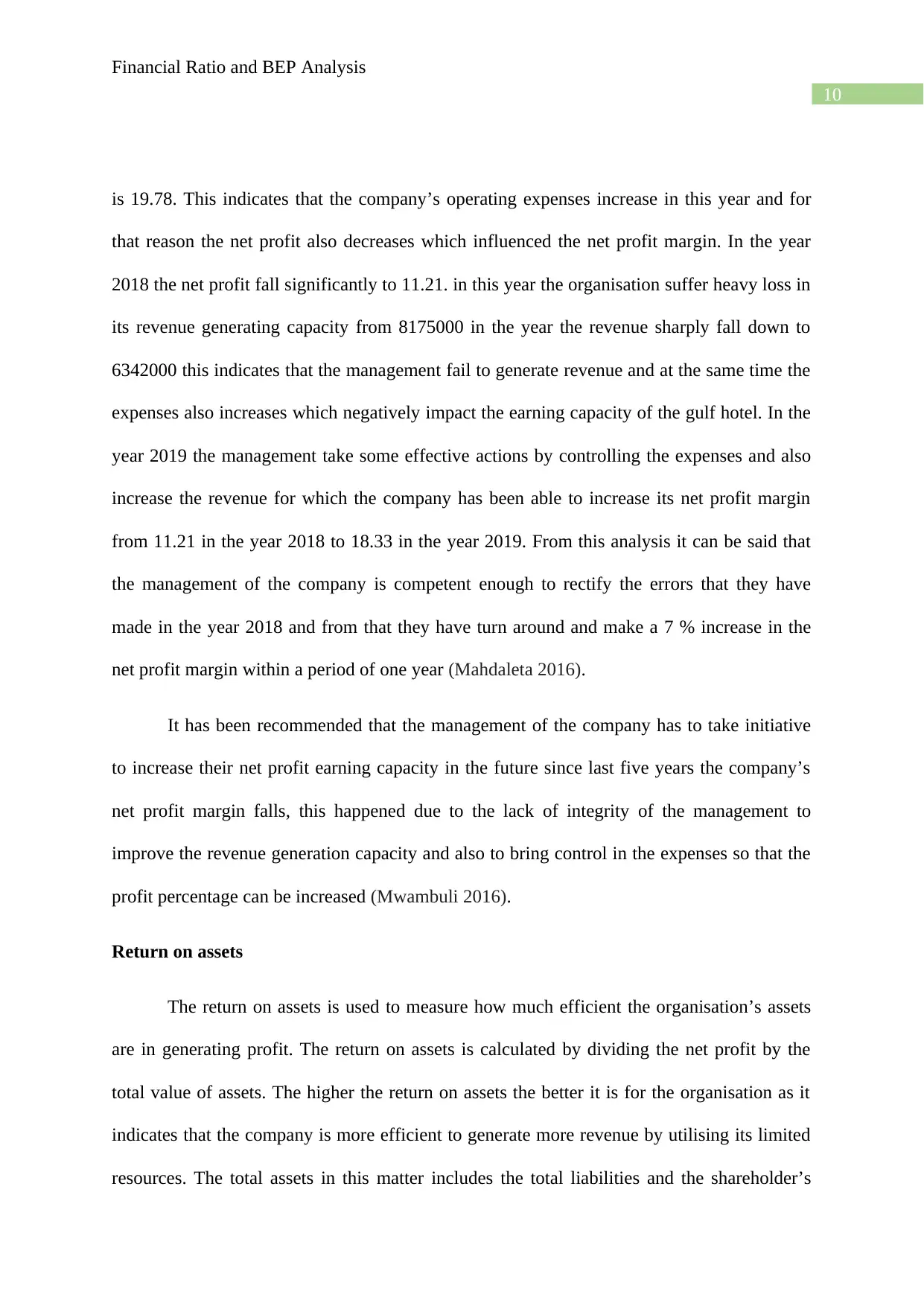
10
Financial Ratio and BEP Analysis
is 19.78. This indicates that the company’s operating expenses increase in this year and for
that reason the net profit also decreases which influenced the net profit margin. In the year
2018 the net profit fall significantly to 11.21. in this year the organisation suffer heavy loss in
its revenue generating capacity from 8175000 in the year the revenue sharply fall down to
6342000 this indicates that the management fail to generate revenue and at the same time the
expenses also increases which negatively impact the earning capacity of the gulf hotel. In the
year 2019 the management take some effective actions by controlling the expenses and also
increase the revenue for which the company has been able to increase its net profit margin
from 11.21 in the year 2018 to 18.33 in the year 2019. From this analysis it can be said that
the management of the company is competent enough to rectify the errors that they have
made in the year 2018 and from that they have turn around and make a 7 % increase in the
net profit margin within a period of one year (Mahdaleta 2016).
It has been recommended that the management of the company has to take initiative
to increase their net profit earning capacity in the future since last five years the company’s
net profit margin falls, this happened due to the lack of integrity of the management to
improve the revenue generation capacity and also to bring control in the expenses so that the
profit percentage can be increased (Mwambuli 2016).
Return on assets
The return on assets is used to measure how much efficient the organisation’s assets
are in generating profit. The return on assets is calculated by dividing the net profit by the
total value of assets. The higher the return on assets the better it is for the organisation as it
indicates that the company is more efficient to generate more revenue by utilising its limited
resources. The total assets in this matter includes the total liabilities and the shareholder’s
Financial Ratio and BEP Analysis
is 19.78. This indicates that the company’s operating expenses increase in this year and for
that reason the net profit also decreases which influenced the net profit margin. In the year
2018 the net profit fall significantly to 11.21. in this year the organisation suffer heavy loss in
its revenue generating capacity from 8175000 in the year the revenue sharply fall down to
6342000 this indicates that the management fail to generate revenue and at the same time the
expenses also increases which negatively impact the earning capacity of the gulf hotel. In the
year 2019 the management take some effective actions by controlling the expenses and also
increase the revenue for which the company has been able to increase its net profit margin
from 11.21 in the year 2018 to 18.33 in the year 2019. From this analysis it can be said that
the management of the company is competent enough to rectify the errors that they have
made in the year 2018 and from that they have turn around and make a 7 % increase in the
net profit margin within a period of one year (Mahdaleta 2016).
It has been recommended that the management of the company has to take initiative
to increase their net profit earning capacity in the future since last five years the company’s
net profit margin falls, this happened due to the lack of integrity of the management to
improve the revenue generation capacity and also to bring control in the expenses so that the
profit percentage can be increased (Mwambuli 2016).
Return on assets
The return on assets is used to measure how much efficient the organisation’s assets
are in generating profit. The return on assets is calculated by dividing the net profit by the
total value of assets. The higher the return on assets the better it is for the organisation as it
indicates that the company is more efficient to generate more revenue by utilising its limited
resources. The total assets in this matter includes the total liabilities and the shareholder’s
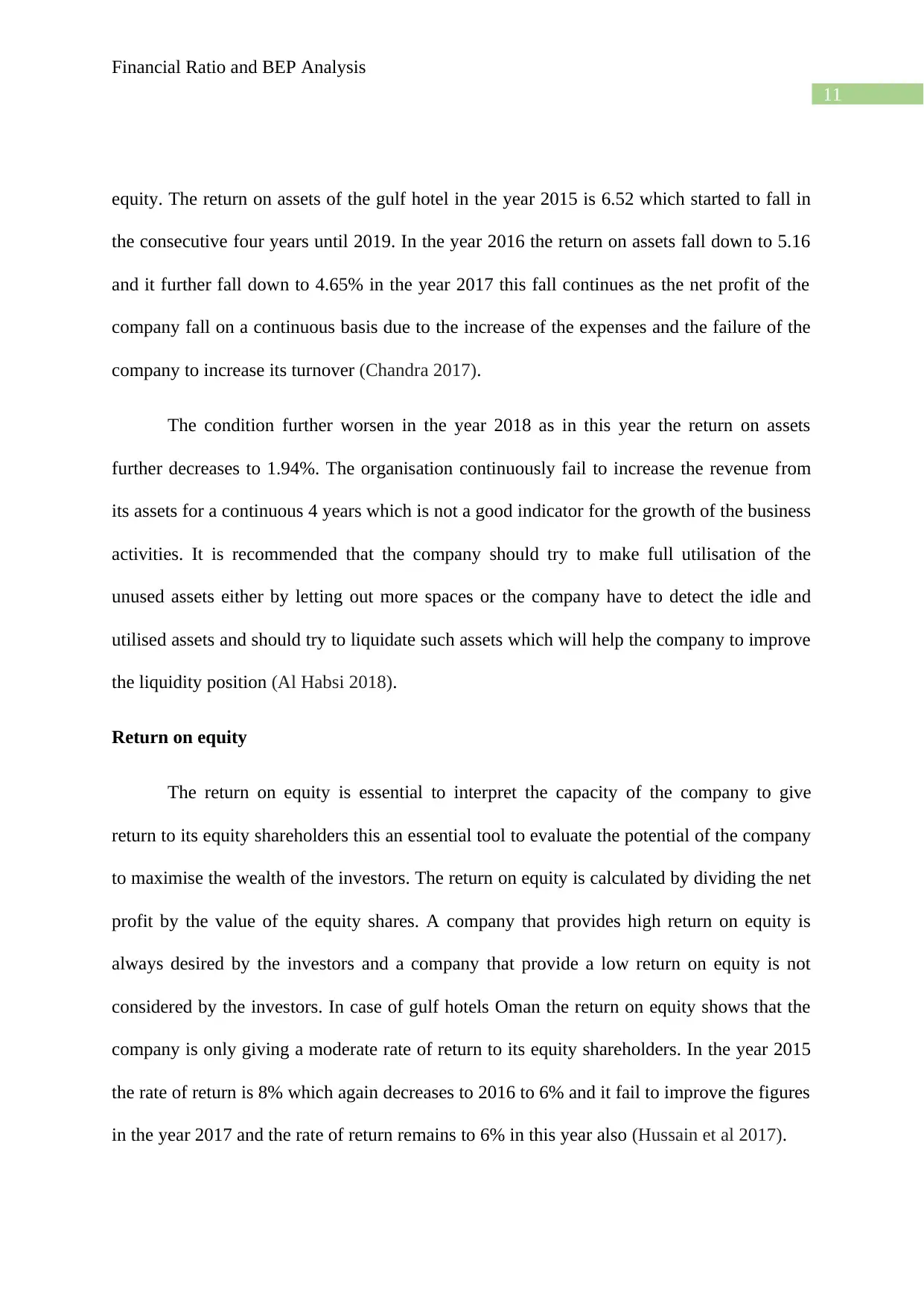
11
Financial Ratio and BEP Analysis
equity. The return on assets of the gulf hotel in the year 2015 is 6.52 which started to fall in
the consecutive four years until 2019. In the year 2016 the return on assets fall down to 5.16
and it further fall down to 4.65% in the year 2017 this fall continues as the net profit of the
company fall on a continuous basis due to the increase of the expenses and the failure of the
company to increase its turnover (Chandra 2017).
The condition further worsen in the year 2018 as in this year the return on assets
further decreases to 1.94%. The organisation continuously fail to increase the revenue from
its assets for a continuous 4 years which is not a good indicator for the growth of the business
activities. It is recommended that the company should try to make full utilisation of the
unused assets either by letting out more spaces or the company have to detect the idle and
utilised assets and should try to liquidate such assets which will help the company to improve
the liquidity position (Al Habsi 2018).
Return on equity
The return on equity is essential to interpret the capacity of the company to give
return to its equity shareholders this an essential tool to evaluate the potential of the company
to maximise the wealth of the investors. The return on equity is calculated by dividing the net
profit by the value of the equity shares. A company that provides high return on equity is
always desired by the investors and a company that provide a low return on equity is not
considered by the investors. In case of gulf hotels Oman the return on equity shows that the
company is only giving a moderate rate of return to its equity shareholders. In the year 2015
the rate of return is 8% which again decreases to 2016 to 6% and it fail to improve the figures
in the year 2017 and the rate of return remains to 6% in this year also (Hussain et al 2017).
Financial Ratio and BEP Analysis
equity. The return on assets of the gulf hotel in the year 2015 is 6.52 which started to fall in
the consecutive four years until 2019. In the year 2016 the return on assets fall down to 5.16
and it further fall down to 4.65% in the year 2017 this fall continues as the net profit of the
company fall on a continuous basis due to the increase of the expenses and the failure of the
company to increase its turnover (Chandra 2017).
The condition further worsen in the year 2018 as in this year the return on assets
further decreases to 1.94%. The organisation continuously fail to increase the revenue from
its assets for a continuous 4 years which is not a good indicator for the growth of the business
activities. It is recommended that the company should try to make full utilisation of the
unused assets either by letting out more spaces or the company have to detect the idle and
utilised assets and should try to liquidate such assets which will help the company to improve
the liquidity position (Al Habsi 2018).
Return on equity
The return on equity is essential to interpret the capacity of the company to give
return to its equity shareholders this an essential tool to evaluate the potential of the company
to maximise the wealth of the investors. The return on equity is calculated by dividing the net
profit by the value of the equity shares. A company that provides high return on equity is
always desired by the investors and a company that provide a low return on equity is not
considered by the investors. In case of gulf hotels Oman the return on equity shows that the
company is only giving a moderate rate of return to its equity shareholders. In the year 2015
the rate of return is 8% which again decreases to 2016 to 6% and it fail to improve the figures
in the year 2017 and the rate of return remains to 6% in this year also (Hussain et al 2017).
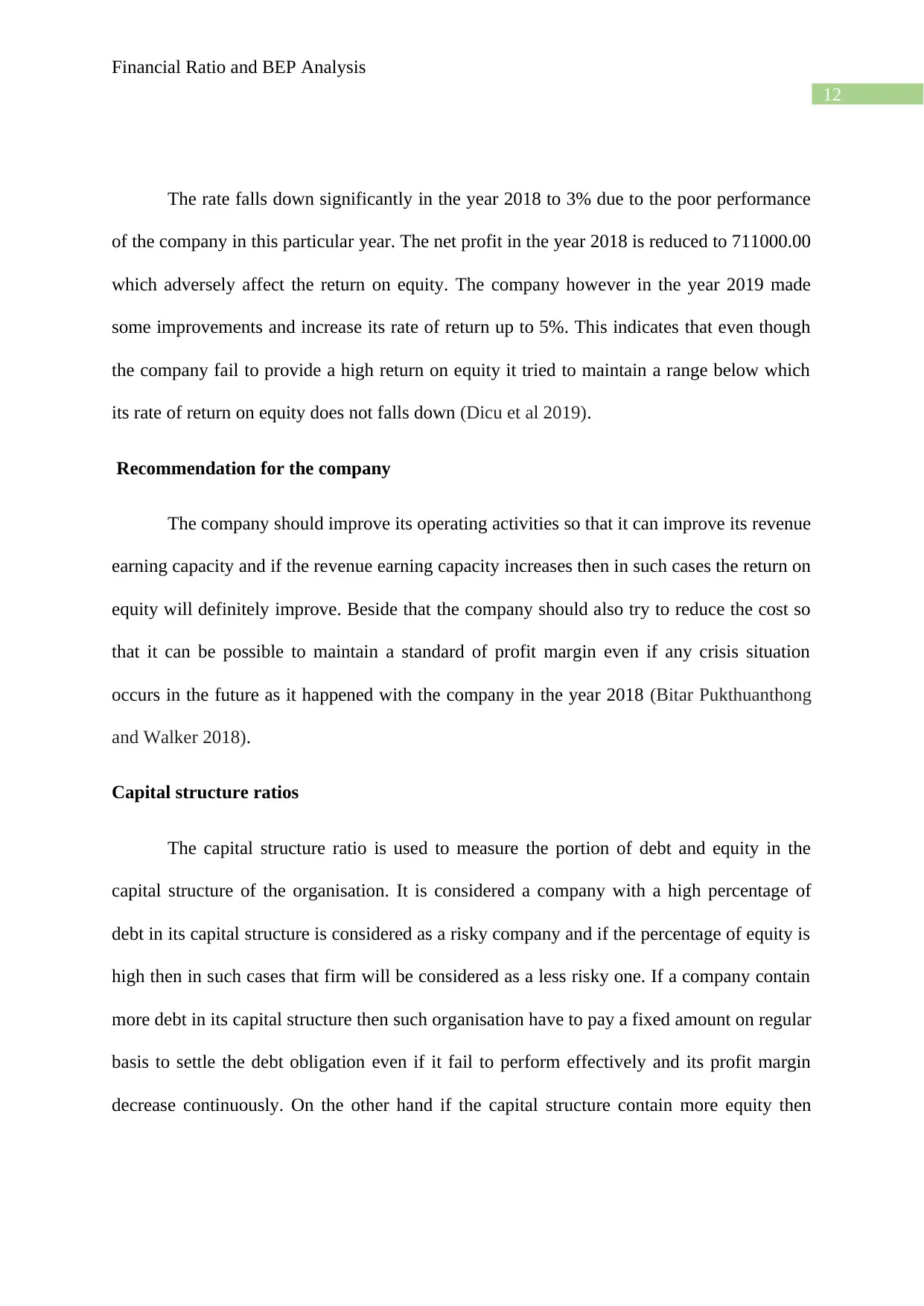
12
Financial Ratio and BEP Analysis
The rate falls down significantly in the year 2018 to 3% due to the poor performance
of the company in this particular year. The net profit in the year 2018 is reduced to 711000.00
which adversely affect the return on equity. The company however in the year 2019 made
some improvements and increase its rate of return up to 5%. This indicates that even though
the company fail to provide a high return on equity it tried to maintain a range below which
its rate of return on equity does not falls down (Dicu et al 2019).
Recommendation for the company
The company should improve its operating activities so that it can improve its revenue
earning capacity and if the revenue earning capacity increases then in such cases the return on
equity will definitely improve. Beside that the company should also try to reduce the cost so
that it can be possible to maintain a standard of profit margin even if any crisis situation
occurs in the future as it happened with the company in the year 2018 (Bitar Pukthuanthong
and Walker 2018).
Capital structure ratios
The capital structure ratio is used to measure the portion of debt and equity in the
capital structure of the organisation. It is considered a company with a high percentage of
debt in its capital structure is considered as a risky company and if the percentage of equity is
high then in such cases that firm will be considered as a less risky one. If a company contain
more debt in its capital structure then such organisation have to pay a fixed amount on regular
basis to settle the debt obligation even if it fail to perform effectively and its profit margin
decrease continuously. On the other hand if the capital structure contain more equity then
Financial Ratio and BEP Analysis
The rate falls down significantly in the year 2018 to 3% due to the poor performance
of the company in this particular year. The net profit in the year 2018 is reduced to 711000.00
which adversely affect the return on equity. The company however in the year 2019 made
some improvements and increase its rate of return up to 5%. This indicates that even though
the company fail to provide a high return on equity it tried to maintain a range below which
its rate of return on equity does not falls down (Dicu et al 2019).
Recommendation for the company
The company should improve its operating activities so that it can improve its revenue
earning capacity and if the revenue earning capacity increases then in such cases the return on
equity will definitely improve. Beside that the company should also try to reduce the cost so
that it can be possible to maintain a standard of profit margin even if any crisis situation
occurs in the future as it happened with the company in the year 2018 (Bitar Pukthuanthong
and Walker 2018).
Capital structure ratios
The capital structure ratio is used to measure the portion of debt and equity in the
capital structure of the organisation. It is considered a company with a high percentage of
debt in its capital structure is considered as a risky company and if the percentage of equity is
high then in such cases that firm will be considered as a less risky one. If a company contain
more debt in its capital structure then such organisation have to pay a fixed amount on regular
basis to settle the debt obligation even if it fail to perform effectively and its profit margin
decrease continuously. On the other hand if the capital structure contain more equity then
Paraphrase This Document
Need a fresh take? Get an instant paraphrase of this document with our AI Paraphraser
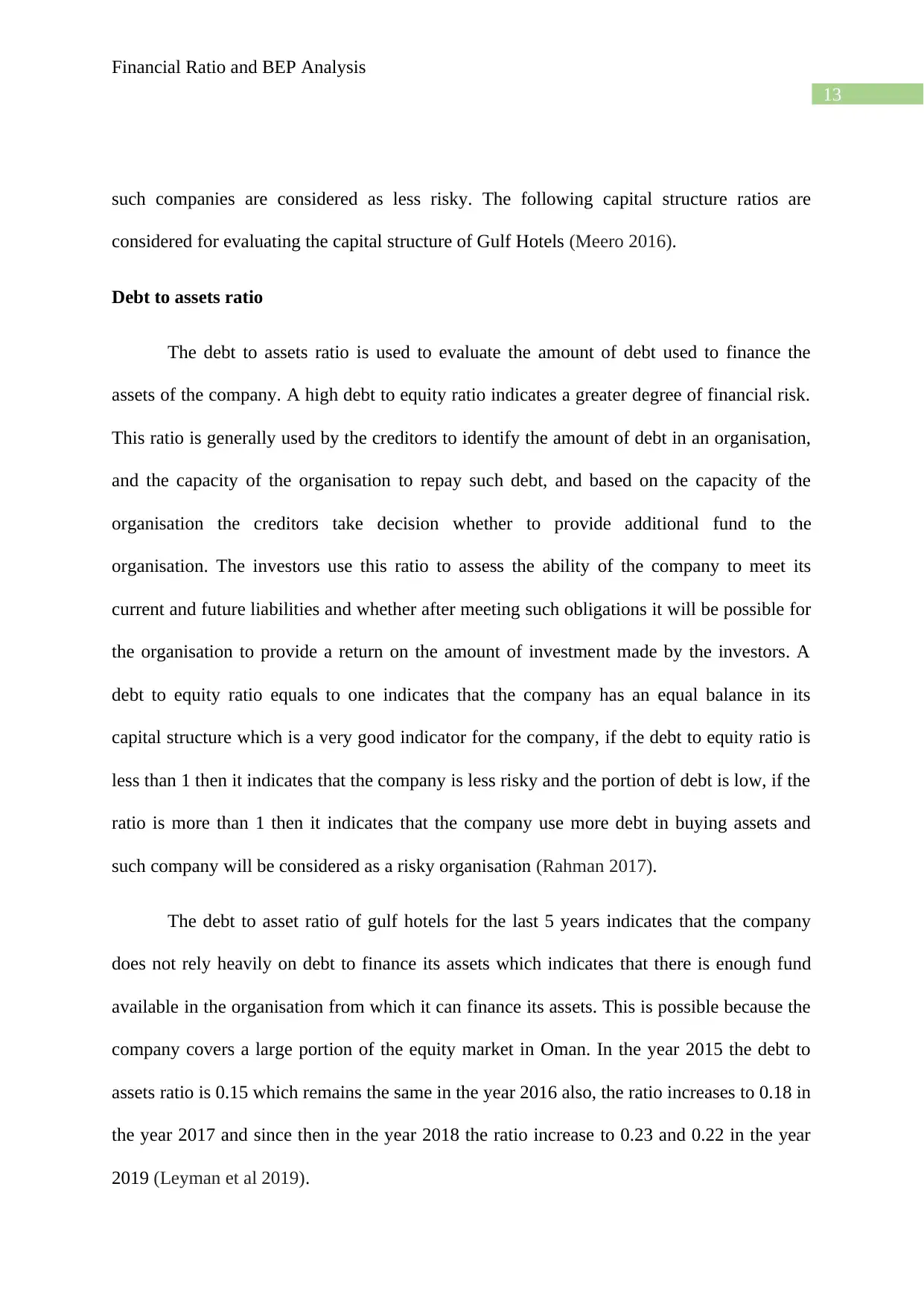
13
Financial Ratio and BEP Analysis
such companies are considered as less risky. The following capital structure ratios are
considered for evaluating the capital structure of Gulf Hotels (Meero 2016).
Debt to assets ratio
The debt to assets ratio is used to evaluate the amount of debt used to finance the
assets of the company. A high debt to equity ratio indicates a greater degree of financial risk.
This ratio is generally used by the creditors to identify the amount of debt in an organisation,
and the capacity of the organisation to repay such debt, and based on the capacity of the
organisation the creditors take decision whether to provide additional fund to the
organisation. The investors use this ratio to assess the ability of the company to meet its
current and future liabilities and whether after meeting such obligations it will be possible for
the organisation to provide a return on the amount of investment made by the investors. A
debt to equity ratio equals to one indicates that the company has an equal balance in its
capital structure which is a very good indicator for the company, if the debt to equity ratio is
less than 1 then it indicates that the company is less risky and the portion of debt is low, if the
ratio is more than 1 then it indicates that the company use more debt in buying assets and
such company will be considered as a risky organisation (Rahman 2017).
The debt to asset ratio of gulf hotels for the last 5 years indicates that the company
does not rely heavily on debt to finance its assets which indicates that there is enough fund
available in the organisation from which it can finance its assets. This is possible because the
company covers a large portion of the equity market in Oman. In the year 2015 the debt to
assets ratio is 0.15 which remains the same in the year 2016 also, the ratio increases to 0.18 in
the year 2017 and since then in the year 2018 the ratio increase to 0.23 and 0.22 in the year
2019 (Leyman et al 2019).
Financial Ratio and BEP Analysis
such companies are considered as less risky. The following capital structure ratios are
considered for evaluating the capital structure of Gulf Hotels (Meero 2016).
Debt to assets ratio
The debt to assets ratio is used to evaluate the amount of debt used to finance the
assets of the company. A high debt to equity ratio indicates a greater degree of financial risk.
This ratio is generally used by the creditors to identify the amount of debt in an organisation,
and the capacity of the organisation to repay such debt, and based on the capacity of the
organisation the creditors take decision whether to provide additional fund to the
organisation. The investors use this ratio to assess the ability of the company to meet its
current and future liabilities and whether after meeting such obligations it will be possible for
the organisation to provide a return on the amount of investment made by the investors. A
debt to equity ratio equals to one indicates that the company has an equal balance in its
capital structure which is a very good indicator for the company, if the debt to equity ratio is
less than 1 then it indicates that the company is less risky and the portion of debt is low, if the
ratio is more than 1 then it indicates that the company use more debt in buying assets and
such company will be considered as a risky organisation (Rahman 2017).
The debt to asset ratio of gulf hotels for the last 5 years indicates that the company
does not rely heavily on debt to finance its assets which indicates that there is enough fund
available in the organisation from which it can finance its assets. This is possible because the
company covers a large portion of the equity market in Oman. In the year 2015 the debt to
assets ratio is 0.15 which remains the same in the year 2016 also, the ratio increases to 0.18 in
the year 2017 and since then in the year 2018 the ratio increase to 0.23 and 0.22 in the year
2019 (Leyman et al 2019).
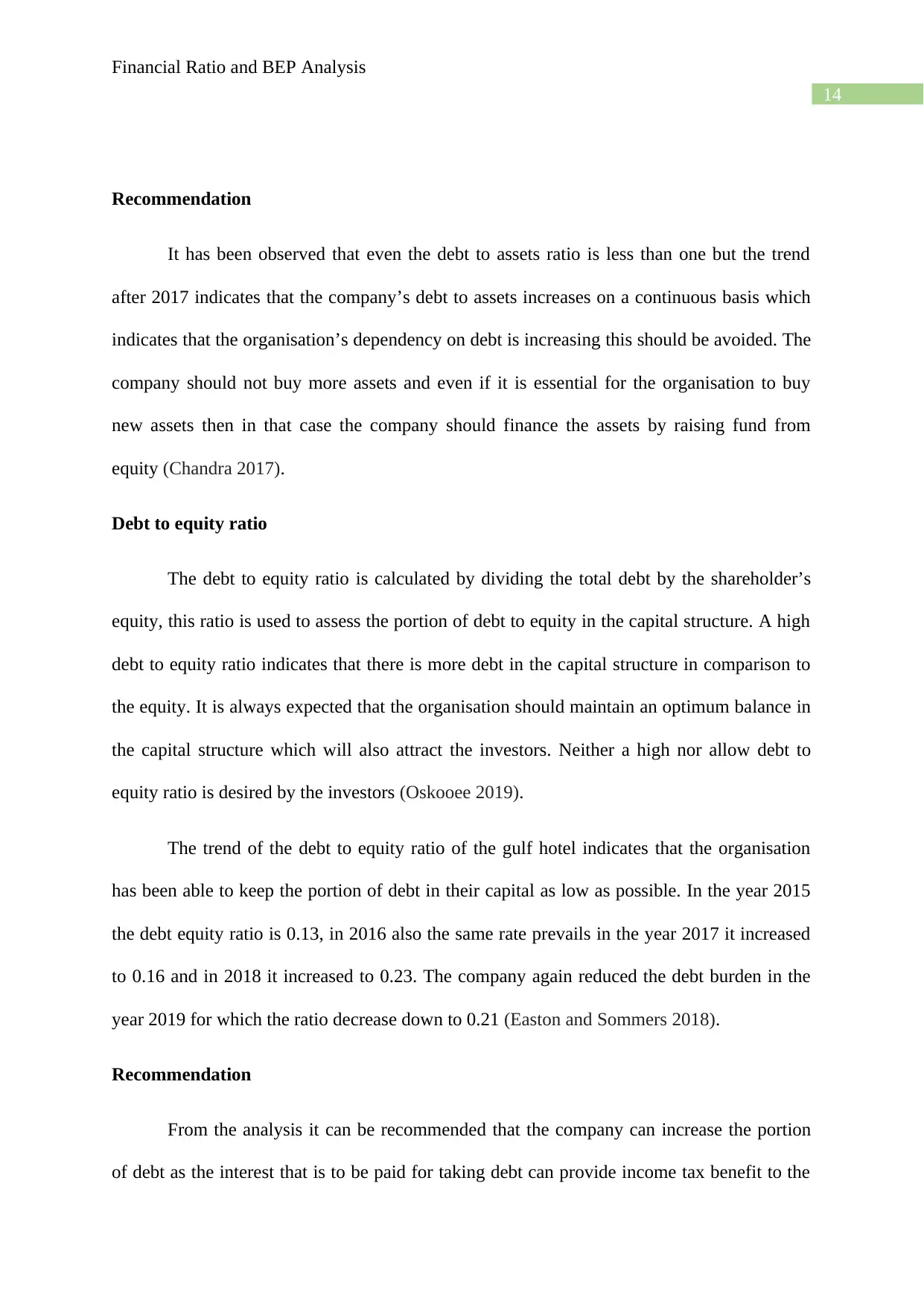
14
Financial Ratio and BEP Analysis
Recommendation
It has been observed that even the debt to assets ratio is less than one but the trend
after 2017 indicates that the company’s debt to assets increases on a continuous basis which
indicates that the organisation’s dependency on debt is increasing this should be avoided. The
company should not buy more assets and even if it is essential for the organisation to buy
new assets then in that case the company should finance the assets by raising fund from
equity (Chandra 2017).
Debt to equity ratio
The debt to equity ratio is calculated by dividing the total debt by the shareholder’s
equity, this ratio is used to assess the portion of debt to equity in the capital structure. A high
debt to equity ratio indicates that there is more debt in the capital structure in comparison to
the equity. It is always expected that the organisation should maintain an optimum balance in
the capital structure which will also attract the investors. Neither a high nor allow debt to
equity ratio is desired by the investors (Oskooee 2019).
The trend of the debt to equity ratio of the gulf hotel indicates that the organisation
has been able to keep the portion of debt in their capital as low as possible. In the year 2015
the debt equity ratio is 0.13, in 2016 also the same rate prevails in the year 2017 it increased
to 0.16 and in 2018 it increased to 0.23. The company again reduced the debt burden in the
year 2019 for which the ratio decrease down to 0.21 (Easton and Sommers 2018).
Recommendation
From the analysis it can be recommended that the company can increase the portion
of debt as the interest that is to be paid for taking debt can provide income tax benefit to the
Financial Ratio and BEP Analysis
Recommendation
It has been observed that even the debt to assets ratio is less than one but the trend
after 2017 indicates that the company’s debt to assets increases on a continuous basis which
indicates that the organisation’s dependency on debt is increasing this should be avoided. The
company should not buy more assets and even if it is essential for the organisation to buy
new assets then in that case the company should finance the assets by raising fund from
equity (Chandra 2017).
Debt to equity ratio
The debt to equity ratio is calculated by dividing the total debt by the shareholder’s
equity, this ratio is used to assess the portion of debt to equity in the capital structure. A high
debt to equity ratio indicates that there is more debt in the capital structure in comparison to
the equity. It is always expected that the organisation should maintain an optimum balance in
the capital structure which will also attract the investors. Neither a high nor allow debt to
equity ratio is desired by the investors (Oskooee 2019).
The trend of the debt to equity ratio of the gulf hotel indicates that the organisation
has been able to keep the portion of debt in their capital as low as possible. In the year 2015
the debt equity ratio is 0.13, in 2016 also the same rate prevails in the year 2017 it increased
to 0.16 and in 2018 it increased to 0.23. The company again reduced the debt burden in the
year 2019 for which the ratio decrease down to 0.21 (Easton and Sommers 2018).
Recommendation
From the analysis it can be recommended that the company can increase the portion
of debt as the interest that is to be paid for taking debt can provide income tax benefit to the
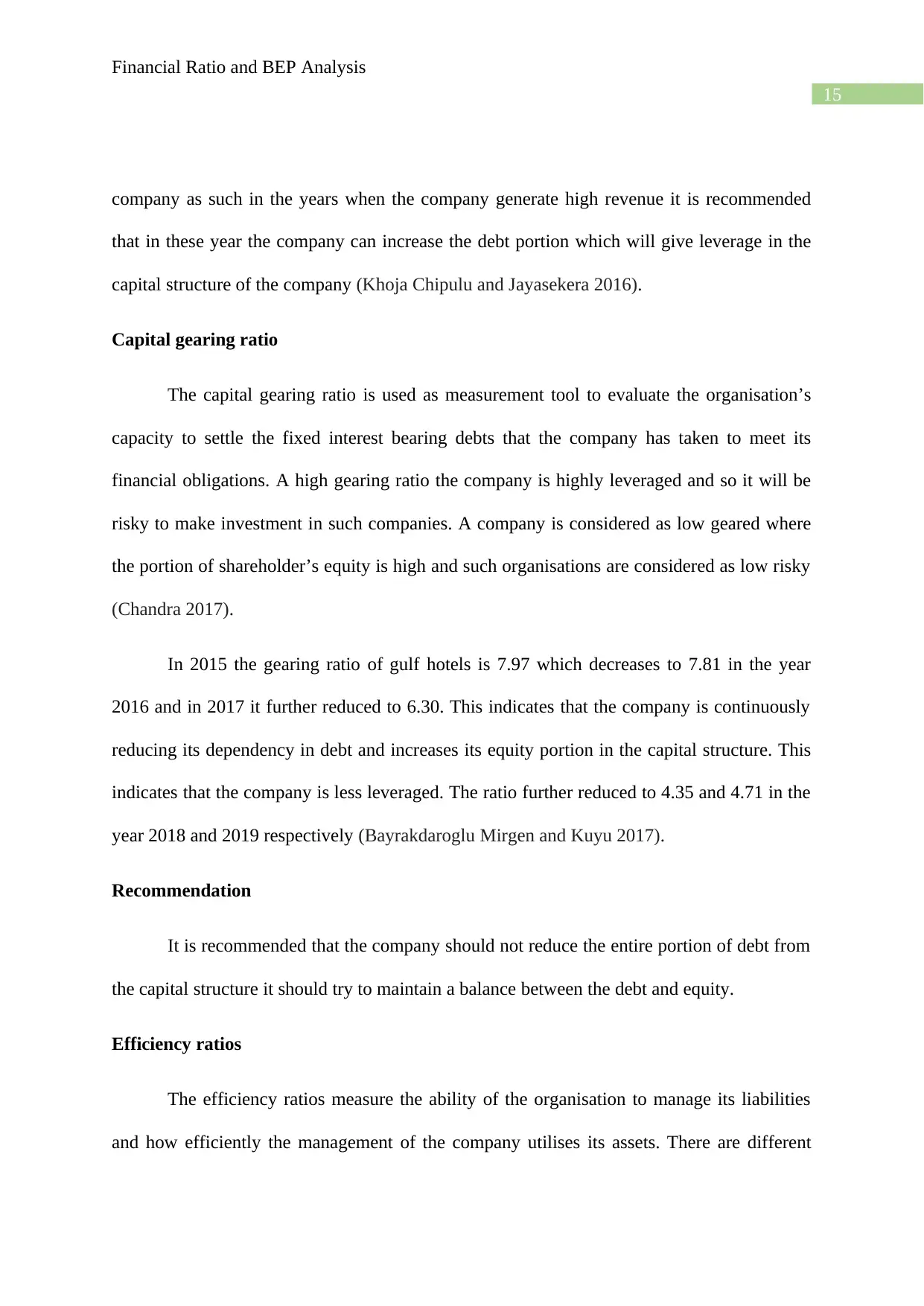
15
Financial Ratio and BEP Analysis
company as such in the years when the company generate high revenue it is recommended
that in these year the company can increase the debt portion which will give leverage in the
capital structure of the company (Khoja Chipulu and Jayasekera 2016).
Capital gearing ratio
The capital gearing ratio is used as measurement tool to evaluate the organisation’s
capacity to settle the fixed interest bearing debts that the company has taken to meet its
financial obligations. A high gearing ratio the company is highly leveraged and so it will be
risky to make investment in such companies. A company is considered as low geared where
the portion of shareholder’s equity is high and such organisations are considered as low risky
(Chandra 2017).
In 2015 the gearing ratio of gulf hotels is 7.97 which decreases to 7.81 in the year
2016 and in 2017 it further reduced to 6.30. This indicates that the company is continuously
reducing its dependency in debt and increases its equity portion in the capital structure. This
indicates that the company is less leveraged. The ratio further reduced to 4.35 and 4.71 in the
year 2018 and 2019 respectively (Bayrakdaroglu Mirgen and Kuyu 2017).
Recommendation
It is recommended that the company should not reduce the entire portion of debt from
the capital structure it should try to maintain a balance between the debt and equity.
Efficiency ratios
The efficiency ratios measure the ability of the organisation to manage its liabilities
and how efficiently the management of the company utilises its assets. There are different
Financial Ratio and BEP Analysis
company as such in the years when the company generate high revenue it is recommended
that in these year the company can increase the debt portion which will give leverage in the
capital structure of the company (Khoja Chipulu and Jayasekera 2016).
Capital gearing ratio
The capital gearing ratio is used as measurement tool to evaluate the organisation’s
capacity to settle the fixed interest bearing debts that the company has taken to meet its
financial obligations. A high gearing ratio the company is highly leveraged and so it will be
risky to make investment in such companies. A company is considered as low geared where
the portion of shareholder’s equity is high and such organisations are considered as low risky
(Chandra 2017).
In 2015 the gearing ratio of gulf hotels is 7.97 which decreases to 7.81 in the year
2016 and in 2017 it further reduced to 6.30. This indicates that the company is continuously
reducing its dependency in debt and increases its equity portion in the capital structure. This
indicates that the company is less leveraged. The ratio further reduced to 4.35 and 4.71 in the
year 2018 and 2019 respectively (Bayrakdaroglu Mirgen and Kuyu 2017).
Recommendation
It is recommended that the company should not reduce the entire portion of debt from
the capital structure it should try to maintain a balance between the debt and equity.
Efficiency ratios
The efficiency ratios measure the ability of the organisation to manage its liabilities
and how efficiently the management of the company utilises its assets. There are different
Secure Best Marks with AI Grader
Need help grading? Try our AI Grader for instant feedback on your assignments.
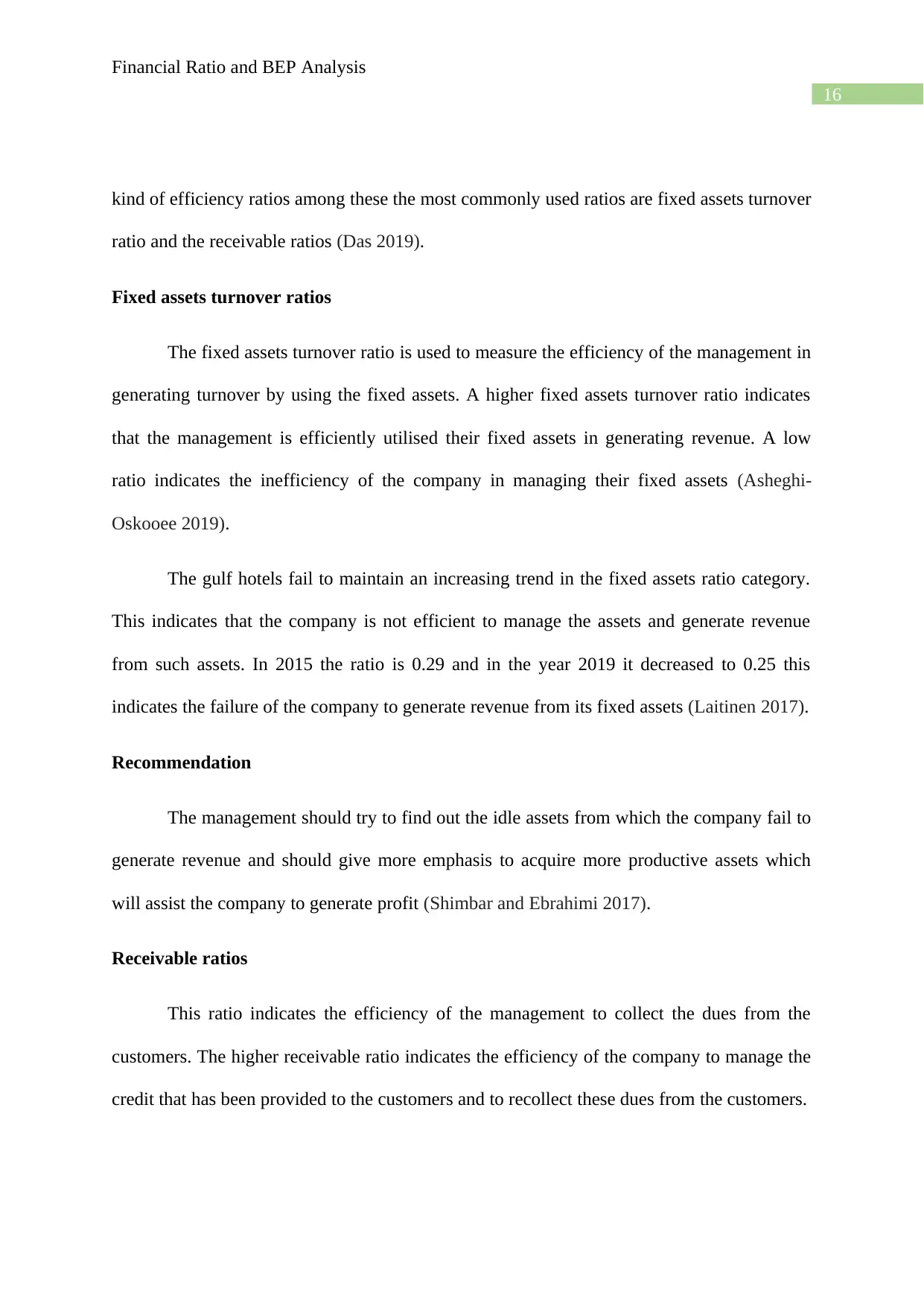
16
Financial Ratio and BEP Analysis
kind of efficiency ratios among these the most commonly used ratios are fixed assets turnover
ratio and the receivable ratios (Das 2019).
Fixed assets turnover ratios
The fixed assets turnover ratio is used to measure the efficiency of the management in
generating turnover by using the fixed assets. A higher fixed assets turnover ratio indicates
that the management is efficiently utilised their fixed assets in generating revenue. A low
ratio indicates the inefficiency of the company in managing their fixed assets (Asheghi-
Oskooee 2019).
The gulf hotels fail to maintain an increasing trend in the fixed assets ratio category.
This indicates that the company is not efficient to manage the assets and generate revenue
from such assets. In 2015 the ratio is 0.29 and in the year 2019 it decreased to 0.25 this
indicates the failure of the company to generate revenue from its fixed assets (Laitinen 2017).
Recommendation
The management should try to find out the idle assets from which the company fail to
generate revenue and should give more emphasis to acquire more productive assets which
will assist the company to generate profit (Shimbar and Ebrahimi 2017).
Receivable ratios
This ratio indicates the efficiency of the management to collect the dues from the
customers. The higher receivable ratio indicates the efficiency of the company to manage the
credit that has been provided to the customers and to recollect these dues from the customers.
Financial Ratio and BEP Analysis
kind of efficiency ratios among these the most commonly used ratios are fixed assets turnover
ratio and the receivable ratios (Das 2019).
Fixed assets turnover ratios
The fixed assets turnover ratio is used to measure the efficiency of the management in
generating turnover by using the fixed assets. A higher fixed assets turnover ratio indicates
that the management is efficiently utilised their fixed assets in generating revenue. A low
ratio indicates the inefficiency of the company in managing their fixed assets (Asheghi-
Oskooee 2019).
The gulf hotels fail to maintain an increasing trend in the fixed assets ratio category.
This indicates that the company is not efficient to manage the assets and generate revenue
from such assets. In 2015 the ratio is 0.29 and in the year 2019 it decreased to 0.25 this
indicates the failure of the company to generate revenue from its fixed assets (Laitinen 2017).
Recommendation
The management should try to find out the idle assets from which the company fail to
generate revenue and should give more emphasis to acquire more productive assets which
will assist the company to generate profit (Shimbar and Ebrahimi 2017).
Receivable ratios
This ratio indicates the efficiency of the management to collect the dues from the
customers. The higher receivable ratio indicates the efficiency of the company to manage the
credit that has been provided to the customers and to recollect these dues from the customers.
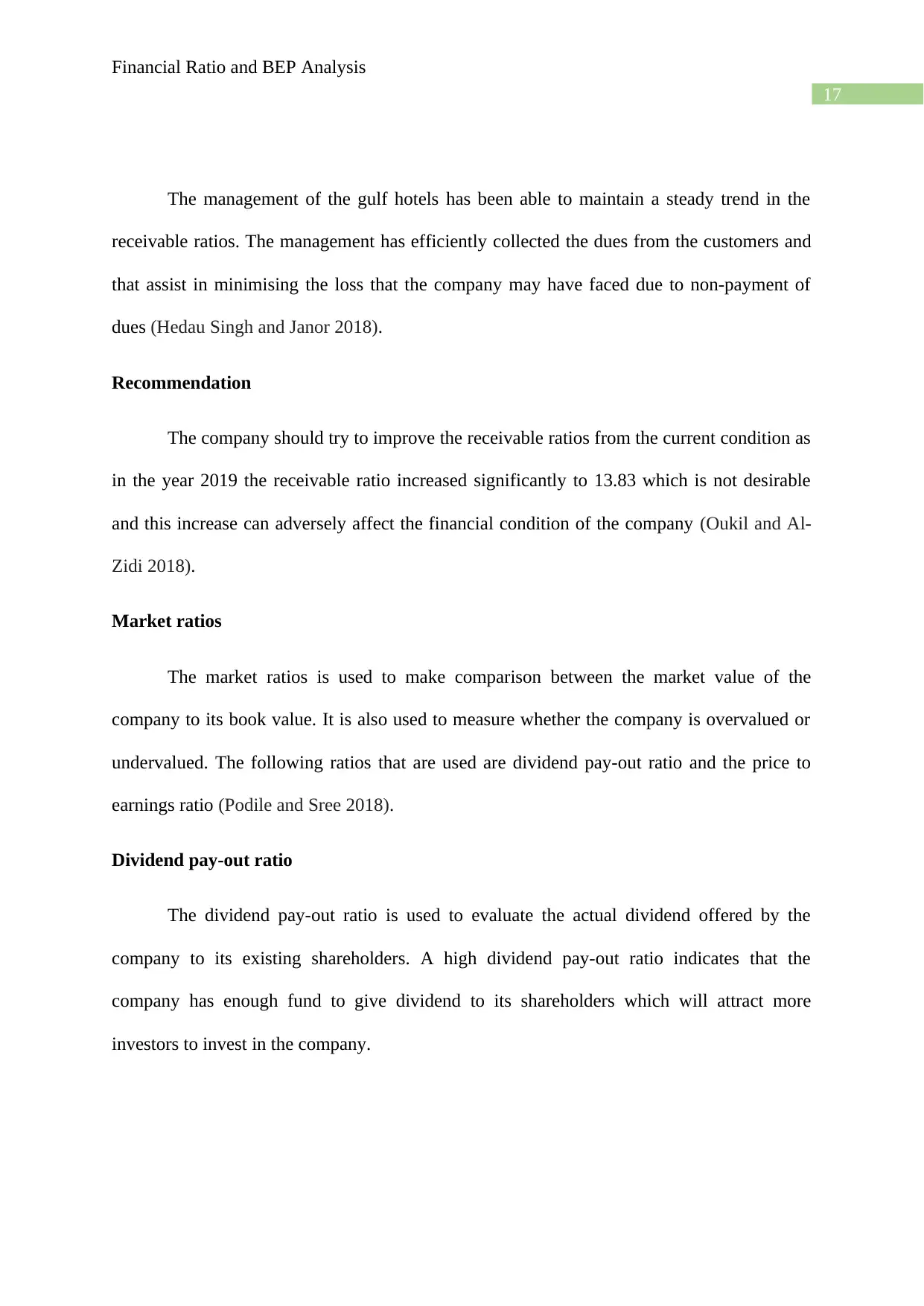
17
Financial Ratio and BEP Analysis
The management of the gulf hotels has been able to maintain a steady trend in the
receivable ratios. The management has efficiently collected the dues from the customers and
that assist in minimising the loss that the company may have faced due to non-payment of
dues (Hedau Singh and Janor 2018).
Recommendation
The company should try to improve the receivable ratios from the current condition as
in the year 2019 the receivable ratio increased significantly to 13.83 which is not desirable
and this increase can adversely affect the financial condition of the company (Oukil and Al-
Zidi 2018).
Market ratios
The market ratios is used to make comparison between the market value of the
company to its book value. It is also used to measure whether the company is overvalued or
undervalued. The following ratios that are used are dividend pay-out ratio and the price to
earnings ratio (Podile and Sree 2018).
Dividend pay-out ratio
The dividend pay-out ratio is used to evaluate the actual dividend offered by the
company to its existing shareholders. A high dividend pay-out ratio indicates that the
company has enough fund to give dividend to its shareholders which will attract more
investors to invest in the company.
Financial Ratio and BEP Analysis
The management of the gulf hotels has been able to maintain a steady trend in the
receivable ratios. The management has efficiently collected the dues from the customers and
that assist in minimising the loss that the company may have faced due to non-payment of
dues (Hedau Singh and Janor 2018).
Recommendation
The company should try to improve the receivable ratios from the current condition as
in the year 2019 the receivable ratio increased significantly to 13.83 which is not desirable
and this increase can adversely affect the financial condition of the company (Oukil and Al-
Zidi 2018).
Market ratios
The market ratios is used to make comparison between the market value of the
company to its book value. It is also used to measure whether the company is overvalued or
undervalued. The following ratios that are used are dividend pay-out ratio and the price to
earnings ratio (Podile and Sree 2018).
Dividend pay-out ratio
The dividend pay-out ratio is used to evaluate the actual dividend offered by the
company to its existing shareholders. A high dividend pay-out ratio indicates that the
company has enough fund to give dividend to its shareholders which will attract more
investors to invest in the company.
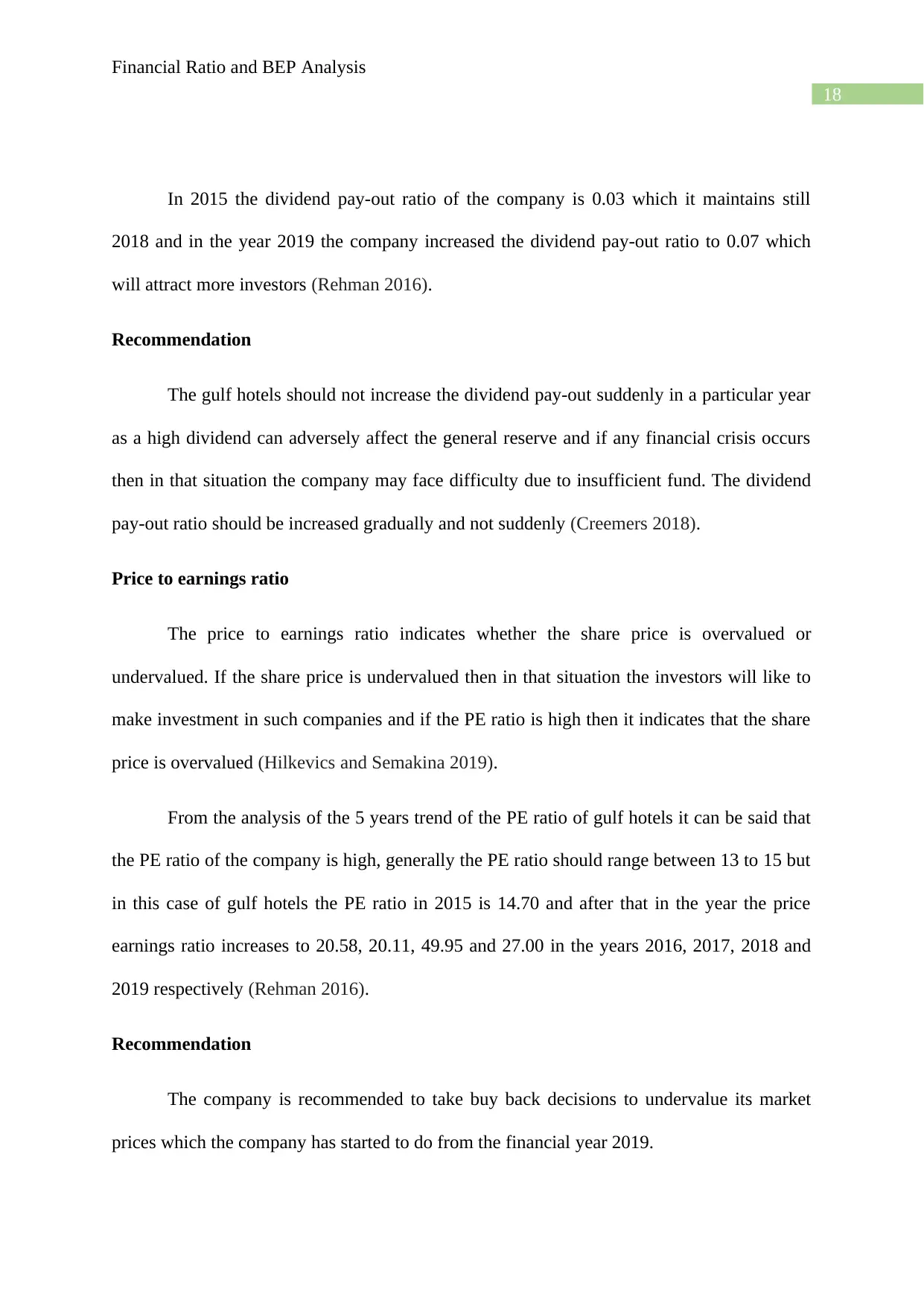
18
Financial Ratio and BEP Analysis
In 2015 the dividend pay-out ratio of the company is 0.03 which it maintains still
2018 and in the year 2019 the company increased the dividend pay-out ratio to 0.07 which
will attract more investors (Rehman 2016).
Recommendation
The gulf hotels should not increase the dividend pay-out suddenly in a particular year
as a high dividend can adversely affect the general reserve and if any financial crisis occurs
then in that situation the company may face difficulty due to insufficient fund. The dividend
pay-out ratio should be increased gradually and not suddenly (Creemers 2018).
Price to earnings ratio
The price to earnings ratio indicates whether the share price is overvalued or
undervalued. If the share price is undervalued then in that situation the investors will like to
make investment in such companies and if the PE ratio is high then it indicates that the share
price is overvalued (Hilkevics and Semakina 2019).
From the analysis of the 5 years trend of the PE ratio of gulf hotels it can be said that
the PE ratio of the company is high, generally the PE ratio should range between 13 to 15 but
in this case of gulf hotels the PE ratio in 2015 is 14.70 and after that in the year the price
earnings ratio increases to 20.58, 20.11, 49.95 and 27.00 in the years 2016, 2017, 2018 and
2019 respectively (Rehman 2016).
Recommendation
The company is recommended to take buy back decisions to undervalue its market
prices which the company has started to do from the financial year 2019.
Financial Ratio and BEP Analysis
In 2015 the dividend pay-out ratio of the company is 0.03 which it maintains still
2018 and in the year 2019 the company increased the dividend pay-out ratio to 0.07 which
will attract more investors (Rehman 2016).
Recommendation
The gulf hotels should not increase the dividend pay-out suddenly in a particular year
as a high dividend can adversely affect the general reserve and if any financial crisis occurs
then in that situation the company may face difficulty due to insufficient fund. The dividend
pay-out ratio should be increased gradually and not suddenly (Creemers 2018).
Price to earnings ratio
The price to earnings ratio indicates whether the share price is overvalued or
undervalued. If the share price is undervalued then in that situation the investors will like to
make investment in such companies and if the PE ratio is high then it indicates that the share
price is overvalued (Hilkevics and Semakina 2019).
From the analysis of the 5 years trend of the PE ratio of gulf hotels it can be said that
the PE ratio of the company is high, generally the PE ratio should range between 13 to 15 but
in this case of gulf hotels the PE ratio in 2015 is 14.70 and after that in the year the price
earnings ratio increases to 20.58, 20.11, 49.95 and 27.00 in the years 2016, 2017, 2018 and
2019 respectively (Rehman 2016).
Recommendation
The company is recommended to take buy back decisions to undervalue its market
prices which the company has started to do from the financial year 2019.
Paraphrase This Document
Need a fresh take? Get an instant paraphrase of this document with our AI Paraphraser
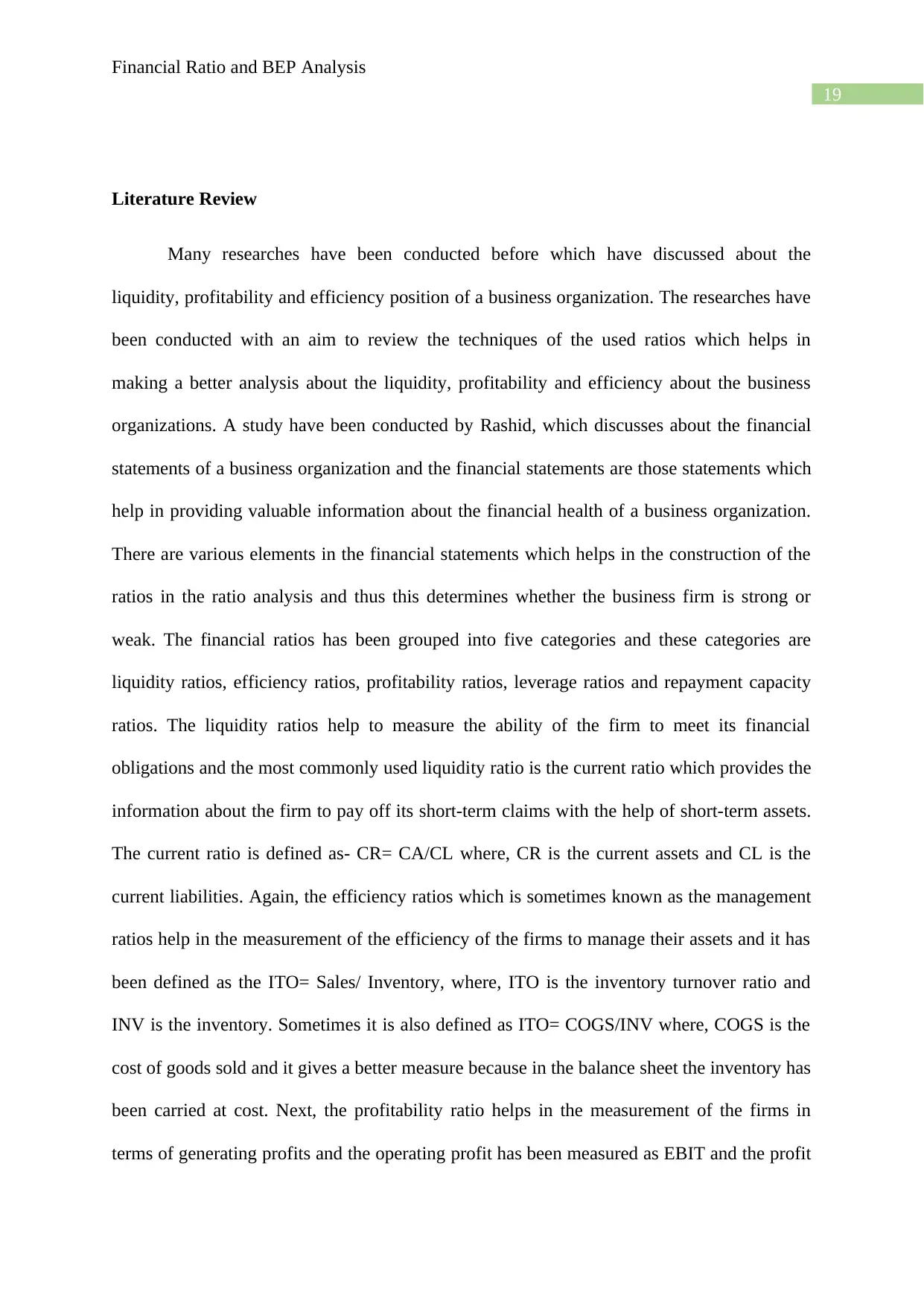
19
Financial Ratio and BEP Analysis
Literature Review
Many researches have been conducted before which have discussed about the
liquidity, profitability and efficiency position of a business organization. The researches have
been conducted with an aim to review the techniques of the used ratios which helps in
making a better analysis about the liquidity, profitability and efficiency about the business
organizations. A study have been conducted by Rashid, which discusses about the financial
statements of a business organization and the financial statements are those statements which
help in providing valuable information about the financial health of a business organization.
There are various elements in the financial statements which helps in the construction of the
ratios in the ratio analysis and thus this determines whether the business firm is strong or
weak. The financial ratios has been grouped into five categories and these categories are
liquidity ratios, efficiency ratios, profitability ratios, leverage ratios and repayment capacity
ratios. The liquidity ratios help to measure the ability of the firm to meet its financial
obligations and the most commonly used liquidity ratio is the current ratio which provides the
information about the firm to pay off its short-term claims with the help of short-term assets.
The current ratio is defined as- CR= CA/CL where, CR is the current assets and CL is the
current liabilities. Again, the efficiency ratios which is sometimes known as the management
ratios help in the measurement of the efficiency of the firms to manage their assets and it has
been defined as the ITO= Sales/ Inventory, where, ITO is the inventory turnover ratio and
INV is the inventory. Sometimes it is also defined as ITO= COGS/INV where, COGS is the
cost of goods sold and it gives a better measure because in the balance sheet the inventory has
been carried at cost. Next, the profitability ratio helps in the measurement of the firms in
terms of generating profits and the operating profit has been measured as EBIT and the profit
Financial Ratio and BEP Analysis
Literature Review
Many researches have been conducted before which have discussed about the
liquidity, profitability and efficiency position of a business organization. The researches have
been conducted with an aim to review the techniques of the used ratios which helps in
making a better analysis about the liquidity, profitability and efficiency about the business
organizations. A study have been conducted by Rashid, which discusses about the financial
statements of a business organization and the financial statements are those statements which
help in providing valuable information about the financial health of a business organization.
There are various elements in the financial statements which helps in the construction of the
ratios in the ratio analysis and thus this determines whether the business firm is strong or
weak. The financial ratios has been grouped into five categories and these categories are
liquidity ratios, efficiency ratios, profitability ratios, leverage ratios and repayment capacity
ratios. The liquidity ratios help to measure the ability of the firm to meet its financial
obligations and the most commonly used liquidity ratio is the current ratio which provides the
information about the firm to pay off its short-term claims with the help of short-term assets.
The current ratio is defined as- CR= CA/CL where, CR is the current assets and CL is the
current liabilities. Again, the efficiency ratios which is sometimes known as the management
ratios help in the measurement of the efficiency of the firms to manage their assets and it has
been defined as the ITO= Sales/ Inventory, where, ITO is the inventory turnover ratio and
INV is the inventory. Sometimes it is also defined as ITO= COGS/INV where, COGS is the
cost of goods sold and it gives a better measure because in the balance sheet the inventory has
been carried at cost. Next, the profitability ratio helps in the measurement of the firms in
terms of generating profits and the operating profit has been measured as EBIT and the profit
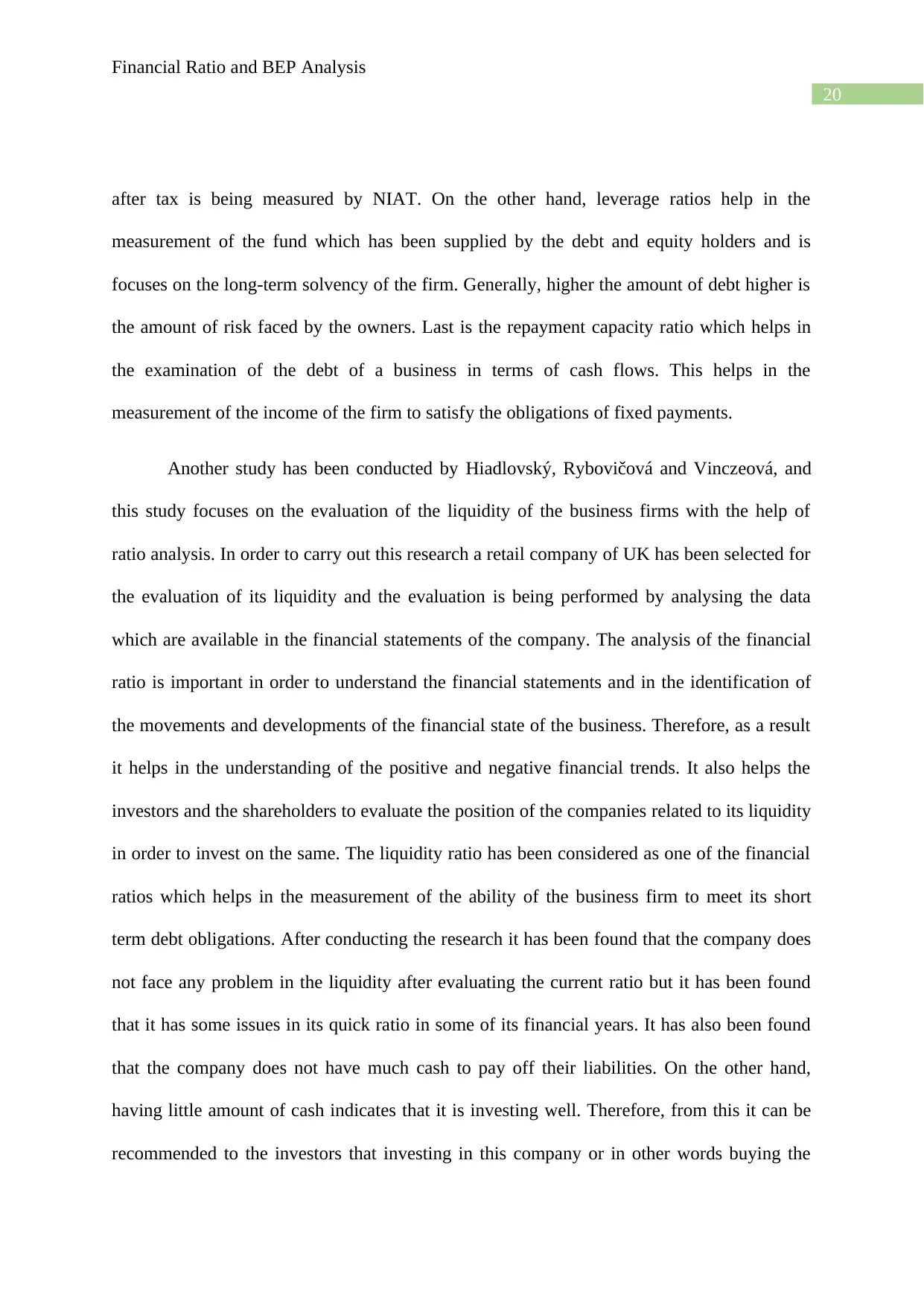
20
Financial Ratio and BEP Analysis
after tax is being measured by NIAT. On the other hand, leverage ratios help in the
measurement of the fund which has been supplied by the debt and equity holders and is
focuses on the long-term solvency of the firm. Generally, higher the amount of debt higher is
the amount of risk faced by the owners. Last is the repayment capacity ratio which helps in
the examination of the debt of a business in terms of cash flows. This helps in the
measurement of the income of the firm to satisfy the obligations of fixed payments.
Another study has been conducted by Hiadlovský, Rybovičová and Vinczeová, and
this study focuses on the evaluation of the liquidity of the business firms with the help of
ratio analysis. In order to carry out this research a retail company of UK has been selected for
the evaluation of its liquidity and the evaluation is being performed by analysing the data
which are available in the financial statements of the company. The analysis of the financial
ratio is important in order to understand the financial statements and in the identification of
the movements and developments of the financial state of the business. Therefore, as a result
it helps in the understanding of the positive and negative financial trends. It also helps the
investors and the shareholders to evaluate the position of the companies related to its liquidity
in order to invest on the same. The liquidity ratio has been considered as one of the financial
ratios which helps in the measurement of the ability of the business firm to meet its short
term debt obligations. After conducting the research it has been found that the company does
not face any problem in the liquidity after evaluating the current ratio but it has been found
that it has some issues in its quick ratio in some of its financial years. It has also been found
that the company does not have much cash to pay off their liabilities. On the other hand,
having little amount of cash indicates that it is investing well. Therefore, from this it can be
recommended to the investors that investing in this company or in other words buying the
Financial Ratio and BEP Analysis
after tax is being measured by NIAT. On the other hand, leverage ratios help in the
measurement of the fund which has been supplied by the debt and equity holders and is
focuses on the long-term solvency of the firm. Generally, higher the amount of debt higher is
the amount of risk faced by the owners. Last is the repayment capacity ratio which helps in
the examination of the debt of a business in terms of cash flows. This helps in the
measurement of the income of the firm to satisfy the obligations of fixed payments.
Another study has been conducted by Hiadlovský, Rybovičová and Vinczeová, and
this study focuses on the evaluation of the liquidity of the business firms with the help of
ratio analysis. In order to carry out this research a retail company of UK has been selected for
the evaluation of its liquidity and the evaluation is being performed by analysing the data
which are available in the financial statements of the company. The analysis of the financial
ratio is important in order to understand the financial statements and in the identification of
the movements and developments of the financial state of the business. Therefore, as a result
it helps in the understanding of the positive and negative financial trends. It also helps the
investors and the shareholders to evaluate the position of the companies related to its liquidity
in order to invest on the same. The liquidity ratio has been considered as one of the financial
ratios which helps in the measurement of the ability of the business firm to meet its short
term debt obligations. After conducting the research it has been found that the company does
not face any problem in the liquidity after evaluating the current ratio but it has been found
that it has some issues in its quick ratio in some of its financial years. It has also been found
that the company does not have much cash to pay off their liabilities. On the other hand,
having little amount of cash indicates that it is investing well. Therefore, from this it can be
recommended to the investors that investing in this company or in other words buying the
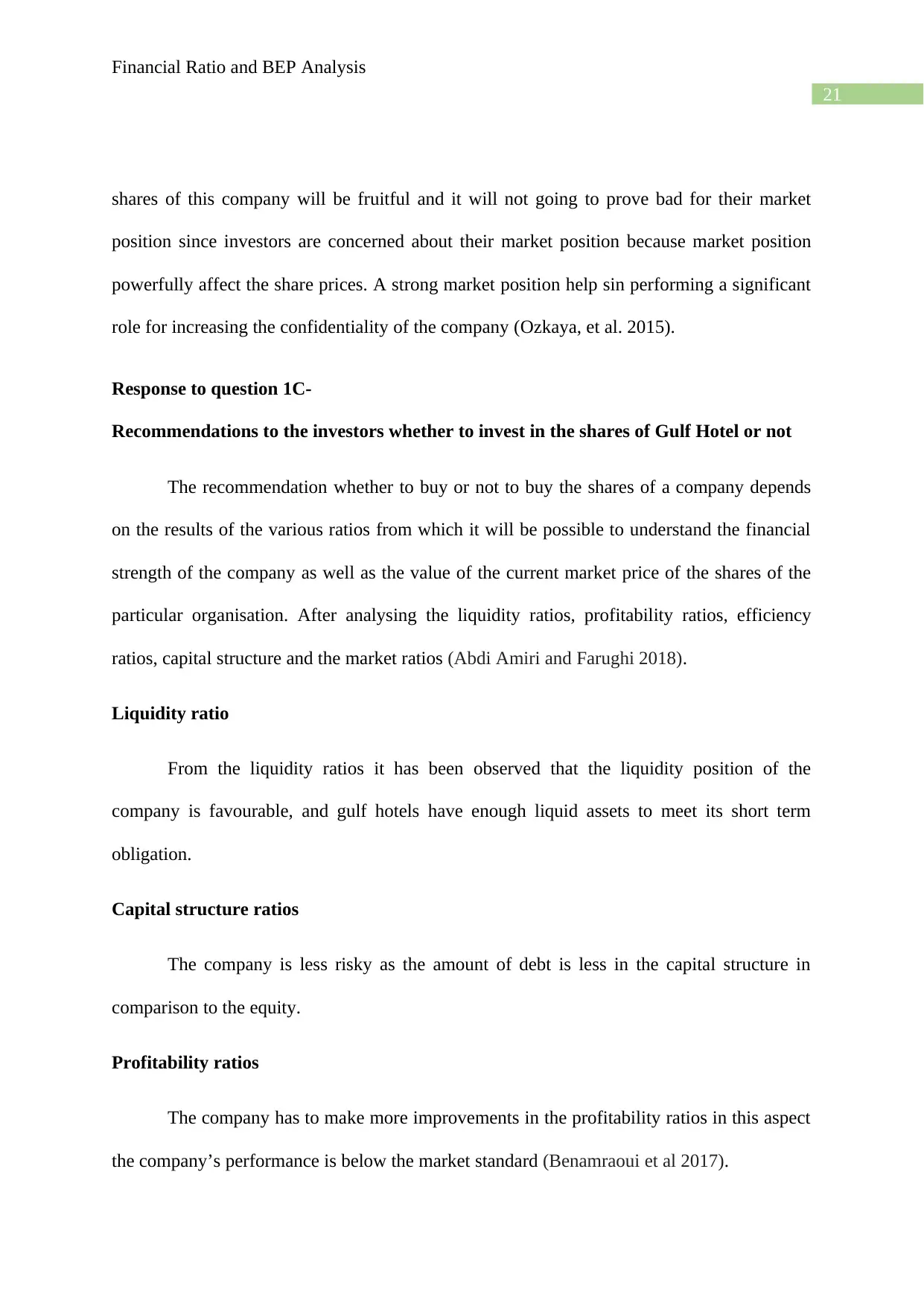
21
Financial Ratio and BEP Analysis
shares of this company will be fruitful and it will not going to prove bad for their market
position since investors are concerned about their market position because market position
powerfully affect the share prices. A strong market position help sin performing a significant
role for increasing the confidentiality of the company (Ozkaya, et al. 2015).
Response to question 1C-
Recommendations to the investors whether to invest in the shares of Gulf Hotel or not
The recommendation whether to buy or not to buy the shares of a company depends
on the results of the various ratios from which it will be possible to understand the financial
strength of the company as well as the value of the current market price of the shares of the
particular organisation. After analysing the liquidity ratios, profitability ratios, efficiency
ratios, capital structure and the market ratios (Abdi Amiri and Farughi 2018).
Liquidity ratio
From the liquidity ratios it has been observed that the liquidity position of the
company is favourable, and gulf hotels have enough liquid assets to meet its short term
obligation.
Capital structure ratios
The company is less risky as the amount of debt is less in the capital structure in
comparison to the equity.
Profitability ratios
The company has to make more improvements in the profitability ratios in this aspect
the company’s performance is below the market standard (Benamraoui et al 2017).
Financial Ratio and BEP Analysis
shares of this company will be fruitful and it will not going to prove bad for their market
position since investors are concerned about their market position because market position
powerfully affect the share prices. A strong market position help sin performing a significant
role for increasing the confidentiality of the company (Ozkaya, et al. 2015).
Response to question 1C-
Recommendations to the investors whether to invest in the shares of Gulf Hotel or not
The recommendation whether to buy or not to buy the shares of a company depends
on the results of the various ratios from which it will be possible to understand the financial
strength of the company as well as the value of the current market price of the shares of the
particular organisation. After analysing the liquidity ratios, profitability ratios, efficiency
ratios, capital structure and the market ratios (Abdi Amiri and Farughi 2018).
Liquidity ratio
From the liquidity ratios it has been observed that the liquidity position of the
company is favourable, and gulf hotels have enough liquid assets to meet its short term
obligation.
Capital structure ratios
The company is less risky as the amount of debt is less in the capital structure in
comparison to the equity.
Profitability ratios
The company has to make more improvements in the profitability ratios in this aspect
the company’s performance is below the market standard (Benamraoui et al 2017).
Secure Best Marks with AI Grader
Need help grading? Try our AI Grader for instant feedback on your assignments.
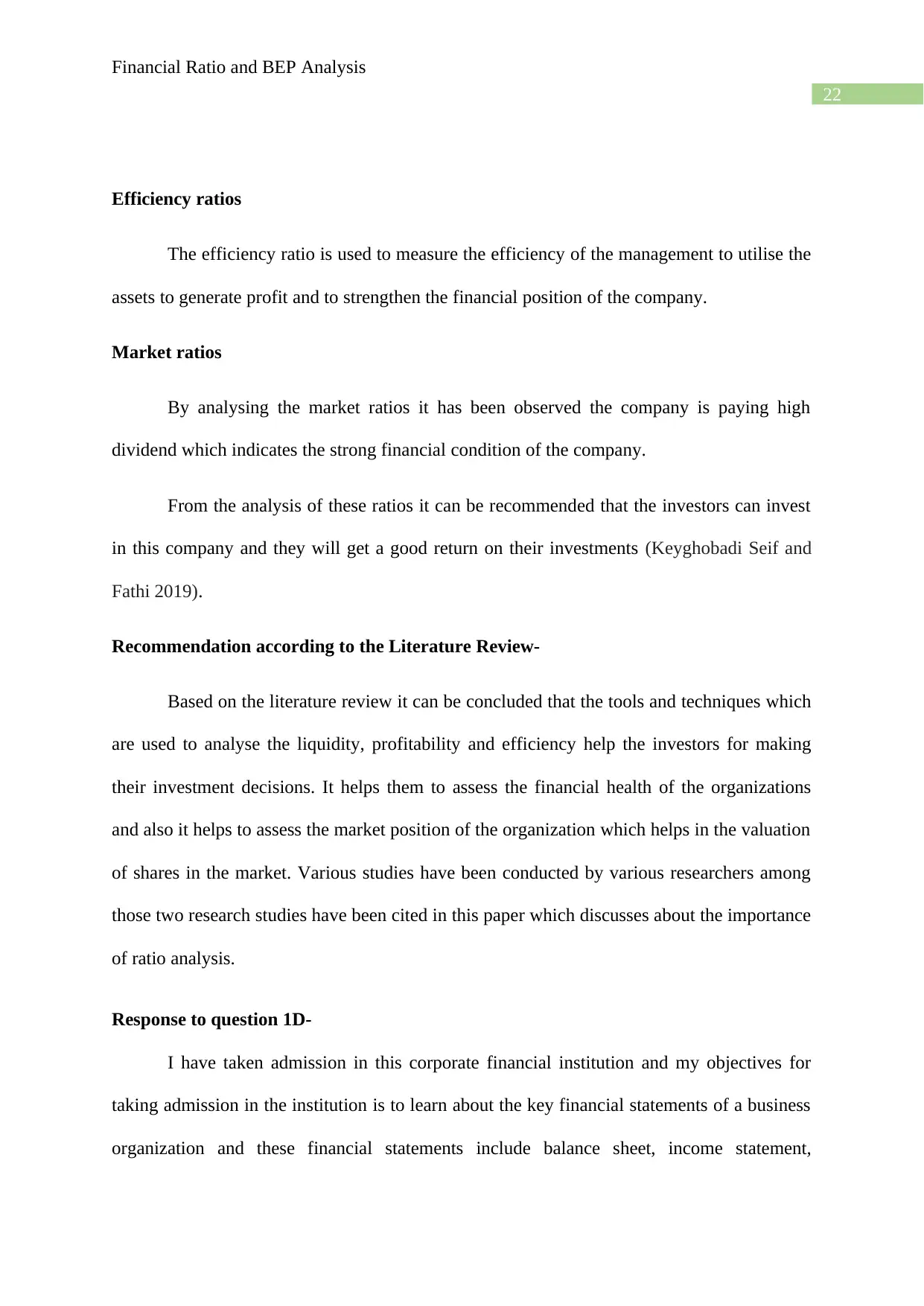
22
Financial Ratio and BEP Analysis
Efficiency ratios
The efficiency ratio is used to measure the efficiency of the management to utilise the
assets to generate profit and to strengthen the financial position of the company.
Market ratios
By analysing the market ratios it has been observed the company is paying high
dividend which indicates the strong financial condition of the company.
From the analysis of these ratios it can be recommended that the investors can invest
in this company and they will get a good return on their investments (Keyghobadi Seif and
Fathi 2019).
Recommendation according to the Literature Review-
Based on the literature review it can be concluded that the tools and techniques which
are used to analyse the liquidity, profitability and efficiency help the investors for making
their investment decisions. It helps them to assess the financial health of the organizations
and also it helps to assess the market position of the organization which helps in the valuation
of shares in the market. Various studies have been conducted by various researchers among
those two research studies have been cited in this paper which discusses about the importance
of ratio analysis.
Response to question 1D-
I have taken admission in this corporate financial institution and my objectives for
taking admission in the institution is to learn about the key financial statements of a business
organization and these financial statements include balance sheet, income statement,
Financial Ratio and BEP Analysis
Efficiency ratios
The efficiency ratio is used to measure the efficiency of the management to utilise the
assets to generate profit and to strengthen the financial position of the company.
Market ratios
By analysing the market ratios it has been observed the company is paying high
dividend which indicates the strong financial condition of the company.
From the analysis of these ratios it can be recommended that the investors can invest
in this company and they will get a good return on their investments (Keyghobadi Seif and
Fathi 2019).
Recommendation according to the Literature Review-
Based on the literature review it can be concluded that the tools and techniques which
are used to analyse the liquidity, profitability and efficiency help the investors for making
their investment decisions. It helps them to assess the financial health of the organizations
and also it helps to assess the market position of the organization which helps in the valuation
of shares in the market. Various studies have been conducted by various researchers among
those two research studies have been cited in this paper which discusses about the importance
of ratio analysis.
Response to question 1D-
I have taken admission in this corporate financial institution and my objectives for
taking admission in the institution is to learn about the key financial statements of a business
organization and these financial statements include balance sheet, income statement,
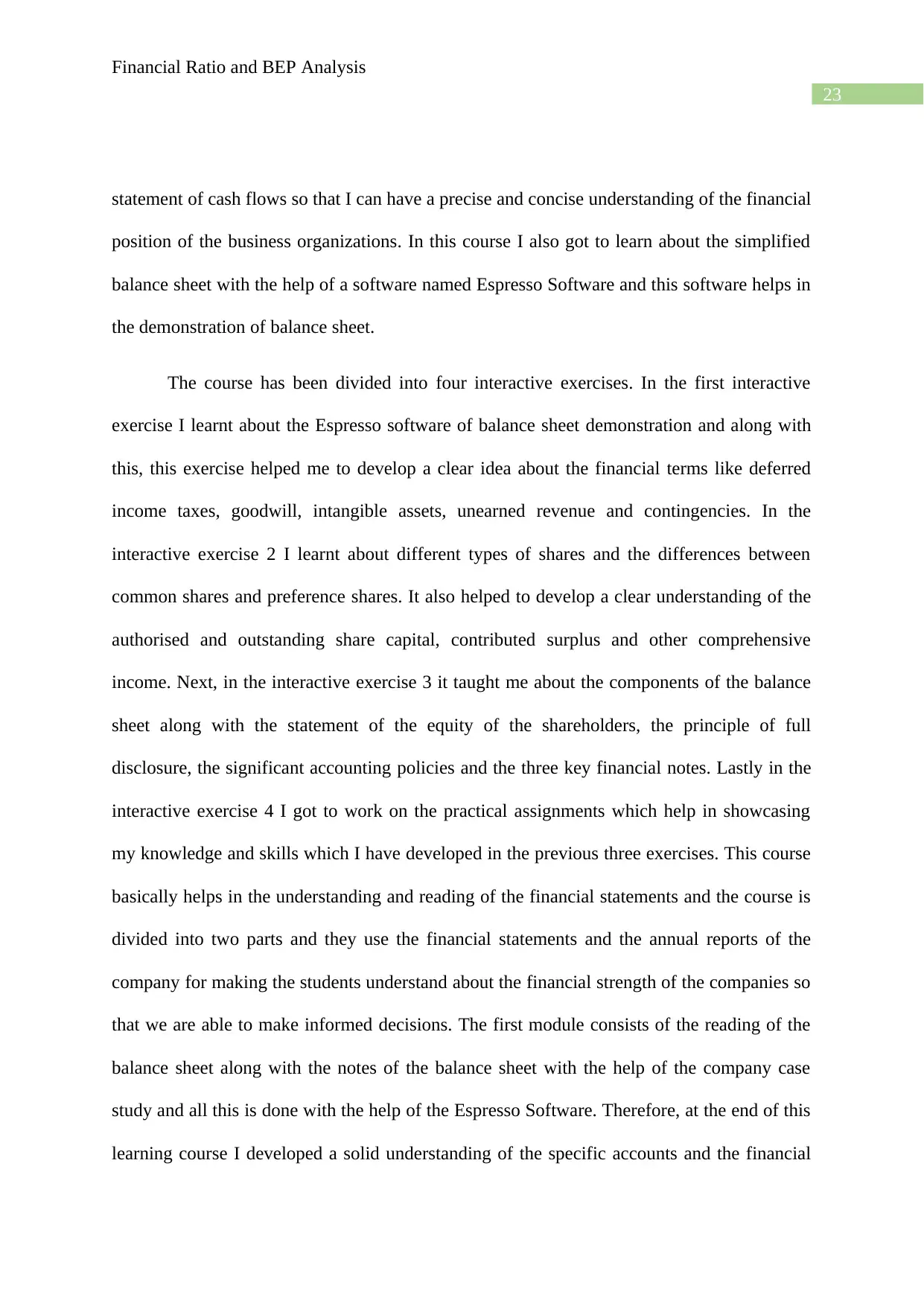
23
Financial Ratio and BEP Analysis
statement of cash flows so that I can have a precise and concise understanding of the financial
position of the business organizations. In this course I also got to learn about the simplified
balance sheet with the help of a software named Espresso Software and this software helps in
the demonstration of balance sheet.
The course has been divided into four interactive exercises. In the first interactive
exercise I learnt about the Espresso software of balance sheet demonstration and along with
this, this exercise helped me to develop a clear idea about the financial terms like deferred
income taxes, goodwill, intangible assets, unearned revenue and contingencies. In the
interactive exercise 2 I learnt about different types of shares and the differences between
common shares and preference shares. It also helped to develop a clear understanding of the
authorised and outstanding share capital, contributed surplus and other comprehensive
income. Next, in the interactive exercise 3 it taught me about the components of the balance
sheet along with the statement of the equity of the shareholders, the principle of full
disclosure, the significant accounting policies and the three key financial notes. Lastly in the
interactive exercise 4 I got to work on the practical assignments which help in showcasing
my knowledge and skills which I have developed in the previous three exercises. This course
basically helps in the understanding and reading of the financial statements and the course is
divided into two parts and they use the financial statements and the annual reports of the
company for making the students understand about the financial strength of the companies so
that we are able to make informed decisions. The first module consists of the reading of the
balance sheet along with the notes of the balance sheet with the help of the company case
study and all this is done with the help of the Espresso Software. Therefore, at the end of this
learning course I developed a solid understanding of the specific accounts and the financial
Financial Ratio and BEP Analysis
statement of cash flows so that I can have a precise and concise understanding of the financial
position of the business organizations. In this course I also got to learn about the simplified
balance sheet with the help of a software named Espresso Software and this software helps in
the demonstration of balance sheet.
The course has been divided into four interactive exercises. In the first interactive
exercise I learnt about the Espresso software of balance sheet demonstration and along with
this, this exercise helped me to develop a clear idea about the financial terms like deferred
income taxes, goodwill, intangible assets, unearned revenue and contingencies. In the
interactive exercise 2 I learnt about different types of shares and the differences between
common shares and preference shares. It also helped to develop a clear understanding of the
authorised and outstanding share capital, contributed surplus and other comprehensive
income. Next, in the interactive exercise 3 it taught me about the components of the balance
sheet along with the statement of the equity of the shareholders, the principle of full
disclosure, the significant accounting policies and the three key financial notes. Lastly in the
interactive exercise 4 I got to work on the practical assignments which help in showcasing
my knowledge and skills which I have developed in the previous three exercises. This course
basically helps in the understanding and reading of the financial statements and the course is
divided into two parts and they use the financial statements and the annual reports of the
company for making the students understand about the financial strength of the companies so
that we are able to make informed decisions. The first module consists of the reading of the
balance sheet along with the notes of the balance sheet with the help of the company case
study and all this is done with the help of the Espresso Software. Therefore, at the end of this
learning course I developed a solid understanding of the specific accounts and the financial
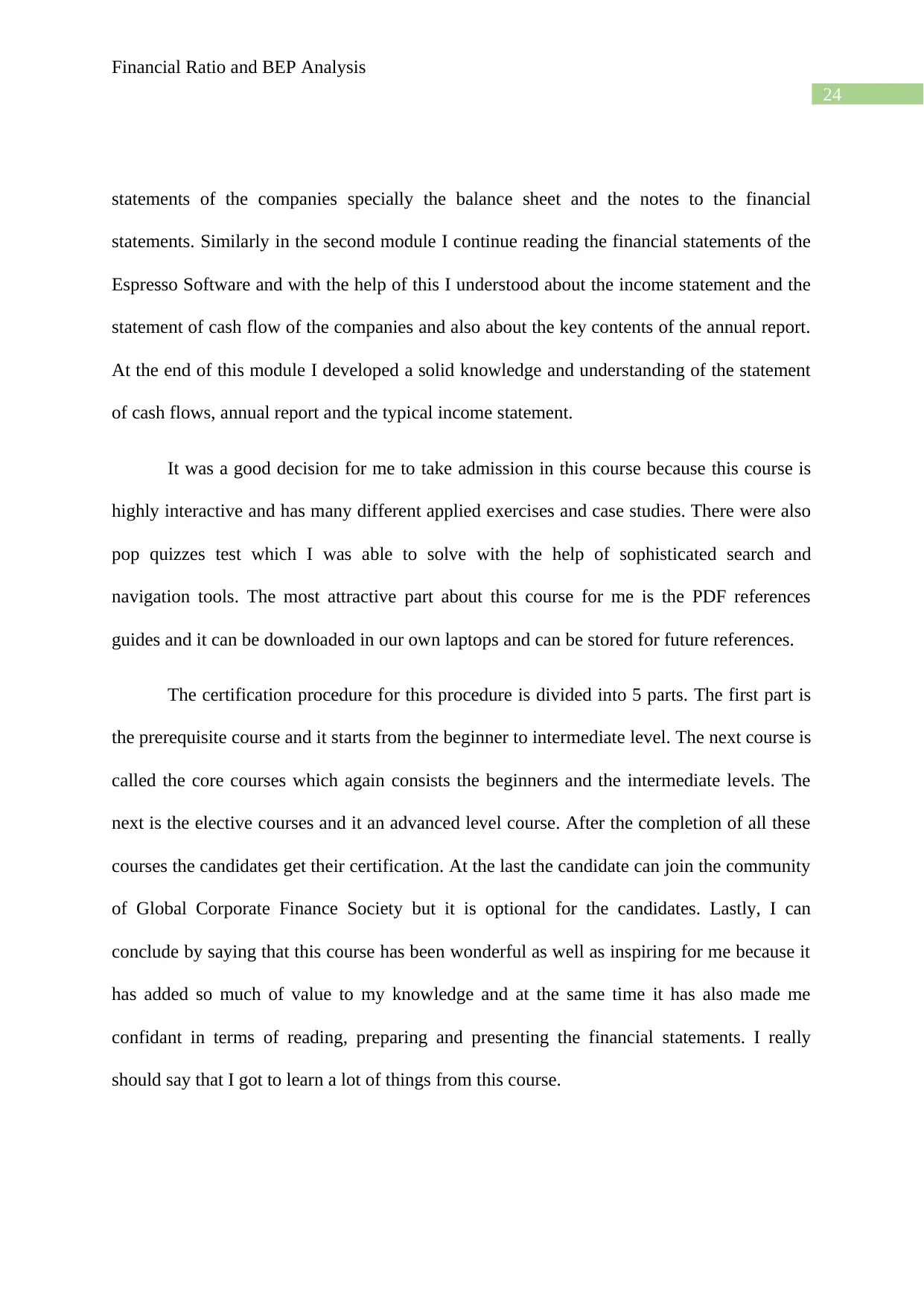
24
Financial Ratio and BEP Analysis
statements of the companies specially the balance sheet and the notes to the financial
statements. Similarly in the second module I continue reading the financial statements of the
Espresso Software and with the help of this I understood about the income statement and the
statement of cash flow of the companies and also about the key contents of the annual report.
At the end of this module I developed a solid knowledge and understanding of the statement
of cash flows, annual report and the typical income statement.
It was a good decision for me to take admission in this course because this course is
highly interactive and has many different applied exercises and case studies. There were also
pop quizzes test which I was able to solve with the help of sophisticated search and
navigation tools. The most attractive part about this course for me is the PDF references
guides and it can be downloaded in our own laptops and can be stored for future references.
The certification procedure for this procedure is divided into 5 parts. The first part is
the prerequisite course and it starts from the beginner to intermediate level. The next course is
called the core courses which again consists the beginners and the intermediate levels. The
next is the elective courses and it an advanced level course. After the completion of all these
courses the candidates get their certification. At the last the candidate can join the community
of Global Corporate Finance Society but it is optional for the candidates. Lastly, I can
conclude by saying that this course has been wonderful as well as inspiring for me because it
has added so much of value to my knowledge and at the same time it has also made me
confidant in terms of reading, preparing and presenting the financial statements. I really
should say that I got to learn a lot of things from this course.
Financial Ratio and BEP Analysis
statements of the companies specially the balance sheet and the notes to the financial
statements. Similarly in the second module I continue reading the financial statements of the
Espresso Software and with the help of this I understood about the income statement and the
statement of cash flow of the companies and also about the key contents of the annual report.
At the end of this module I developed a solid knowledge and understanding of the statement
of cash flows, annual report and the typical income statement.
It was a good decision for me to take admission in this course because this course is
highly interactive and has many different applied exercises and case studies. There were also
pop quizzes test which I was able to solve with the help of sophisticated search and
navigation tools. The most attractive part about this course for me is the PDF references
guides and it can be downloaded in our own laptops and can be stored for future references.
The certification procedure for this procedure is divided into 5 parts. The first part is
the prerequisite course and it starts from the beginner to intermediate level. The next course is
called the core courses which again consists the beginners and the intermediate levels. The
next is the elective courses and it an advanced level course. After the completion of all these
courses the candidates get their certification. At the last the candidate can join the community
of Global Corporate Finance Society but it is optional for the candidates. Lastly, I can
conclude by saying that this course has been wonderful as well as inspiring for me because it
has added so much of value to my knowledge and at the same time it has also made me
confidant in terms of reading, preparing and presenting the financial statements. I really
should say that I got to learn a lot of things from this course.
Paraphrase This Document
Need a fresh take? Get an instant paraphrase of this document with our AI Paraphraser
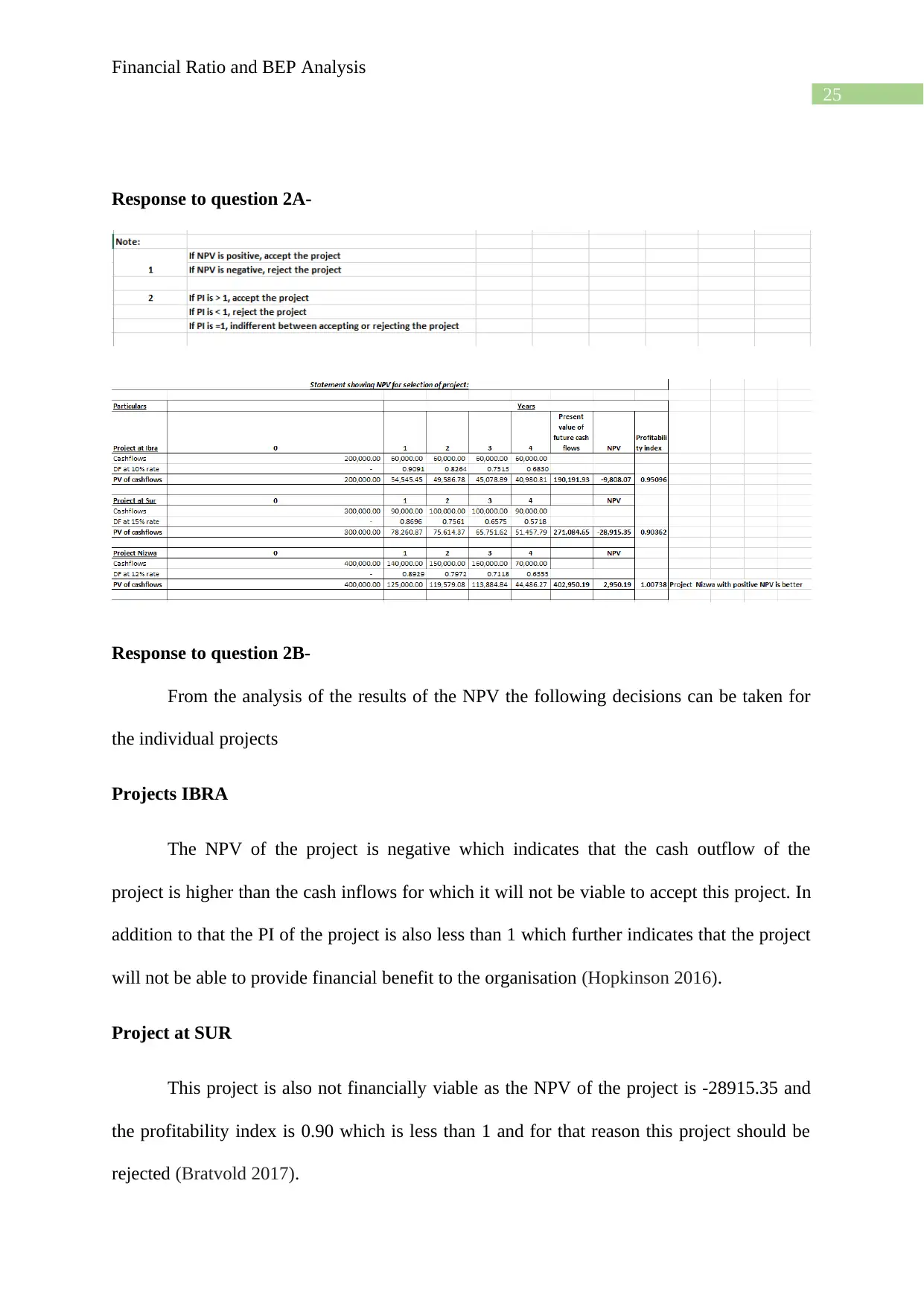
25
Financial Ratio and BEP Analysis
Response to question 2A-
Response to question 2B-
From the analysis of the results of the NPV the following decisions can be taken for
the individual projects
Projects IBRA
The NPV of the project is negative which indicates that the cash outflow of the
project is higher than the cash inflows for which it will not be viable to accept this project. In
addition to that the PI of the project is also less than 1 which further indicates that the project
will not be able to provide financial benefit to the organisation (Hopkinson 2016).
Project at SUR
This project is also not financially viable as the NPV of the project is -28915.35 and
the profitability index is 0.90 which is less than 1 and for that reason this project should be
rejected (Bratvold 2017).
Financial Ratio and BEP Analysis
Response to question 2A-
Response to question 2B-
From the analysis of the results of the NPV the following decisions can be taken for
the individual projects
Projects IBRA
The NPV of the project is negative which indicates that the cash outflow of the
project is higher than the cash inflows for which it will not be viable to accept this project. In
addition to that the PI of the project is also less than 1 which further indicates that the project
will not be able to provide financial benefit to the organisation (Hopkinson 2016).
Project at SUR
This project is also not financially viable as the NPV of the project is -28915.35 and
the profitability index is 0.90 which is less than 1 and for that reason this project should be
rejected (Bratvold 2017).
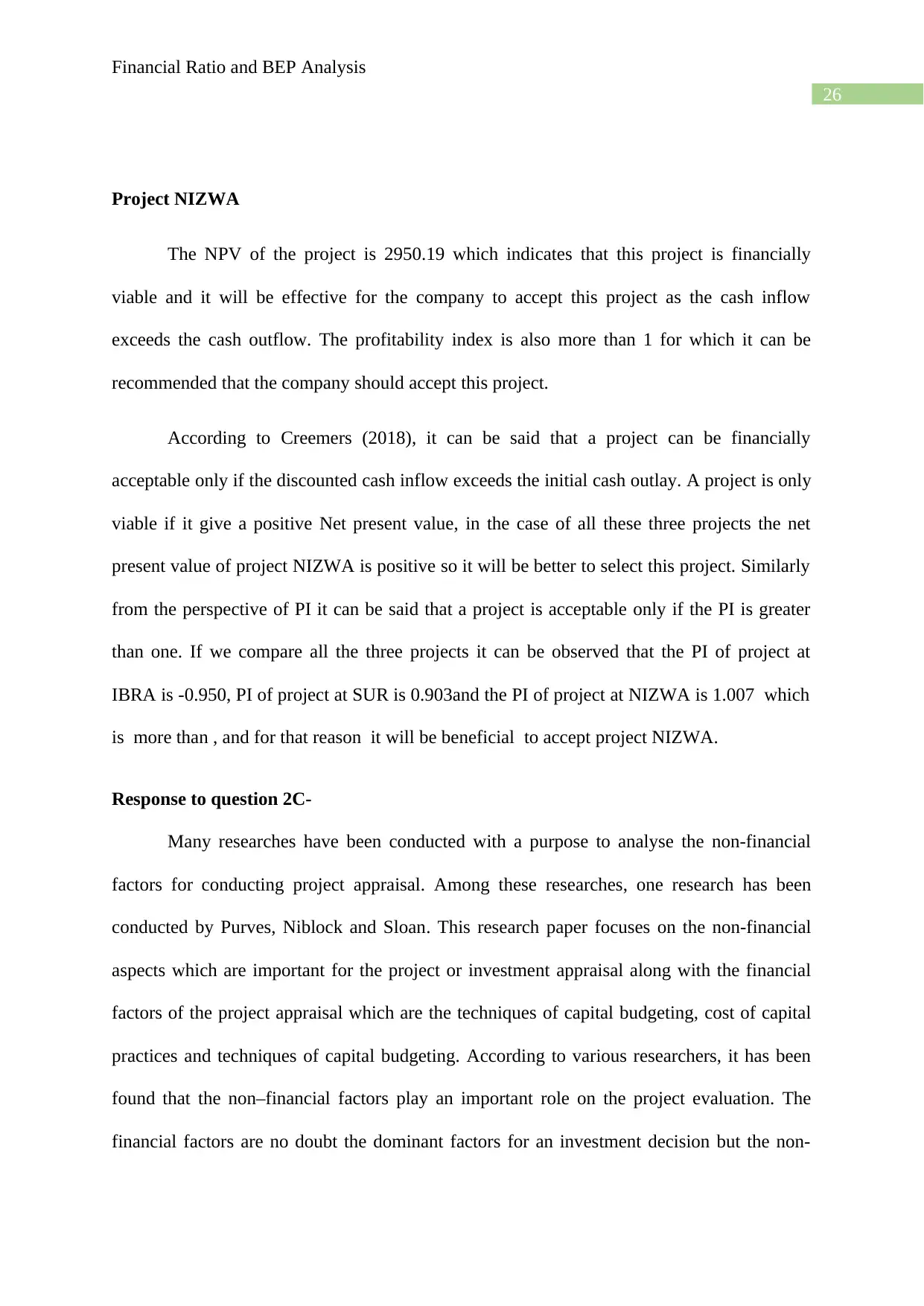
26
Financial Ratio and BEP Analysis
Project NIZWA
The NPV of the project is 2950.19 which indicates that this project is financially
viable and it will be effective for the company to accept this project as the cash inflow
exceeds the cash outflow. The profitability index is also more than 1 for which it can be
recommended that the company should accept this project.
According to Creemers (2018), it can be said that a project can be financially
acceptable only if the discounted cash inflow exceeds the initial cash outlay. A project is only
viable if it give a positive Net present value, in the case of all these three projects the net
present value of project NIZWA is positive so it will be better to select this project. Similarly
from the perspective of PI it can be said that a project is acceptable only if the PI is greater
than one. If we compare all the three projects it can be observed that the PI of project at
IBRA is -0.950, PI of project at SUR is 0.903and the PI of project at NIZWA is 1.007 which
is more than , and for that reason it will be beneficial to accept project NIZWA.
Response to question 2C-
Many researches have been conducted with a purpose to analyse the non-financial
factors for conducting project appraisal. Among these researches, one research has been
conducted by Purves, Niblock and Sloan. This research paper focuses on the non-financial
aspects which are important for the project or investment appraisal along with the financial
factors of the project appraisal which are the techniques of capital budgeting, cost of capital
practices and techniques of capital budgeting. According to various researchers, it has been
found that the non–financial factors play an important role on the project evaluation. The
financial factors are no doubt the dominant factors for an investment decision but the non-
Financial Ratio and BEP Analysis
Project NIZWA
The NPV of the project is 2950.19 which indicates that this project is financially
viable and it will be effective for the company to accept this project as the cash inflow
exceeds the cash outflow. The profitability index is also more than 1 for which it can be
recommended that the company should accept this project.
According to Creemers (2018), it can be said that a project can be financially
acceptable only if the discounted cash inflow exceeds the initial cash outlay. A project is only
viable if it give a positive Net present value, in the case of all these three projects the net
present value of project NIZWA is positive so it will be better to select this project. Similarly
from the perspective of PI it can be said that a project is acceptable only if the PI is greater
than one. If we compare all the three projects it can be observed that the PI of project at
IBRA is -0.950, PI of project at SUR is 0.903and the PI of project at NIZWA is 1.007 which
is more than , and for that reason it will be beneficial to accept project NIZWA.
Response to question 2C-
Many researches have been conducted with a purpose to analyse the non-financial
factors for conducting project appraisal. Among these researches, one research has been
conducted by Purves, Niblock and Sloan. This research paper focuses on the non-financial
aspects which are important for the project or investment appraisal along with the financial
factors of the project appraisal which are the techniques of capital budgeting, cost of capital
practices and techniques of capital budgeting. According to various researchers, it has been
found that the non–financial factors play an important role on the project evaluation. The
financial factors are no doubt the dominant factors for an investment decision but the non-
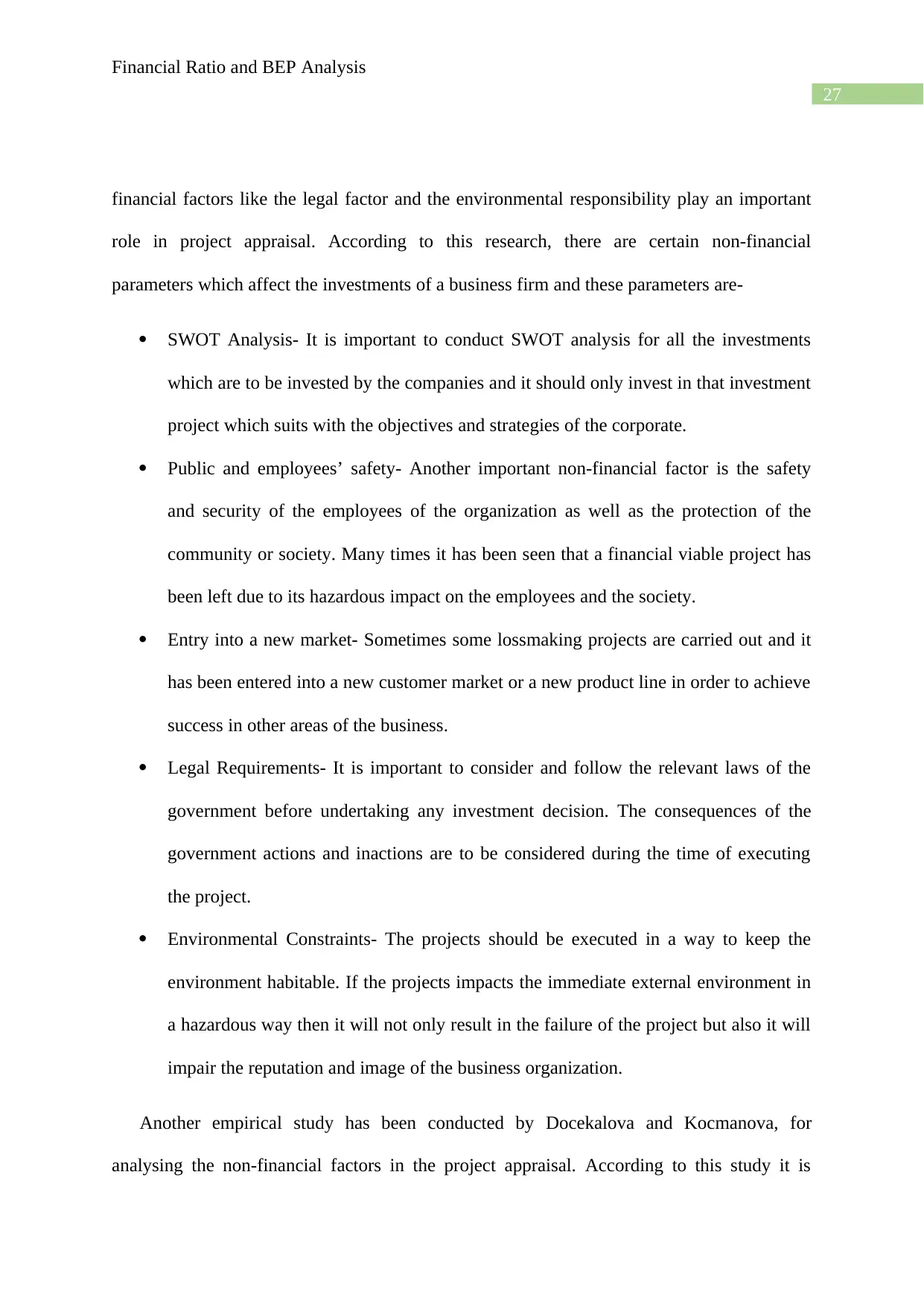
27
Financial Ratio and BEP Analysis
financial factors like the legal factor and the environmental responsibility play an important
role in project appraisal. According to this research, there are certain non-financial
parameters which affect the investments of a business firm and these parameters are-
SWOT Analysis- It is important to conduct SWOT analysis for all the investments
which are to be invested by the companies and it should only invest in that investment
project which suits with the objectives and strategies of the corporate.
Public and employees’ safety- Another important non-financial factor is the safety
and security of the employees of the organization as well as the protection of the
community or society. Many times it has been seen that a financial viable project has
been left due to its hazardous impact on the employees and the society.
Entry into a new market- Sometimes some lossmaking projects are carried out and it
has been entered into a new customer market or a new product line in order to achieve
success in other areas of the business.
Legal Requirements- It is important to consider and follow the relevant laws of the
government before undertaking any investment decision. The consequences of the
government actions and inactions are to be considered during the time of executing
the project.
Environmental Constraints- The projects should be executed in a way to keep the
environment habitable. If the projects impacts the immediate external environment in
a hazardous way then it will not only result in the failure of the project but also it will
impair the reputation and image of the business organization.
Another empirical study has been conducted by Docekalova and Kocmanova, for
analysing the non-financial factors in the project appraisal. According to this study it is
Financial Ratio and BEP Analysis
financial factors like the legal factor and the environmental responsibility play an important
role in project appraisal. According to this research, there are certain non-financial
parameters which affect the investments of a business firm and these parameters are-
SWOT Analysis- It is important to conduct SWOT analysis for all the investments
which are to be invested by the companies and it should only invest in that investment
project which suits with the objectives and strategies of the corporate.
Public and employees’ safety- Another important non-financial factor is the safety
and security of the employees of the organization as well as the protection of the
community or society. Many times it has been seen that a financial viable project has
been left due to its hazardous impact on the employees and the society.
Entry into a new market- Sometimes some lossmaking projects are carried out and it
has been entered into a new customer market or a new product line in order to achieve
success in other areas of the business.
Legal Requirements- It is important to consider and follow the relevant laws of the
government before undertaking any investment decision. The consequences of the
government actions and inactions are to be considered during the time of executing
the project.
Environmental Constraints- The projects should be executed in a way to keep the
environment habitable. If the projects impacts the immediate external environment in
a hazardous way then it will not only result in the failure of the project but also it will
impair the reputation and image of the business organization.
Another empirical study has been conducted by Docekalova and Kocmanova, for
analysing the non-financial factors in the project appraisal. According to this study it is
Secure Best Marks with AI Grader
Need help grading? Try our AI Grader for instant feedback on your assignments.
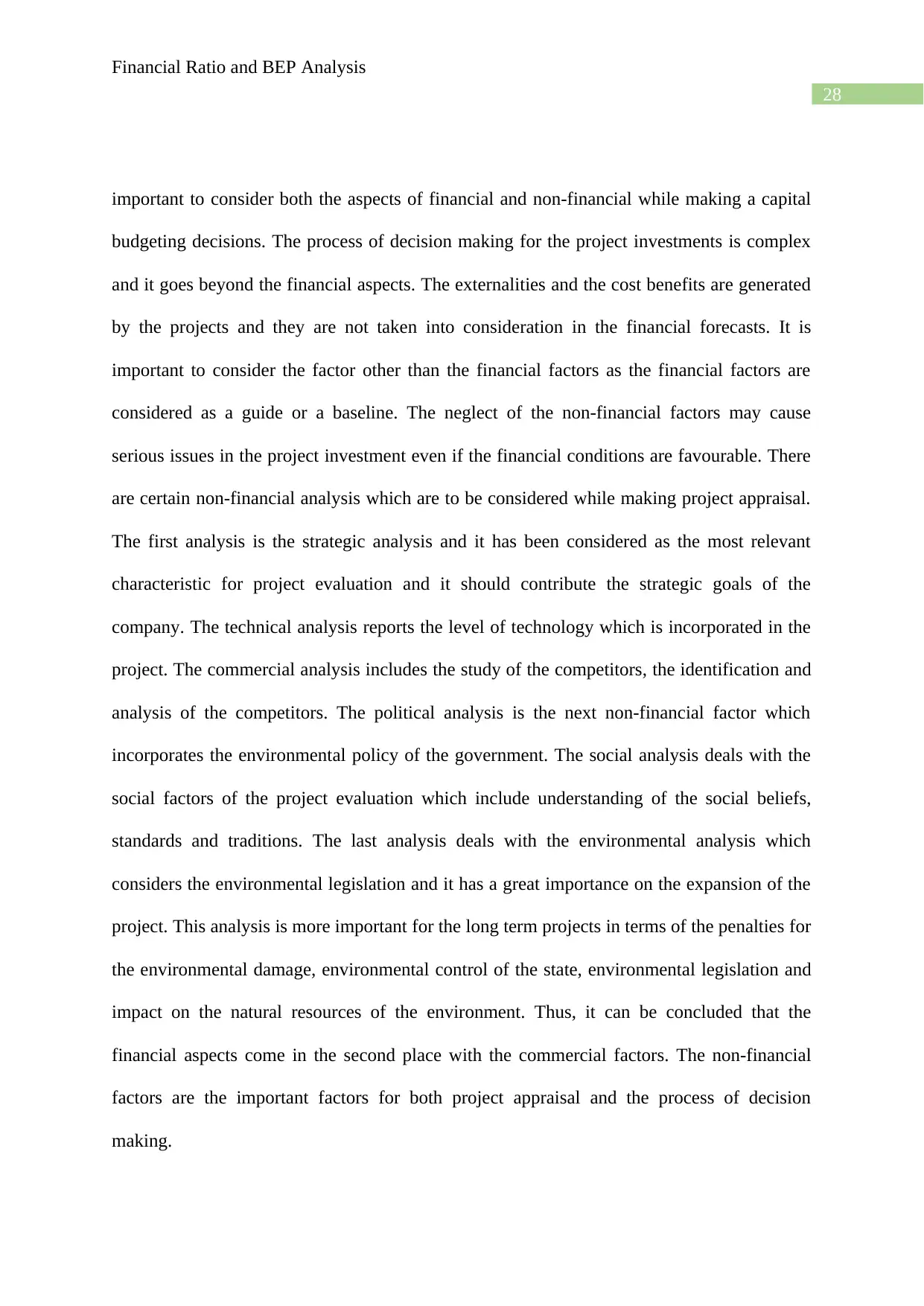
28
Financial Ratio and BEP Analysis
important to consider both the aspects of financial and non-financial while making a capital
budgeting decisions. The process of decision making for the project investments is complex
and it goes beyond the financial aspects. The externalities and the cost benefits are generated
by the projects and they are not taken into consideration in the financial forecasts. It is
important to consider the factor other than the financial factors as the financial factors are
considered as a guide or a baseline. The neglect of the non-financial factors may cause
serious issues in the project investment even if the financial conditions are favourable. There
are certain non-financial analysis which are to be considered while making project appraisal.
The first analysis is the strategic analysis and it has been considered as the most relevant
characteristic for project evaluation and it should contribute the strategic goals of the
company. The technical analysis reports the level of technology which is incorporated in the
project. The commercial analysis includes the study of the competitors, the identification and
analysis of the competitors. The political analysis is the next non-financial factor which
incorporates the environmental policy of the government. The social analysis deals with the
social factors of the project evaluation which include understanding of the social beliefs,
standards and traditions. The last analysis deals with the environmental analysis which
considers the environmental legislation and it has a great importance on the expansion of the
project. This analysis is more important for the long term projects in terms of the penalties for
the environmental damage, environmental control of the state, environmental legislation and
impact on the natural resources of the environment. Thus, it can be concluded that the
financial aspects come in the second place with the commercial factors. The non-financial
factors are the important factors for both project appraisal and the process of decision
making.
Financial Ratio and BEP Analysis
important to consider both the aspects of financial and non-financial while making a capital
budgeting decisions. The process of decision making for the project investments is complex
and it goes beyond the financial aspects. The externalities and the cost benefits are generated
by the projects and they are not taken into consideration in the financial forecasts. It is
important to consider the factor other than the financial factors as the financial factors are
considered as a guide or a baseline. The neglect of the non-financial factors may cause
serious issues in the project investment even if the financial conditions are favourable. There
are certain non-financial analysis which are to be considered while making project appraisal.
The first analysis is the strategic analysis and it has been considered as the most relevant
characteristic for project evaluation and it should contribute the strategic goals of the
company. The technical analysis reports the level of technology which is incorporated in the
project. The commercial analysis includes the study of the competitors, the identification and
analysis of the competitors. The political analysis is the next non-financial factor which
incorporates the environmental policy of the government. The social analysis deals with the
social factors of the project evaluation which include understanding of the social beliefs,
standards and traditions. The last analysis deals with the environmental analysis which
considers the environmental legislation and it has a great importance on the expansion of the
project. This analysis is more important for the long term projects in terms of the penalties for
the environmental damage, environmental control of the state, environmental legislation and
impact on the natural resources of the environment. Thus, it can be concluded that the
financial aspects come in the second place with the commercial factors. The non-financial
factors are the important factors for both project appraisal and the process of decision
making.
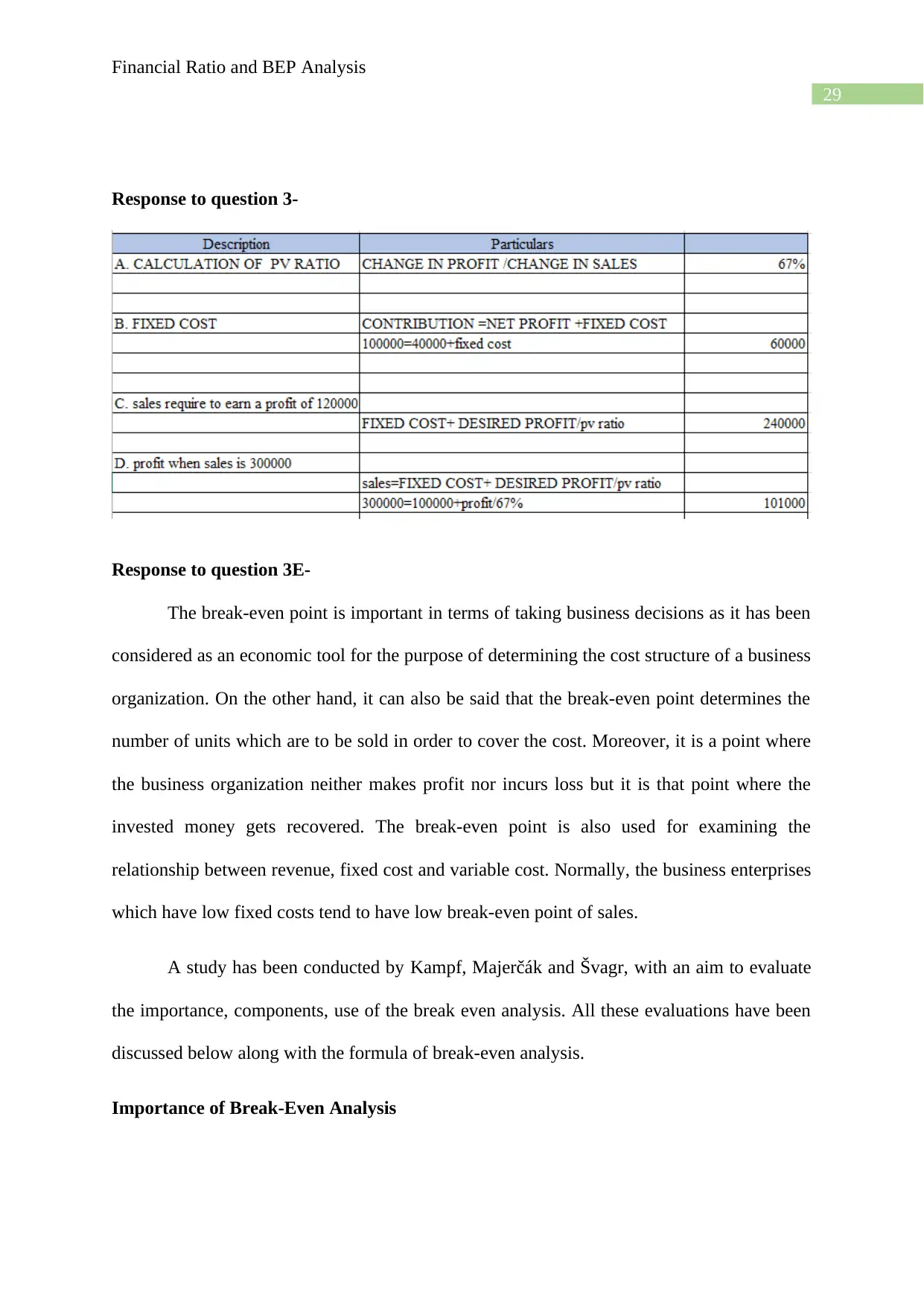
29
Financial Ratio and BEP Analysis
Response to question 3-
Response to question 3E-
The break-even point is important in terms of taking business decisions as it has been
considered as an economic tool for the purpose of determining the cost structure of a business
organization. On the other hand, it can also be said that the break-even point determines the
number of units which are to be sold in order to cover the cost. Moreover, it is a point where
the business organization neither makes profit nor incurs loss but it is that point where the
invested money gets recovered. The break-even point is also used for examining the
relationship between revenue, fixed cost and variable cost. Normally, the business enterprises
which have low fixed costs tend to have low break-even point of sales.
A study has been conducted by Kampf, Majerčák and Švagr, with an aim to evaluate
the importance, components, use of the break even analysis. All these evaluations have been
discussed below along with the formula of break-even analysis.
Importance of Break-Even Analysis
Financial Ratio and BEP Analysis
Response to question 3-
Response to question 3E-
The break-even point is important in terms of taking business decisions as it has been
considered as an economic tool for the purpose of determining the cost structure of a business
organization. On the other hand, it can also be said that the break-even point determines the
number of units which are to be sold in order to cover the cost. Moreover, it is a point where
the business organization neither makes profit nor incurs loss but it is that point where the
invested money gets recovered. The break-even point is also used for examining the
relationship between revenue, fixed cost and variable cost. Normally, the business enterprises
which have low fixed costs tend to have low break-even point of sales.
A study has been conducted by Kampf, Majerčák and Švagr, with an aim to evaluate
the importance, components, use of the break even analysis. All these evaluations have been
discussed below along with the formula of break-even analysis.
Importance of Break-Even Analysis
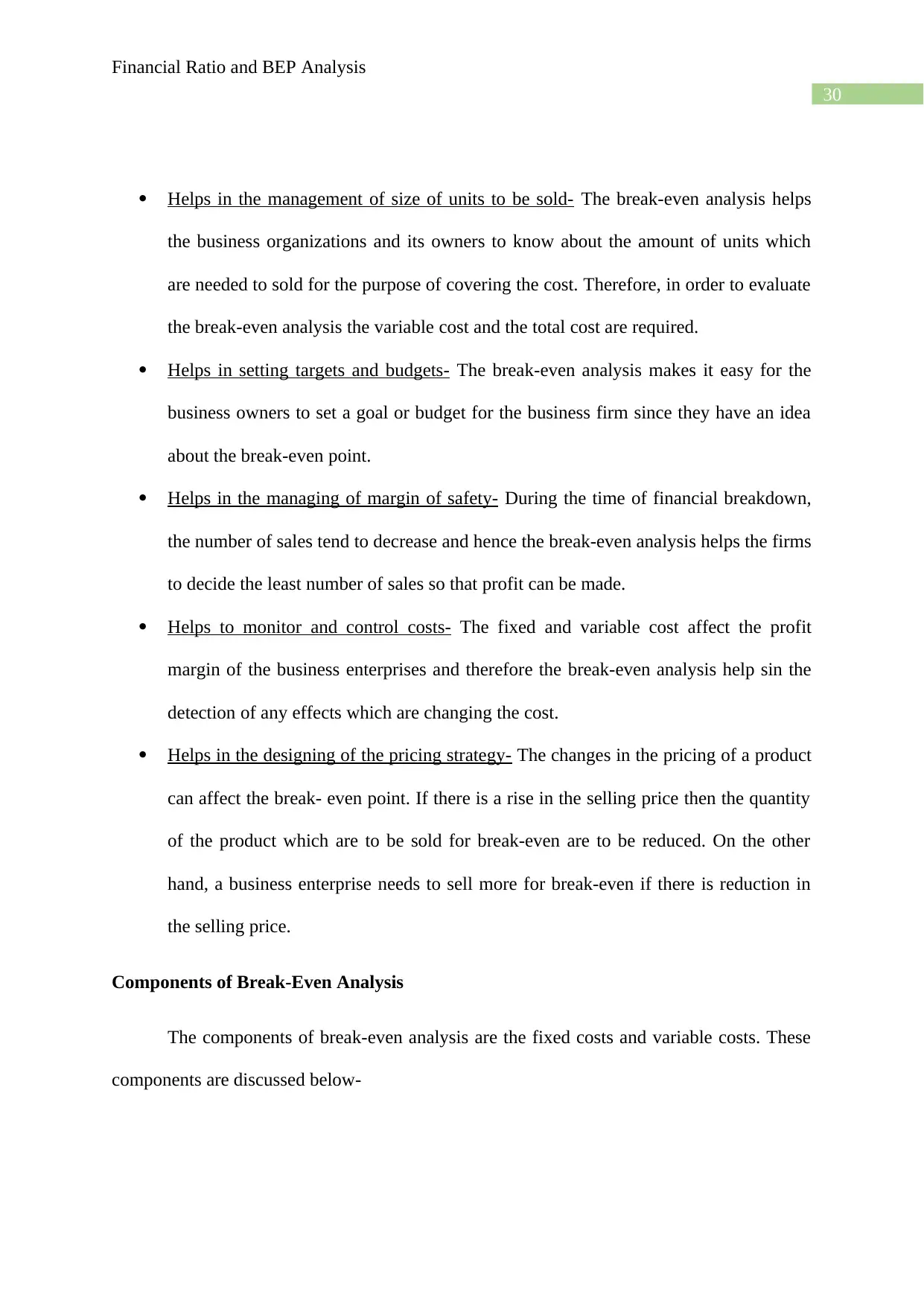
30
Financial Ratio and BEP Analysis
Helps in the management of size of units to be sold- The break-even analysis helps
the business organizations and its owners to know about the amount of units which
are needed to sold for the purpose of covering the cost. Therefore, in order to evaluate
the break-even analysis the variable cost and the total cost are required.
Helps in setting targets and budgets- The break-even analysis makes it easy for the
business owners to set a goal or budget for the business firm since they have an idea
about the break-even point.
Helps in the managing of margin of safety- During the time of financial breakdown,
the number of sales tend to decrease and hence the break-even analysis helps the firms
to decide the least number of sales so that profit can be made.
Helps to monitor and control costs- The fixed and variable cost affect the profit
margin of the business enterprises and therefore the break-even analysis help sin the
detection of any effects which are changing the cost.
Helps in the designing of the pricing strategy- The changes in the pricing of a product
can affect the break- even point. If there is a rise in the selling price then the quantity
of the product which are to be sold for break-even are to be reduced. On the other
hand, a business enterprise needs to sell more for break-even if there is reduction in
the selling price.
Components of Break-Even Analysis
The components of break-even analysis are the fixed costs and variable costs. These
components are discussed below-
Financial Ratio and BEP Analysis
Helps in the management of size of units to be sold- The break-even analysis helps
the business organizations and its owners to know about the amount of units which
are needed to sold for the purpose of covering the cost. Therefore, in order to evaluate
the break-even analysis the variable cost and the total cost are required.
Helps in setting targets and budgets- The break-even analysis makes it easy for the
business owners to set a goal or budget for the business firm since they have an idea
about the break-even point.
Helps in the managing of margin of safety- During the time of financial breakdown,
the number of sales tend to decrease and hence the break-even analysis helps the firms
to decide the least number of sales so that profit can be made.
Helps to monitor and control costs- The fixed and variable cost affect the profit
margin of the business enterprises and therefore the break-even analysis help sin the
detection of any effects which are changing the cost.
Helps in the designing of the pricing strategy- The changes in the pricing of a product
can affect the break- even point. If there is a rise in the selling price then the quantity
of the product which are to be sold for break-even are to be reduced. On the other
hand, a business enterprise needs to sell more for break-even if there is reduction in
the selling price.
Components of Break-Even Analysis
The components of break-even analysis are the fixed costs and variable costs. These
components are discussed below-
Paraphrase This Document
Need a fresh take? Get an instant paraphrase of this document with our AI Paraphraser
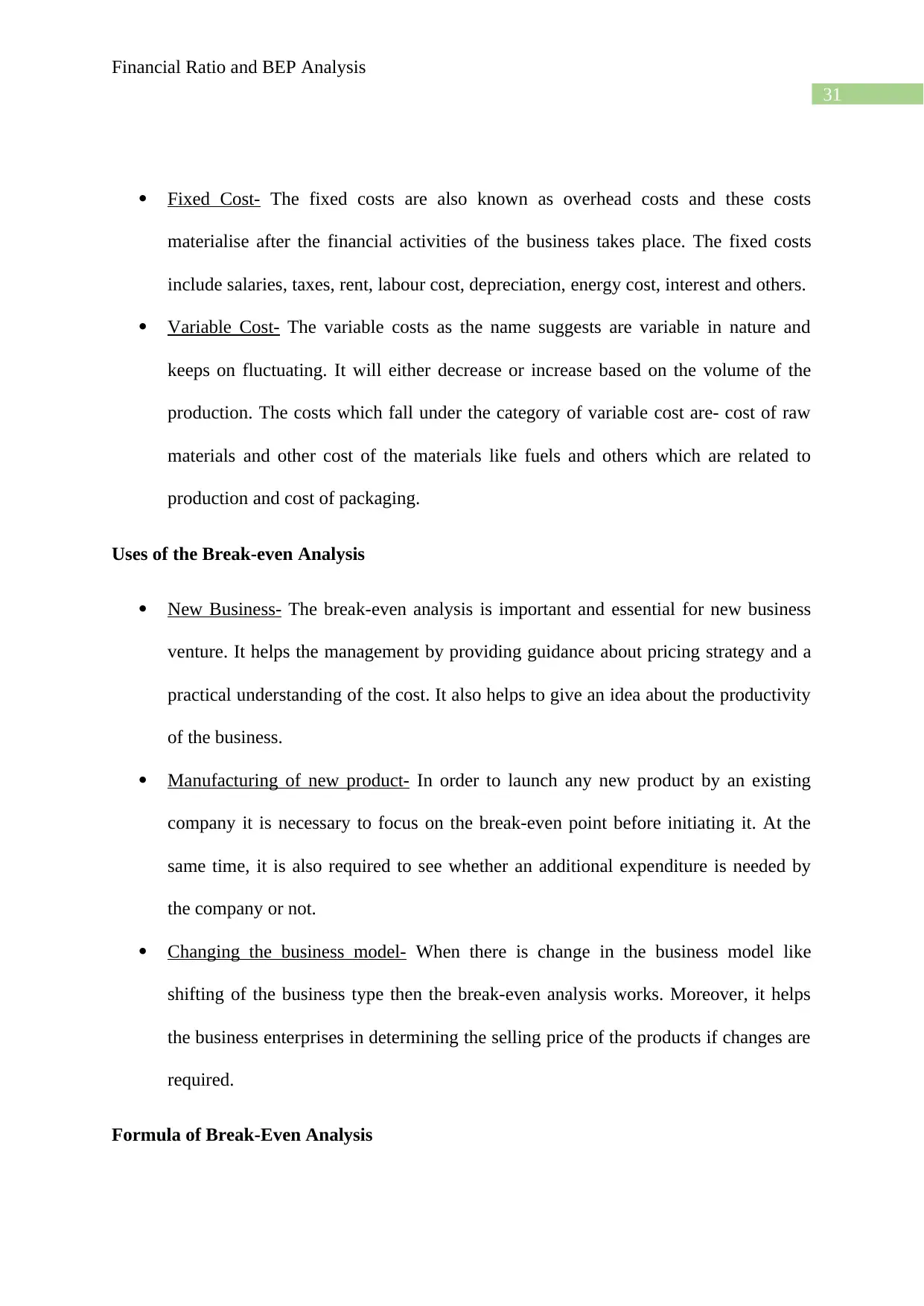
31
Financial Ratio and BEP Analysis
Fixed Cost- The fixed costs are also known as overhead costs and these costs
materialise after the financial activities of the business takes place. The fixed costs
include salaries, taxes, rent, labour cost, depreciation, energy cost, interest and others.
Variable Cost- The variable costs as the name suggests are variable in nature and
keeps on fluctuating. It will either decrease or increase based on the volume of the
production. The costs which fall under the category of variable cost are- cost of raw
materials and other cost of the materials like fuels and others which are related to
production and cost of packaging.
Uses of the Break-even Analysis
New Business- The break-even analysis is important and essential for new business
venture. It helps the management by providing guidance about pricing strategy and a
practical understanding of the cost. It also helps to give an idea about the productivity
of the business.
Manufacturing of new product- In order to launch any new product by an existing
company it is necessary to focus on the break-even point before initiating it. At the
same time, it is also required to see whether an additional expenditure is needed by
the company or not.
Changing the business model- When there is change in the business model like
shifting of the business type then the break-even analysis works. Moreover, it helps
the business enterprises in determining the selling price of the products if changes are
required.
Formula of Break-Even Analysis
Financial Ratio and BEP Analysis
Fixed Cost- The fixed costs are also known as overhead costs and these costs
materialise after the financial activities of the business takes place. The fixed costs
include salaries, taxes, rent, labour cost, depreciation, energy cost, interest and others.
Variable Cost- The variable costs as the name suggests are variable in nature and
keeps on fluctuating. It will either decrease or increase based on the volume of the
production. The costs which fall under the category of variable cost are- cost of raw
materials and other cost of the materials like fuels and others which are related to
production and cost of packaging.
Uses of the Break-even Analysis
New Business- The break-even analysis is important and essential for new business
venture. It helps the management by providing guidance about pricing strategy and a
practical understanding of the cost. It also helps to give an idea about the productivity
of the business.
Manufacturing of new product- In order to launch any new product by an existing
company it is necessary to focus on the break-even point before initiating it. At the
same time, it is also required to see whether an additional expenditure is needed by
the company or not.
Changing the business model- When there is change in the business model like
shifting of the business type then the break-even analysis works. Moreover, it helps
the business enterprises in determining the selling price of the products if changes are
required.
Formula of Break-Even Analysis
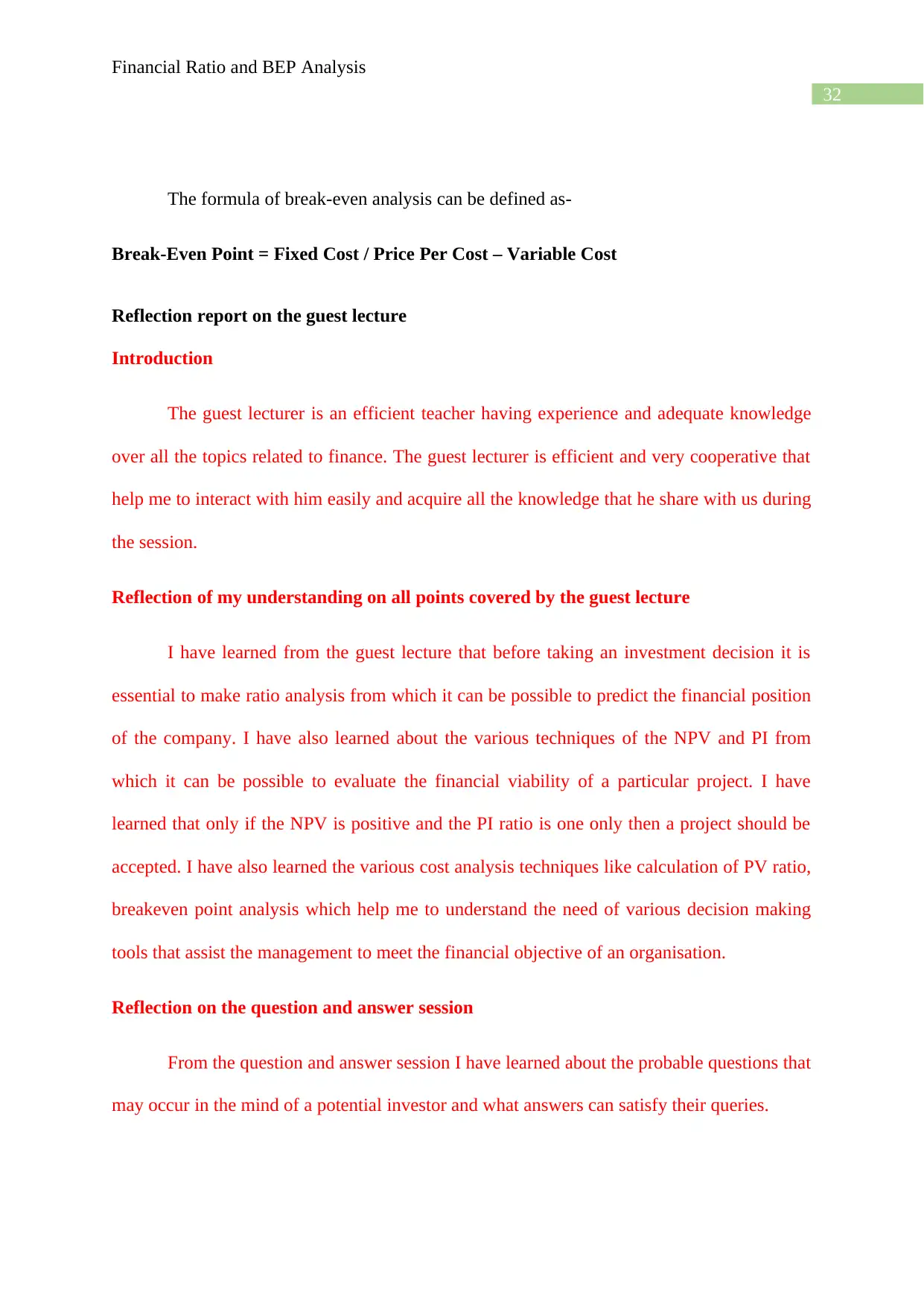
32
Financial Ratio and BEP Analysis
The formula of break-even analysis can be defined as-
Break-Even Point = Fixed Cost / Price Per Cost – Variable Cost
Reflection report on the guest lecture
Introduction
The guest lecturer is an efficient teacher having experience and adequate knowledge
over all the topics related to finance. The guest lecturer is efficient and very cooperative that
help me to interact with him easily and acquire all the knowledge that he share with us during
the session.
Reflection of my understanding on all points covered by the guest lecture
I have learned from the guest lecture that before taking an investment decision it is
essential to make ratio analysis from which it can be possible to predict the financial position
of the company. I have also learned about the various techniques of the NPV and PI from
which it can be possible to evaluate the financial viability of a particular project. I have
learned that only if the NPV is positive and the PI ratio is one only then a project should be
accepted. I have also learned the various cost analysis techniques like calculation of PV ratio,
breakeven point analysis which help me to understand the need of various decision making
tools that assist the management to meet the financial objective of an organisation.
Reflection on the question and answer session
From the question and answer session I have learned about the probable questions that
may occur in the mind of a potential investor and what answers can satisfy their queries.
Financial Ratio and BEP Analysis
The formula of break-even analysis can be defined as-
Break-Even Point = Fixed Cost / Price Per Cost – Variable Cost
Reflection report on the guest lecture
Introduction
The guest lecturer is an efficient teacher having experience and adequate knowledge
over all the topics related to finance. The guest lecturer is efficient and very cooperative that
help me to interact with him easily and acquire all the knowledge that he share with us during
the session.
Reflection of my understanding on all points covered by the guest lecture
I have learned from the guest lecture that before taking an investment decision it is
essential to make ratio analysis from which it can be possible to predict the financial position
of the company. I have also learned about the various techniques of the NPV and PI from
which it can be possible to evaluate the financial viability of a particular project. I have
learned that only if the NPV is positive and the PI ratio is one only then a project should be
accepted. I have also learned the various cost analysis techniques like calculation of PV ratio,
breakeven point analysis which help me to understand the need of various decision making
tools that assist the management to meet the financial objective of an organisation.
Reflection on the question and answer session
From the question and answer session I have learned about the probable questions that
may occur in the mind of a potential investor and what answers can satisfy their queries.
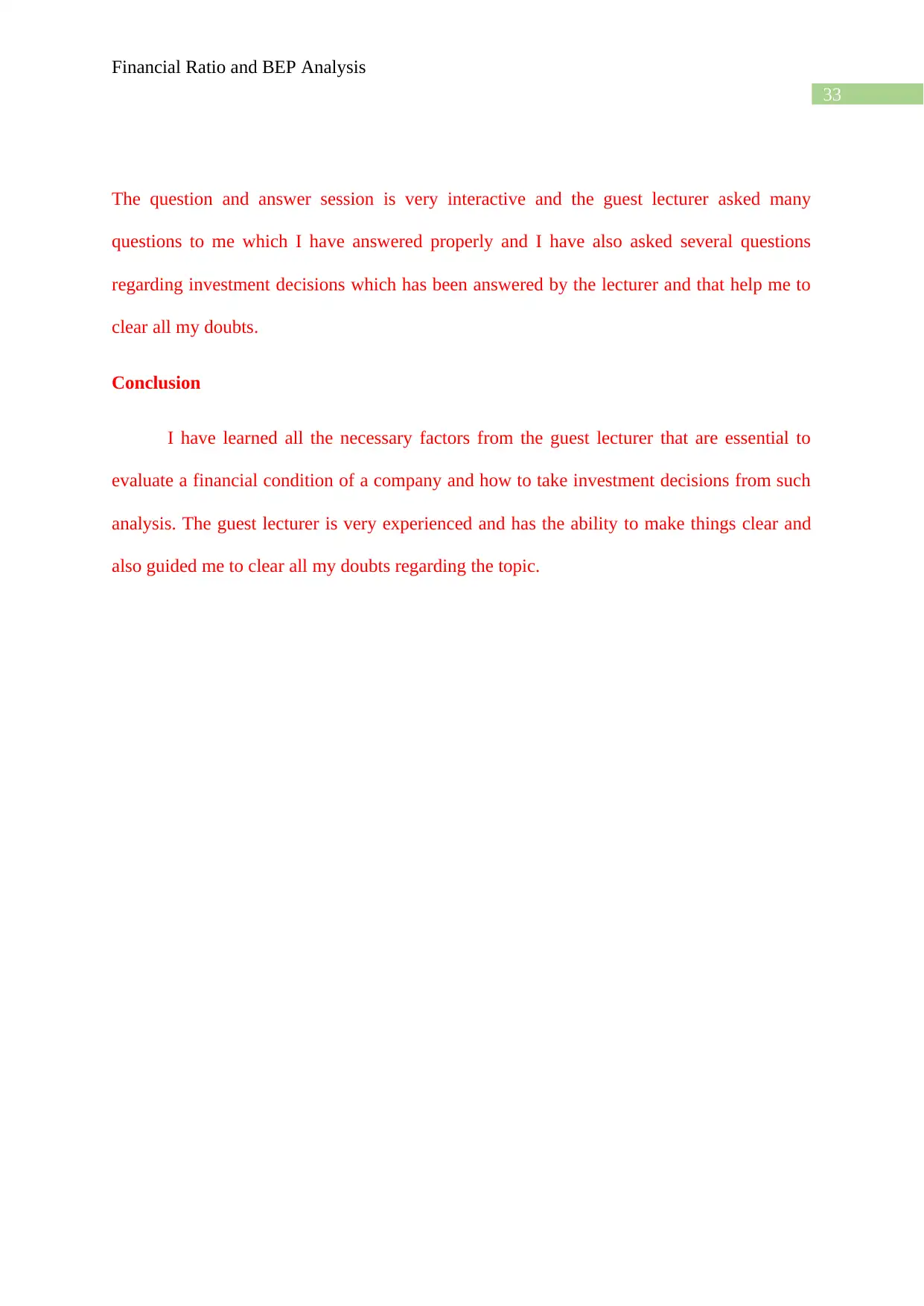
33
Financial Ratio and BEP Analysis
The question and answer session is very interactive and the guest lecturer asked many
questions to me which I have answered properly and I have also asked several questions
regarding investment decisions which has been answered by the lecturer and that help me to
clear all my doubts.
Conclusion
I have learned all the necessary factors from the guest lecturer that are essential to
evaluate a financial condition of a company and how to take investment decisions from such
analysis. The guest lecturer is very experienced and has the ability to make things clear and
also guided me to clear all my doubts regarding the topic.
Financial Ratio and BEP Analysis
The question and answer session is very interactive and the guest lecturer asked many
questions to me which I have answered properly and I have also asked several questions
regarding investment decisions which has been answered by the lecturer and that help me to
clear all my doubts.
Conclusion
I have learned all the necessary factors from the guest lecturer that are essential to
evaluate a financial condition of a company and how to take investment decisions from such
analysis. The guest lecturer is very experienced and has the ability to make things clear and
also guided me to clear all my doubts regarding the topic.
Secure Best Marks with AI Grader
Need help grading? Try our AI Grader for instant feedback on your assignments.
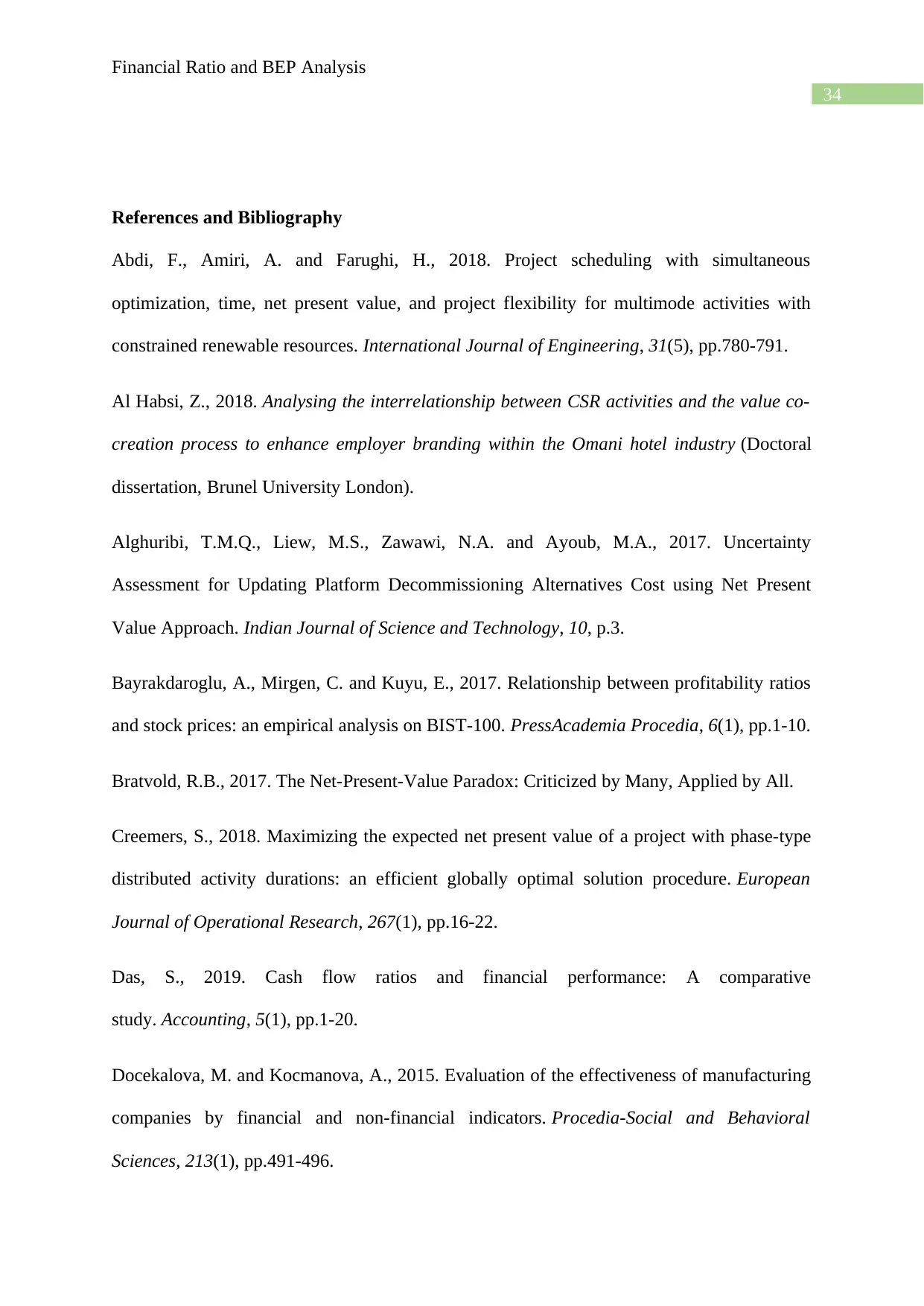
34
Financial Ratio and BEP Analysis
References and Bibliography
Abdi, F., Amiri, A. and Farughi, H., 2018. Project scheduling with simultaneous
optimization, time, net present value, and project flexibility for multimode activities with
constrained renewable resources. International Journal of Engineering, 31(5), pp.780-791.
Al Habsi, Z., 2018. Analysing the interrelationship between CSR activities and the value co-
creation process to enhance employer branding within the Omani hotel industry (Doctoral
dissertation, Brunel University London).
Alghuribi, T.M.Q., Liew, M.S., Zawawi, N.A. and Ayoub, M.A., 2017. Uncertainty
Assessment for Updating Platform Decommissioning Alternatives Cost using Net Present
Value Approach. Indian Journal of Science and Technology, 10, p.3.
Bayrakdaroglu, A., Mirgen, C. and Kuyu, E., 2017. Relationship between profitability ratios
and stock prices: an empirical analysis on BIST-100. PressAcademia Procedia, 6(1), pp.1-10.
Bratvold, R.B., 2017. The Net-Present-Value Paradox: Criticized by Many, Applied by All.
Creemers, S., 2018. Maximizing the expected net present value of a project with phase-type
distributed activity durations: an efficient globally optimal solution procedure. European
Journal of Operational Research, 267(1), pp.16-22.
Das, S., 2019. Cash flow ratios and financial performance: A comparative
study. Accounting, 5(1), pp.1-20.
Docekalova, M. and Kocmanova, A., 2015. Evaluation of the effectiveness of manufacturing
companies by financial and non-financial indicators. Procedia-Social and Behavioral
Sciences, 213(1), pp.491-496.
Financial Ratio and BEP Analysis
References and Bibliography
Abdi, F., Amiri, A. and Farughi, H., 2018. Project scheduling with simultaneous
optimization, time, net present value, and project flexibility for multimode activities with
constrained renewable resources. International Journal of Engineering, 31(5), pp.780-791.
Al Habsi, Z., 2018. Analysing the interrelationship between CSR activities and the value co-
creation process to enhance employer branding within the Omani hotel industry (Doctoral
dissertation, Brunel University London).
Alghuribi, T.M.Q., Liew, M.S., Zawawi, N.A. and Ayoub, M.A., 2017. Uncertainty
Assessment for Updating Platform Decommissioning Alternatives Cost using Net Present
Value Approach. Indian Journal of Science and Technology, 10, p.3.
Bayrakdaroglu, A., Mirgen, C. and Kuyu, E., 2017. Relationship between profitability ratios
and stock prices: an empirical analysis on BIST-100. PressAcademia Procedia, 6(1), pp.1-10.
Bratvold, R.B., 2017. The Net-Present-Value Paradox: Criticized by Many, Applied by All.
Creemers, S., 2018. Maximizing the expected net present value of a project with phase-type
distributed activity durations: an efficient globally optimal solution procedure. European
Journal of Operational Research, 267(1), pp.16-22.
Das, S., 2019. Cash flow ratios and financial performance: A comparative
study. Accounting, 5(1), pp.1-20.
Docekalova, M. and Kocmanova, A., 2015. Evaluation of the effectiveness of manufacturing
companies by financial and non-financial indicators. Procedia-Social and Behavioral
Sciences, 213(1), pp.491-496.
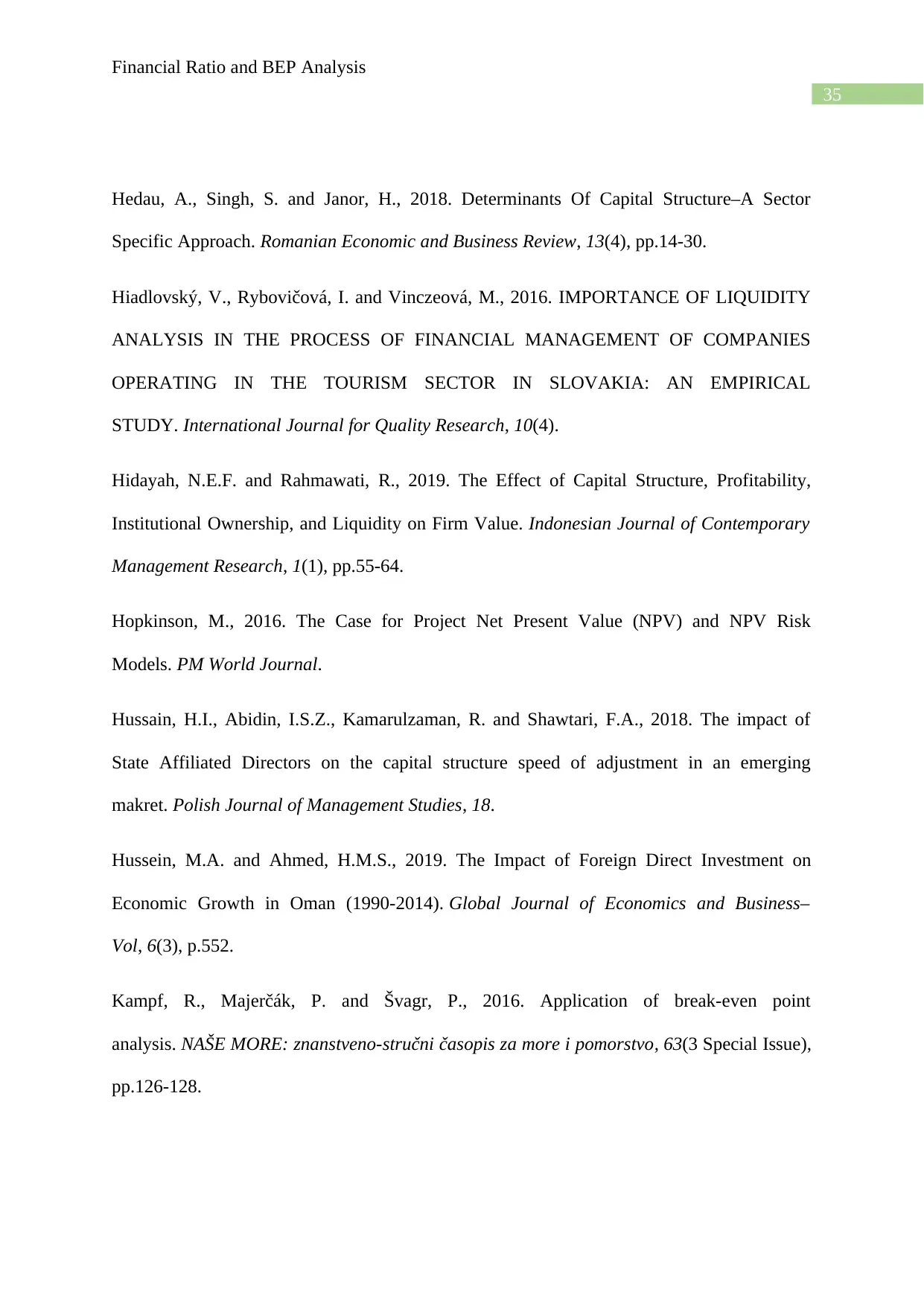
35
Financial Ratio and BEP Analysis
Hedau, A., Singh, S. and Janor, H., 2018. Determinants Of Capital Structure–A Sector
Specific Approach. Romanian Economic and Business Review, 13(4), pp.14-30.
Hiadlovský, V., Rybovičová, I. and Vinczeová, M., 2016. IMPORTANCE OF LIQUIDITY
ANALYSIS IN THE PROCESS OF FINANCIAL MANAGEMENT OF COMPANIES
OPERATING IN THE TOURISM SECTOR IN SLOVAKIA: AN EMPIRICAL
STUDY. International Journal for Quality Research, 10(4).
Hidayah, N.E.F. and Rahmawati, R., 2019. The Effect of Capital Structure, Profitability,
Institutional Ownership, and Liquidity on Firm Value. Indonesian Journal of Contemporary
Management Research, 1(1), pp.55-64.
Hopkinson, M., 2016. The Case for Project Net Present Value (NPV) and NPV Risk
Models. PM World Journal.
Hussain, H.I., Abidin, I.S.Z., Kamarulzaman, R. and Shawtari, F.A., 2018. The impact of
State Affiliated Directors on the capital structure speed of adjustment in an emerging
makret. Polish Journal of Management Studies, 18.
Hussein, M.A. and Ahmed, H.M.S., 2019. The Impact of Foreign Direct Investment on
Economic Growth in Oman (1990-2014). Global Journal of Economics and Business–
Vol, 6(3), p.552.
Kampf, R., Majerčák, P. and Švagr, P., 2016. Application of break-even point
analysis. NAŠE MORE: znanstveno-stručni časopis za more i pomorstvo, 63(3 Special Issue),
pp.126-128.
Financial Ratio and BEP Analysis
Hedau, A., Singh, S. and Janor, H., 2018. Determinants Of Capital Structure–A Sector
Specific Approach. Romanian Economic and Business Review, 13(4), pp.14-30.
Hiadlovský, V., Rybovičová, I. and Vinczeová, M., 2016. IMPORTANCE OF LIQUIDITY
ANALYSIS IN THE PROCESS OF FINANCIAL MANAGEMENT OF COMPANIES
OPERATING IN THE TOURISM SECTOR IN SLOVAKIA: AN EMPIRICAL
STUDY. International Journal for Quality Research, 10(4).
Hidayah, N.E.F. and Rahmawati, R., 2019. The Effect of Capital Structure, Profitability,
Institutional Ownership, and Liquidity on Firm Value. Indonesian Journal of Contemporary
Management Research, 1(1), pp.55-64.
Hopkinson, M., 2016. The Case for Project Net Present Value (NPV) and NPV Risk
Models. PM World Journal.
Hussain, H.I., Abidin, I.S.Z., Kamarulzaman, R. and Shawtari, F.A., 2018. The impact of
State Affiliated Directors on the capital structure speed of adjustment in an emerging
makret. Polish Journal of Management Studies, 18.
Hussein, M.A. and Ahmed, H.M.S., 2019. The Impact of Foreign Direct Investment on
Economic Growth in Oman (1990-2014). Global Journal of Economics and Business–
Vol, 6(3), p.552.
Kampf, R., Majerčák, P. and Švagr, P., 2016. Application of break-even point
analysis. NAŠE MORE: znanstveno-stručni časopis za more i pomorstvo, 63(3 Special Issue),
pp.126-128.
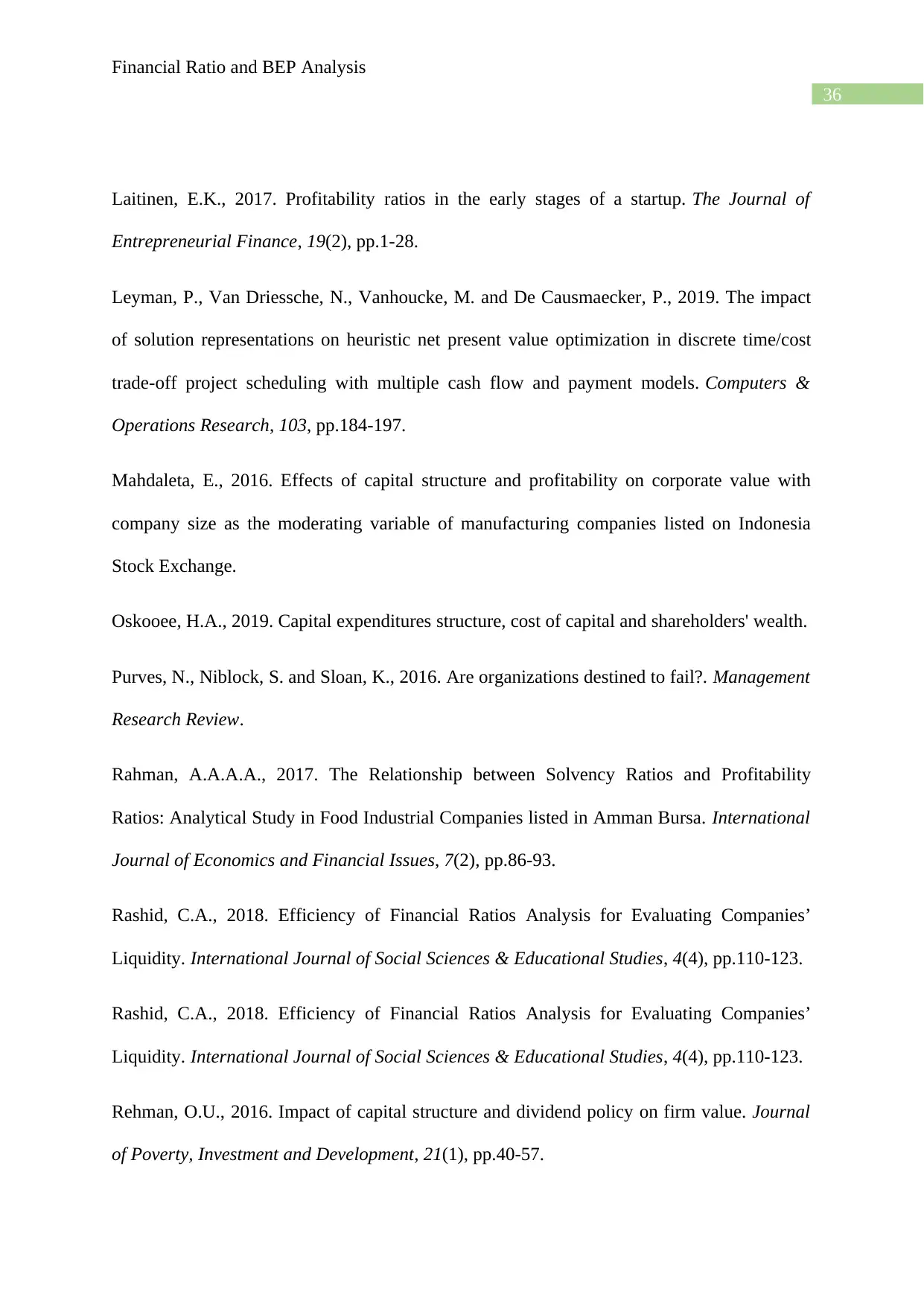
36
Financial Ratio and BEP Analysis
Laitinen, E.K., 2017. Profitability ratios in the early stages of a startup. The Journal of
Entrepreneurial Finance, 19(2), pp.1-28.
Leyman, P., Van Driessche, N., Vanhoucke, M. and De Causmaecker, P., 2019. The impact
of solution representations on heuristic net present value optimization in discrete time/cost
trade-off project scheduling with multiple cash flow and payment models. Computers &
Operations Research, 103, pp.184-197.
Mahdaleta, E., 2016. Effects of capital structure and profitability on corporate value with
company size as the moderating variable of manufacturing companies listed on Indonesia
Stock Exchange.
Oskooee, H.A., 2019. Capital expenditures structure, cost of capital and shareholders' wealth.
Purves, N., Niblock, S. and Sloan, K., 2016. Are organizations destined to fail?. Management
Research Review.
Rahman, A.A.A.A., 2017. The Relationship between Solvency Ratios and Profitability
Ratios: Analytical Study in Food Industrial Companies listed in Amman Bursa. International
Journal of Economics and Financial Issues, 7(2), pp.86-93.
Rashid, C.A., 2018. Efficiency of Financial Ratios Analysis for Evaluating Companies’
Liquidity. International Journal of Social Sciences & Educational Studies, 4(4), pp.110-123.
Rashid, C.A., 2018. Efficiency of Financial Ratios Analysis for Evaluating Companies’
Liquidity. International Journal of Social Sciences & Educational Studies, 4(4), pp.110-123.
Rehman, O.U., 2016. Impact of capital structure and dividend policy on firm value. Journal
of Poverty, Investment and Development, 21(1), pp.40-57.
Financial Ratio and BEP Analysis
Laitinen, E.K., 2017. Profitability ratios in the early stages of a startup. The Journal of
Entrepreneurial Finance, 19(2), pp.1-28.
Leyman, P., Van Driessche, N., Vanhoucke, M. and De Causmaecker, P., 2019. The impact
of solution representations on heuristic net present value optimization in discrete time/cost
trade-off project scheduling with multiple cash flow and payment models. Computers &
Operations Research, 103, pp.184-197.
Mahdaleta, E., 2016. Effects of capital structure and profitability on corporate value with
company size as the moderating variable of manufacturing companies listed on Indonesia
Stock Exchange.
Oskooee, H.A., 2019. Capital expenditures structure, cost of capital and shareholders' wealth.
Purves, N., Niblock, S. and Sloan, K., 2016. Are organizations destined to fail?. Management
Research Review.
Rahman, A.A.A.A., 2017. The Relationship between Solvency Ratios and Profitability
Ratios: Analytical Study in Food Industrial Companies listed in Amman Bursa. International
Journal of Economics and Financial Issues, 7(2), pp.86-93.
Rashid, C.A., 2018. Efficiency of Financial Ratios Analysis for Evaluating Companies’
Liquidity. International Journal of Social Sciences & Educational Studies, 4(4), pp.110-123.
Rashid, C.A., 2018. Efficiency of Financial Ratios Analysis for Evaluating Companies’
Liquidity. International Journal of Social Sciences & Educational Studies, 4(4), pp.110-123.
Rehman, O.U., 2016. Impact of capital structure and dividend policy on firm value. Journal
of Poverty, Investment and Development, 21(1), pp.40-57.
Paraphrase This Document
Need a fresh take? Get an instant paraphrase of this document with our AI Paraphraser
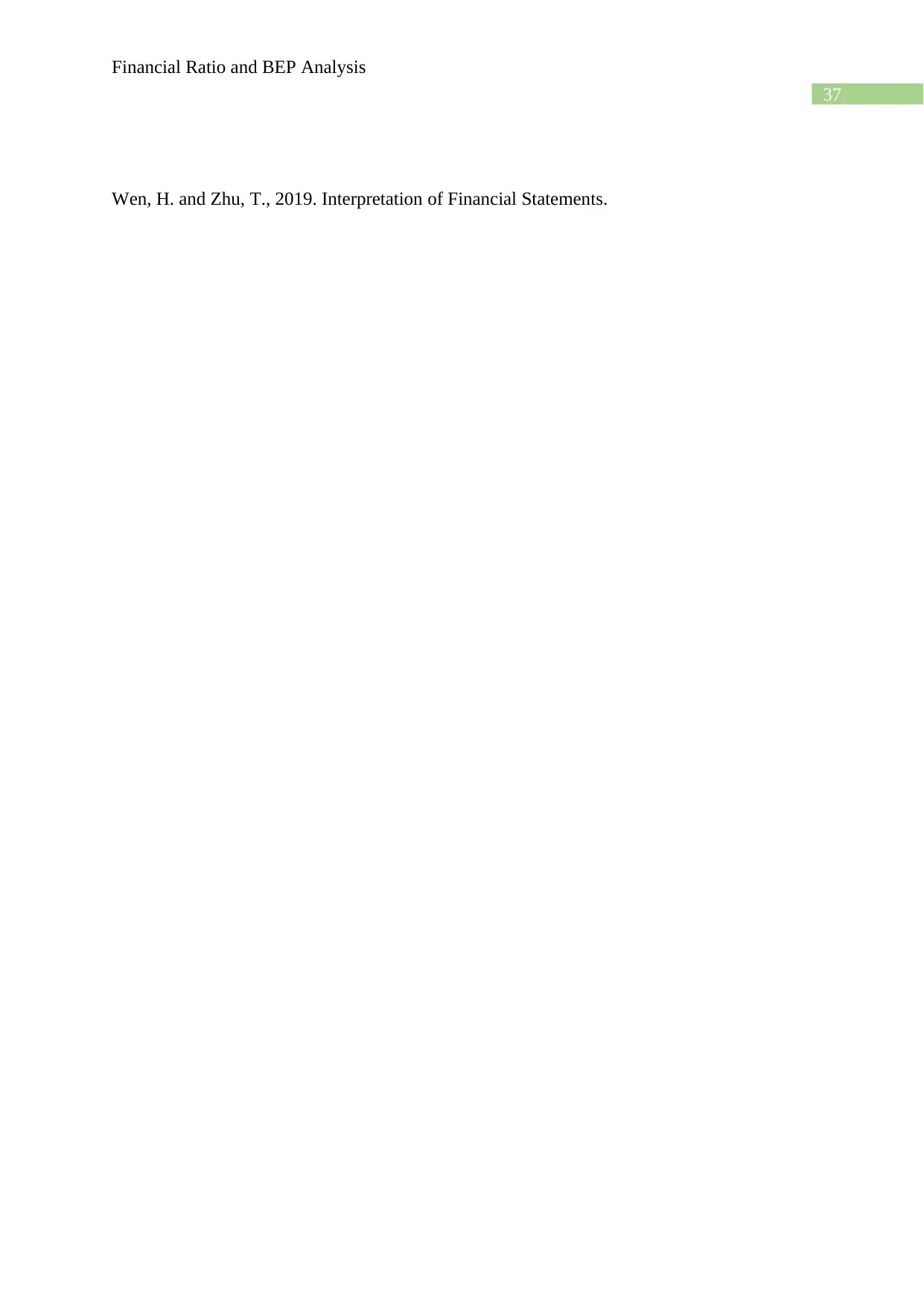
37
Financial Ratio and BEP Analysis
Wen, H. and Zhu, T., 2019. Interpretation of Financial Statements.
Financial Ratio and BEP Analysis
Wen, H. and Zhu, T., 2019. Interpretation of Financial Statements.
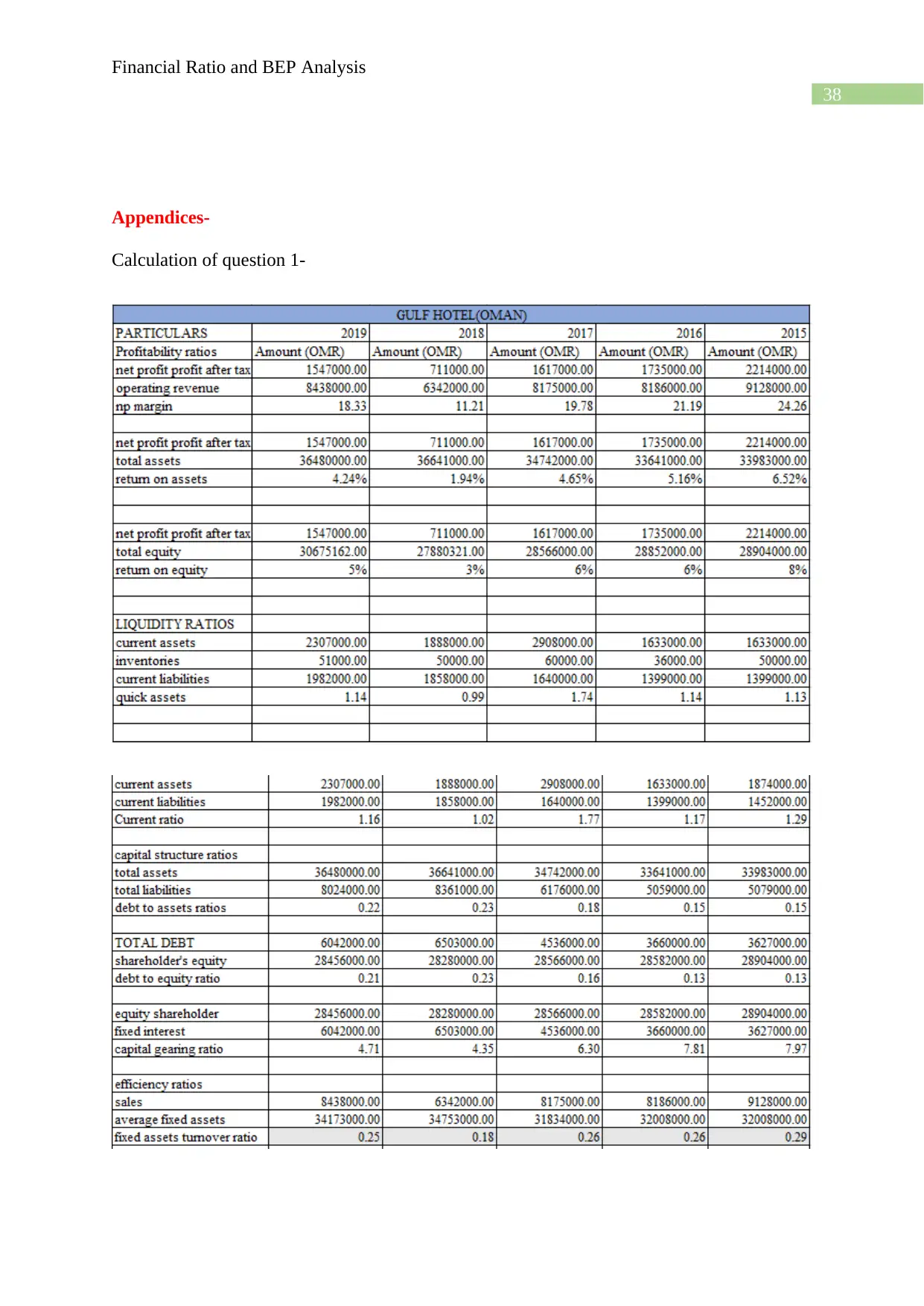
38
Financial Ratio and BEP Analysis
Appendices-
Calculation of question 1-
Financial Ratio and BEP Analysis
Appendices-
Calculation of question 1-
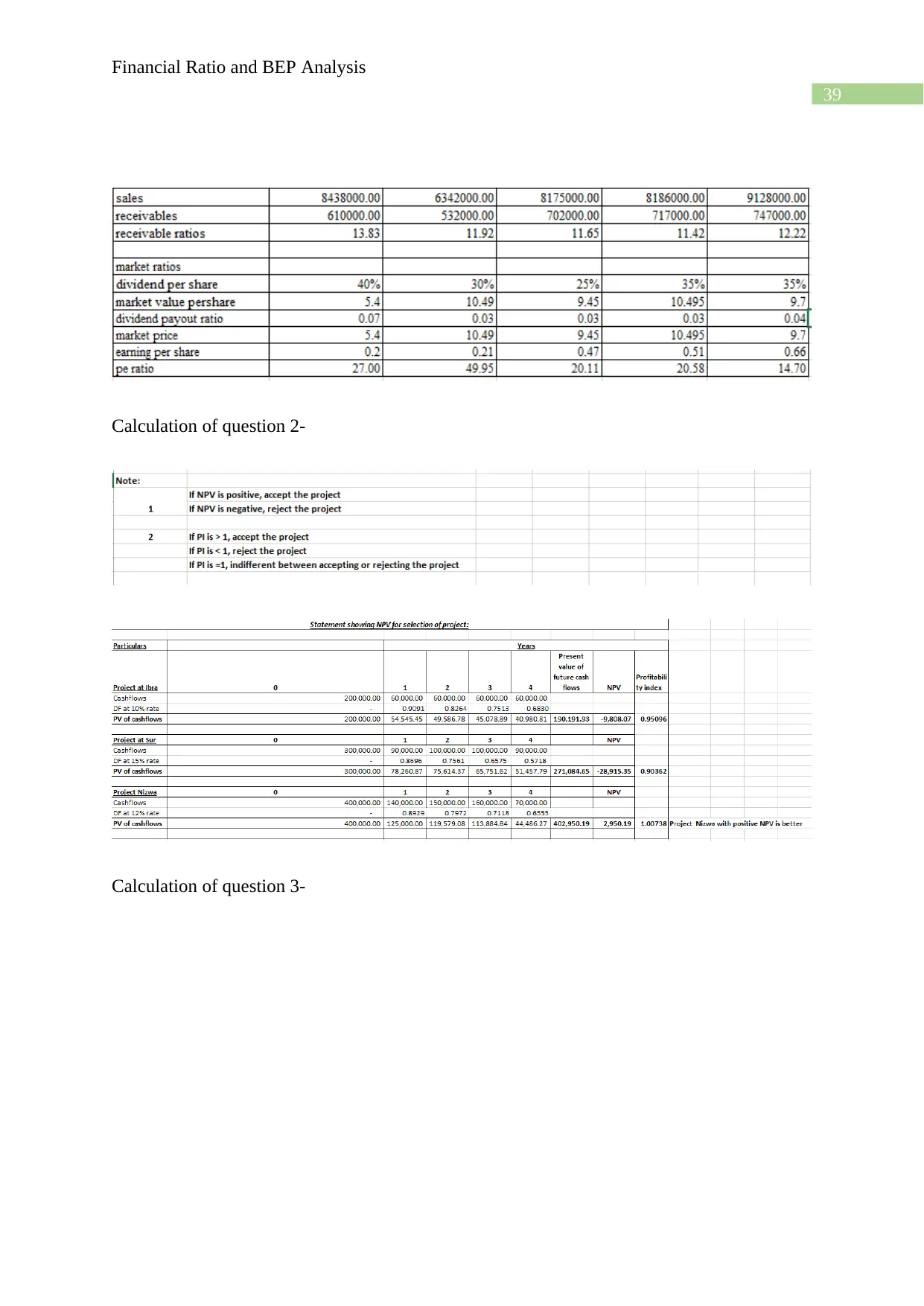
39
Financial Ratio and BEP Analysis
Calculation of question 2-
Calculation of question 3-
Financial Ratio and BEP Analysis
Calculation of question 2-
Calculation of question 3-
1 out of 40
Related Documents
Your All-in-One AI-Powered Toolkit for Academic Success.
+13062052269
info@desklib.com
Available 24*7 on WhatsApp / Email
![[object Object]](/_next/static/media/star-bottom.7253800d.svg)
Unlock your academic potential
© 2024 | Zucol Services PVT LTD | All rights reserved.




